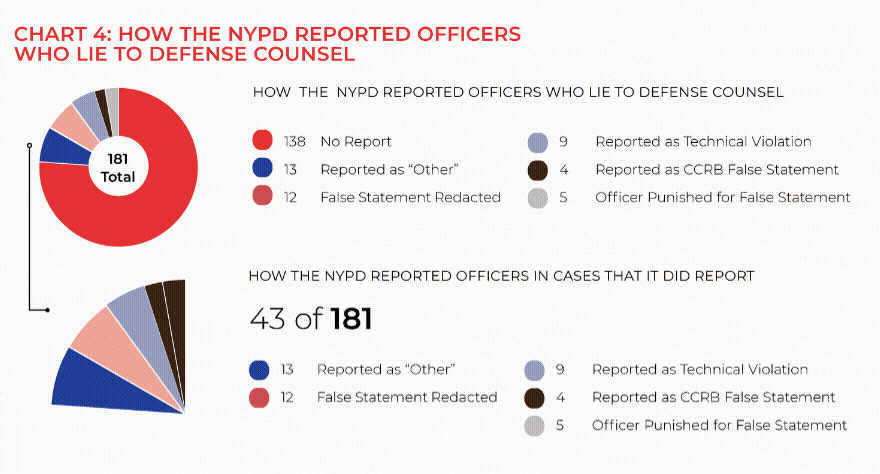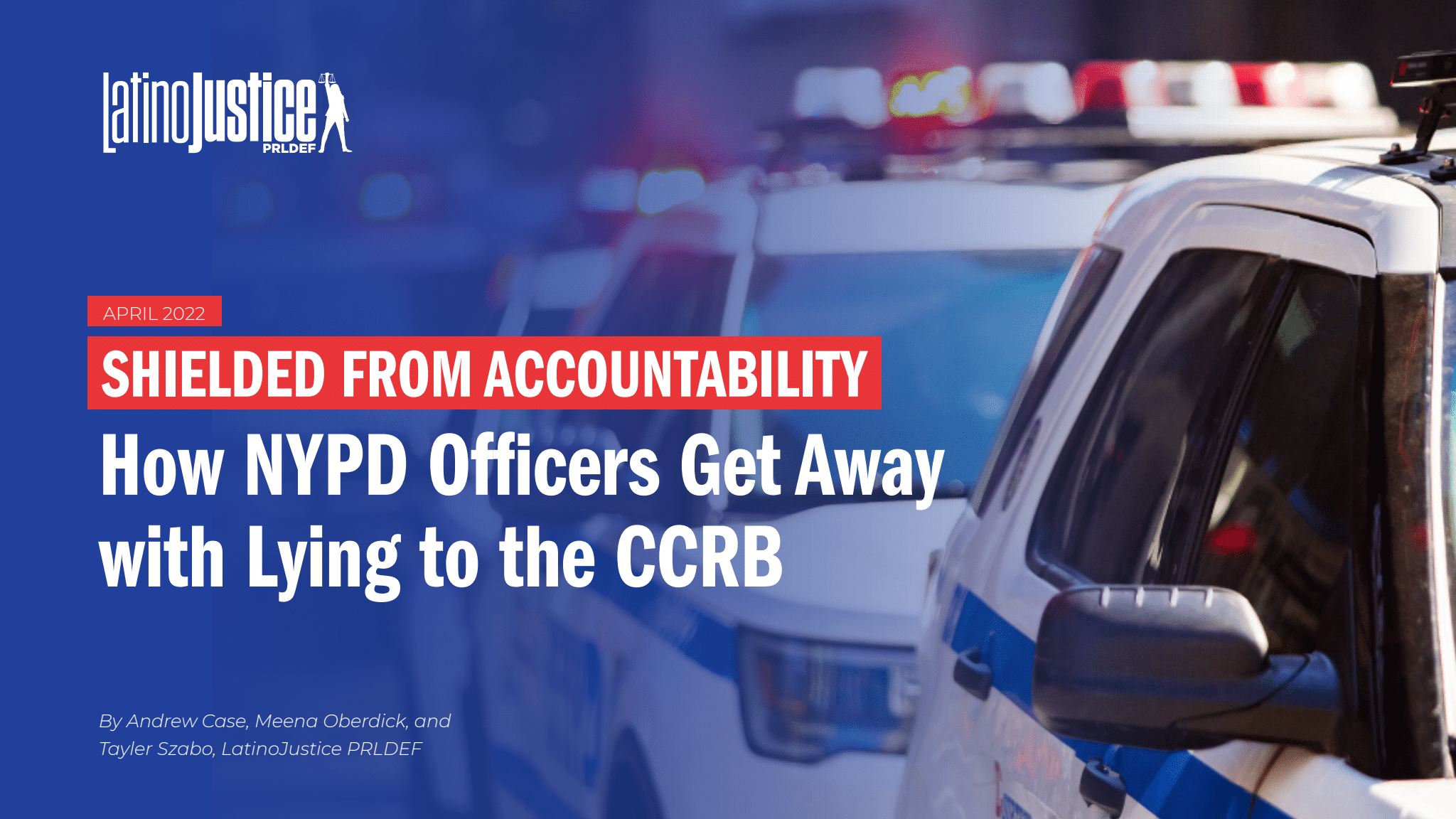Error message
Deprecated function: strpos(): Passing null to parameter #1 ($haystack) of type string is deprecated in
do_shortcode() (line
191 of
modules/gva_blockbuilder/includes/core/shortcode.php).
do_shortcode(NULL) (Line: 67)
Drupal\gavias_blockbuilder\shortcodes\gsc_accordion::sc_accordion(Array) (Line: 54)
Drupal\gavias_blockbuilder\shortcodes\gsc_accordion->render_content(Array) (Line: 85)
include('/home/910783.cloudwaysapps.com/rkdnjtgkgt/public_html/modules/gva_blockbuilder/templates/frontend/print-builder.php') (Line: 92)
gavias_blockbuilder_frontend('W3siYXR0ciI6eyJiZ19pbWFnZSI6IiIsImJnX2NvbG9yIjoiIiwiYmdfcG9zaXRpb24iOiJjZW50ZXIgdG9wIiwiYmdfcmVwZWF0Ijoibm8tcmVwZWF0IiwiYmdfYXR0YWNobWVudCI6InNjcm9sbCIsImJnX3NpemUiOiJjb3ZlciIsImJnX3ZpZGVvIjoiIiwic3R5bGVfc3BhY2UiOiJkZWZhdWx0IiwicGFkZGluZ190b3AiOiIwIiwicGFkZGluZ19ib3R0b20iOiIwIiwibWFyZ2luX3RvcCI6IjAiLCJtYXJnaW5fYm90dG9tIjoiMCIsImxheW91dCI6ImNvbnRhaW5lciIsImVxdWFsX2hlaWdodCI6IiIsImljb24iOiIiLCJjbGFzcyI6IiIsInJvd19pZCI6IiJ9LCJjb2x1bW5zIjp7IjEiOnsiYXR0ciI6eyJzaXplIjoiMTIiLCJ0eXBlIjoiIiwiYmdfaW1hZ2UiOiIiLCJiZ19jb2xvciI6IiIsImJnX3Bvc2l0aW9uIjoiY2VudGVyIHRvcCIsImJnX3JlcGVhdCI6Im5vLXJlcGVhdCIsImJnX2F0dGFjaG1lbnQiOiJzY3JvbGwiLCJiZ19zaXplIjoiY292ZXIiLCJjbGFzcyI6IiIsImNsYXNzX2lubmVyIjoiIiwiY29sdW1uX2lkIjoiIiwiaGlkZGVuX2xnIjoic2hvdyIsImhpZGRlbl9tZCI6InNob3ciLCJoaWRkZW5fc20iOiJzaG93IiwiaGlkZGVuX3hzIjoic2hvdyJ9LCJpdGVtcyI6W3sidHlwZSI6ImdzY19kcnVwYWxfYmxvY2siLCJzaXplIjoxMiwiZmllbGRzIjp7InRpdGxlIjoiIiwiYmxvY2tfZHJ1cGFsIjoiZ2F2aWFzc2xpZGVybGF5ZXJjY3JiX3NsaWRlciIsImhpZGRlbl90aXRsZSI6Im9uIiwiYWxpZ25fdGl0bGUiOiJ0aXRsZS1hbGlnbi1sZWZ0IiwicmVtb3ZlX21hcmdpbiI6Im9uIiwic3R5bGVfdGV4dCI6InRleHQtZGFyayIsImVsX2NsYXNzIjoiIiwiYW5pbWF0ZSI6IiJ9fV19LCIyIjp7ImF0dHIiOnsic2l6ZSI6IjEyIiwidHlwZSI6IiIsImJnX2ltYWdlIjoiIiwiYmdfY29sb3IiOiIiLCJiZ19wb3NpdGlvbiI6ImNlbnRlciB0b3AiLCJiZ19yZXBlYXQiOiJuby1yZXBlYXQiLCJiZ19hdHRhY2htZW50Ijoic2Nyb2xsIiwiYmdfc2l6ZSI6ImNvdmVyIiwiY2xhc3MiOiIiLCJjbGFzc19pbm5lciI6IiIsImNvbHVtbl9pZCI6IiIsImhpZGRlbl9sZyI6InNob3ciLCJoaWRkZW5fbWQiOiJzaG93IiwiaGlkZGVuX3NtIjoic2hvdyIsImhpZGRlbl94cyI6InNob3cifSwiaXRlbXMiOlt7InR5cGUiOiJnc2NfYWNjb3JkaW9uIiwic2l6ZSI6MTIsImZpZWxkcyI6eyJ0aXRsZSI6IiIsInN0eWxlIjoic2tpbi13aGl0ZSIsImNvdW50IjoiOCIsInRhYnMiOlt7Imljb24iOiIiLCJ0aXRsZSI6IkV4ZWN1dGl2ZSBTdW1tYXJ5IiwiY29udGVudCI6IjxwIGRpcj1cImx0clwiIHN0eWxlPVwibGluZS1oZWlnaHQ6IDEuMjsgdGV4dC1hbGlnbjoganVzdGlmeTsgbWFyZ2luLXRvcDogMHB0OyBtYXJnaW4tYm90dG9tOiAxMnB0O1wiPjxzcGFuIHN0eWxlPVwiZm9udC1zaXplOiAxMnB0OyBmb250LWZhbWlseTogR2FyYW1vbmQsc2VyaWY7IGNvbG9yOiAjMDAwMDAwOyBiYWNrZ3JvdW5kLWNvbG9yOiB0cmFuc3BhcmVudDsgZm9udC13ZWlnaHQ6IDQwMDsgZm9udC1zdHlsZTogbm9ybWFsOyBmb250LXZhcmlhbnQ6IG5vcm1hbDsgdGV4dC1kZWNvcmF0aW9uOiBub25lOyB2ZXJ0aWNhbC1hbGlnbjogYmFzZWxpbmU7IHdoaXRlLXNwYWNlOiBwcmUtd3JhcDtcIj48aW1nIHN0eWxlPVwibWFyZ2luLWxlZnQ6IDE1cHg7IG1hcmdpbi1yaWdodDogMTVweDsgd2lkdGg6IDQwMHB4OyBoZWlnaHQ6IDIwMHB4OyBmbG9hdDogcmlnaHQ7XCIgc3JjPVwiLi5cLy4uXC8uLlwvLi5cLy4uXC9zaXRlc1wvZGVmYXVsdFwvZmlsZXNcLzIwMjItMDRcLzMxLnBuZ1wiIGFsdD1cIkZhbmVlemEgTGF0Y2hhbmFcIiBcLz5PbiBKYW51YXJ5IDI4LCAyMDIyLCBhZnRlciBhIHNpeHRlZW4teWVhci1vbGQgYm95IGhhZCBwb3N0ZWQgYmFpbCBpbiBhIGd1biBjYXNlLCB0aGUgbWF5b3Igb2YgTmV3IFlvcmsgc3RhdGVkIHRoYXQgJmxkcXVvO05ldyBZb3JrZXJzIHNob3VsZCBhbGwgYmUgb3V0cmFnZWQmcmRxdW87IHRoYXQgaGUgd2FzIGFsbG93ZWQgdG8gYXdhaXQgdHJpYWwgYXQgaG9tZSBpbnN0ZWFkIG9mIGF0IFJpa2VycyBJc2xhbmQuIFBvbGljZSBoYWQgY2xhaW1lZCB0aGF0IHRoZSBib3kgaGFkIHJlZnVzZWQgdGhlaXIgY29tbWFuZHMsIGhpZGRlbiBoaXMgaGFuZHMsIGFuZCBmaXJlZCBhIHdlYXBvbiBhdCBhIHBvbGljZSBvZmZpY2VyLiBVcG9uIHJldmlld2luZyB0aGUgYm9keS13b3JuIGNhbWVyYSBmb290YWdlIGEgbGl0dGxlIG1vcmUgdGhhbiBhIG1vbnRoIGxhdGVyLCBhIEJyb254IENyaW1pbmFsIENvdXJ0IGp1ZGdlIHdhcyBhbHNvIG91dHJhZ2VkJm1kYXNoO2J1dCBub3QgZm9yIHRoZSByZWFzb25zIHRoZSBtYXlvciBzdWdnZXN0ZWQuPFwvc3Bhbj48XC9wPlxyXG48cCBkaXI9XCJsdHJcIiBzdHlsZT1cImxpbmUtaGVpZ2h0OiAxLjI7IHRleHQtYWxpZ246IGp1c3RpZnk7IG1hcmdpbi10b3A6IDBwdDsgbWFyZ2luLWJvdHRvbTogMTJwdDtcIj48c3BhbiBzdHlsZT1cImZvbnQtc2l6ZTogMTJwdDsgZm9udC1mYW1pbHk6IEdhcmFtb25kLHNlcmlmOyBjb2xvcjogIzAwMDAwMDsgYmFja2dyb3VuZC1jb2xvcjogdHJhbnNwYXJlbnQ7IGZvbnQtd2VpZ2h0OiA0MDA7IGZvbnQtc3R5bGU6IG5vcm1hbDsgZm9udC12YXJpYW50OiBub3JtYWw7IHRleHQtZGVjb3JhdGlvbjogbm9uZTsgdmVydGljYWwtYWxpZ246IGJhc2VsaW5lOyB3aGl0ZS1zcGFjZTogcHJlLXdyYXA7XCI+SW5zdGVhZCwgdGhlIGNvdXJ0IG5vdGVkIHRoYXQgdGhlIHZpZGVvIHNob3dlZCB0aGVyZSB3YXMgbm8gbGVnaXRpbWF0ZSByZWFzb24gZm9yIHRoZSBvZmZpY2VycyB0byBzdG9wIHRoZSBib3ksIHRoYXQgaGUgaGFkIGNvbXBsaWVkIHdpdGggYWxsIHRoZWlyIGNvbW1hbmRzLCBhbmQgdGhhdCB0aGUgd2VhcG9uIGhhZCBnb25lIG9mZiBkdXJpbmcgYW4gaWxsZWdhbCBzZWFyY2guIFNoZSBjYWxsZWQgdGhlIG9mZmljZXImcnNxdW87cyB0ZXN0aW1vbnkgJmxkcXVvO2luY3JlZGlibGUgYW5kIHVucmVsaWFibGUuJnJkcXVvOyBEZXNwaXRlIHRoZSB2aWRlbyBldmlkZW5jZSBhbmQgdGhlIGNvdXJ0JnJzcXVvO3MgZmluZGluZ3MsIHdoZW4gYXNrZWQgYWJvdXQgdGhlIGNhc2UgYnkgYSBjaXR5IGNvdW5jaWxtZW1iZXIsIFBvbGljZSBDb21taXNzaW9uZXIgS2VlY2hhbnQgU2V3ZWxsIHN0YXRlZCB0aGF0ICZsZHF1bztXZSBzZWUgdGhhdCBpbmNpZGVudCBkaWZmZXJlbnRseS4mcmRxdW87IFRoZSBtYXlvciBoYXMgY29udGludWVkIHRvIGRlZmVuZCB0aGUgb2ZmaWNlcnMgZXZlbiB0aG91Z2ggYSBqdWRnZSBmb3VuZCB0aGV5IGxpZWQgb24gdGhlIHN0YW5kLjxcL3NwYW4+PFwvcD5cclxuPHAgZGlyPVwibHRyXCIgc3R5bGU9XCJsaW5lLWhlaWdodDogMS4yOyB0ZXh0LWFsaWduOiBqdXN0aWZ5OyBtYXJnaW4tdG9wOiAwcHQ7IG1hcmdpbi1ib3R0b206IDEycHQ7XCI+PHNwYW4gc3R5bGU9XCJmb250LXNpemU6IDEycHQ7IGZvbnQtZmFtaWx5OiBHYXJhbW9uZCxzZXJpZjsgY29sb3I6ICMwMDAwMDA7IGJhY2tncm91bmQtY29sb3I6IHRyYW5zcGFyZW50OyBmb250LXdlaWdodDogNDAwOyBmb250LXN0eWxlOiBub3JtYWw7IGZvbnQtdmFyaWFudDogbm9ybWFsOyB0ZXh0LWRlY29yYXRpb246IG5vbmU7IHZlcnRpY2FsLWFsaWduOiBiYXNlbGluZTsgd2hpdGUtc3BhY2U6IHByZS13cmFwO1wiPk9uIHBhcGVyLCB0aGUgcG9saWN5IG9mIHRoZSBOZXcgWW9yayBQb2xpY2UgRGVwYXJ0bWVudCAoTllQRCkgaXMgdGhhdCAmbGRxdW87W2ldbnRlbnRpb25hbGx5IG1ha2luZyBhIGZhbHNlIG9mZmljaWFsIHN0YXRlbWVudCByZWdhcmRpbmcgYSBtYXRlcmlhbCBtYXR0ZXIgd2lsbCByZXN1bHQgaW4gZGlzbWlzc2FsIGZyb20gdGhlIERlcGFydG1lbnQsIGFic2VudCBleGNlcHRpb25hbCBjaXJjdW1zdGFuY2VzLiZyZHF1bzsgQnV0IGl0IGhhcyBsb25nIGJlZW4gYW4gb3BlbiBzZWNyZXQgdGhhdCB0aGUgTllQRCBhbG1vc3QgbmV2ZXIgZGlzY2lwbGluZXMgb2ZmaWNlcnMgd2hvIGxpZSwgcGFydGljdWxhcmx5IGluIHRob3NlIGNhc2VzIHdoZXJlIG9mZmljZXJzIGxpZSBkdXJpbmcgYW4gaW50ZXJ2aWV3IGJlZm9yZSB0aGUgQ2l2aWxpYW4gQ29tcGxhaW50IFJldmlldyBCb2FyZCAoQ0NSQikuPFwvc3Bhbj48XC9wPlxyXG48cCBkaXI9XCJsdHJcIiBzdHlsZT1cImxpbmUtaGVpZ2h0OiAxLjI7IHRleHQtYWxpZ246IGp1c3RpZnk7IG1hcmdpbi10b3A6IDBwdDsgbWFyZ2luLWJvdHRvbTogMTJwdDtcIj48c3BhbiBzdHlsZT1cImZvbnQtc2l6ZTogMTJwdDsgZm9udC1mYW1pbHk6IEdhcmFtb25kLHNlcmlmOyBjb2xvcjogIzAwMDAwMDsgYmFja2dyb3VuZC1jb2xvcjogdHJhbnNwYXJlbnQ7IGZvbnQtd2VpZ2h0OiA0MDA7IGZvbnQtc3R5bGU6IG5vcm1hbDsgZm9udC12YXJpYW50OiBub3JtYWw7IHRleHQtZGVjb3JhdGlvbjogbm9uZTsgdmVydGljYWwtYWxpZ246IGJhc2VsaW5lOyB3aGl0ZS1zcGFjZTogcHJlLXdyYXA7XCI+VGhlIE5ZUEQgaGFzIHB1YmxpY2x5IGRlZmVuZGVkIGl0cyByZWZ1c2FsIHRvIGRpc2NpcGxpbmUgdGhlc2Ugb2ZmaWNlcnMgYnkgY2xhaW1pbmcgdGhhdCB0aGUgQ0NSQiBmb3J3YXJkZWQgc2hvZGR5IGludmVzdGlnYXRpb25zIGFuZCBhY3RlZCB3aXRoIGJpYXMuIE5ldyBZb3JrIENpdmlsIFJpZ2h0cyBMYXcgNTAtYSZuZGFzaDt3aGljaCBoYXMgc2luY2UgYmVlbiByZXBlYWxlZCZuZGFzaDtzaGllbGRlZCB0aGVzZSBjYXNlcyBmcm9tIGRpc2Nsb3N1cmUsIG1ha2luZyBpdCBpbXBvc3NpYmxlIHRvIGluZGVwZW5kZW50bHkgcmVmdXRlIHRoZSBOWVBEJnJzcXVvO3MgY2xhaW1zLjxcL3NwYW4+PFwvcD5cclxuPHAgZGlyPVwibHRyXCIgc3R5bGU9XCJsaW5lLWhlaWdodDogMS4yOyB0ZXh0LWFsaWduOiBqdXN0aWZ5OyBtYXJnaW4tdG9wOiAwcHQ7IG1hcmdpbi1ib3R0b206IDEycHQ7XCI+PHNwYW4gc3R5bGU9XCJmb250LXNpemU6IDEycHQ7IGZvbnQtZmFtaWx5OiBHYXJhbW9uZCxzZXJpZjsgY29sb3I6ICMwMDAwMDA7IGJhY2tncm91bmQtY29sb3I6IHRyYW5zcGFyZW50OyBmb250LXdlaWdodDogNDAwOyBmb250LXN0eWxlOiBub3JtYWw7IGZvbnQtdmFyaWFudDogbm9ybWFsOyB0ZXh0LWRlY29yYXRpb246IG5vbmU7IHZlcnRpY2FsLWFsaWduOiBiYXNlbGluZTsgd2hpdGUtc3BhY2U6IHByZS13cmFwO1wiPldpdGggdGhlIHJlcGVhbCBvZiA1MC1hLCBMYXRpbm9KdXN0aWNlIFBSTERFRiBoYXMgYmVlbiBhYmxlIHRvIG9idGFpbiB0aGUgZnVsbCBjYXNlIGZpbGVzLCBpbnRlcnZpZXcgc3RhdGVtZW50cywgb3IgYm90aCwgaW4gdGhlIDE0NCBjYXNlcyBpbnZvbHZpbmcgMTgxIG9mZmljZXJzIHdobyBsaWVkIHRvIHRoZSBDQ1JCLiBUaGUgcmVzdWx0cyBzaG93IHRoYXQgdGhlIE5ZUEQgaGFzIHV0dGVybHkgZmFpbGVkIHRvIHRha2UgbHlpbmcgYnkgb2ZmaWNlcnMgc2VyaW91c2x5LCByZWZ1c2luZyB0byBkaXNjaXBsaW5lIG9mZmljZXJzIGluIHRoZSBmYWNlIG9mIGluY29udHJvdmVydGlibGUgZXZpZGVuY2UgdGhhdCB0aGV5IGxpZWQuIFdlIGZvdW5kIHRoYXQ6PFwvc3Bhbj48XC9wPlxyXG48dWw+XHJcbjxsaSBkaXI9XCJsdHJcIiBzdHlsZT1cImxpbmUtaGVpZ2h0OiAxLjI7IHRleHQtYWxpZ246IGp1c3RpZnk7IG1hcmdpbi10b3A6IDBwdDsgbWFyZ2luLWJvdHRvbTogMTJwdDtcIj5cclxuPHAgZGlyPVwibHRyXCIgc3R5bGU9XCJsaW5lLWhlaWdodDogMS4yOyBtYXJnaW4tdG9wOiAxMnB0OyBtYXJnaW4tYm90dG9tOiAwcHQ7XCI+PHNwYW4gc3R5bGU9XCJmb250LXNpemU6IDEycHQ7IGZvbnQtZmFtaWx5OiBHYXJhbW9uZCxzZXJpZjsgY29sb3I6ICMwMDAwMDA7IGJhY2tncm91bmQtY29sb3I6IHRyYW5zcGFyZW50OyBmb250LXdlaWdodDogNDAwOyBmb250LXN0eWxlOiBub3JtYWw7IGZvbnQtdmFyaWFudDogbm9ybWFsOyB0ZXh0LWRlY29yYXRpb246IG5vbmU7IHZlcnRpY2FsLWFsaWduOiBiYXNlbGluZTsgd2hpdGUtc3BhY2U6IHByZS13cmFwO1wiPkluIG1vcmUgdGhhbiBvbmUtaGFsZiB0aGUgY2FzZXMgdGhlIENDUkIgZm9yd2FyZGVkIHRvIHRoZSBOWVBELCBhbiBvZmZpY2VyJnJzcXVvO3MgdGVzdGltb255IHdhcyBjb250cmFkaWN0ZWQgYnkgcmVjb3JkZWQgdmlkZW8gb3IgYXVkaW8gZXZpZGVuY2UuPFwvc3Bhbj48XC9wPlxyXG48XC9saT5cclxuPGxpIGRpcj1cImx0clwiIHN0eWxlPVwibGluZS1oZWlnaHQ6IDEuMjsgdGV4dC1hbGlnbjoganVzdGlmeTsgbWFyZ2luLXRvcDogMHB0OyBtYXJnaW4tYm90dG9tOiAxMnB0O1wiPlxyXG48cCBkaXI9XCJsdHJcIiBzdHlsZT1cImxpbmUtaGVpZ2h0OiAxLjI7IG1hcmdpbi10b3A6IDBwdDsgbWFyZ2luLWJvdHRvbTogMHB0O1wiPjxzcGFuIHN0eWxlPVwiZm9udC1zaXplOiAxMnB0OyBmb250LWZhbWlseTogR2FyYW1vbmQsc2VyaWY7IGNvbG9yOiAjMDAwMDAwOyBiYWNrZ3JvdW5kLWNvbG9yOiB0cmFuc3BhcmVudDsgZm9udC13ZWlnaHQ6IDQwMDsgZm9udC1zdHlsZTogbm9ybWFsOyBmb250LXZhcmlhbnQ6IG5vcm1hbDsgdGV4dC1kZWNvcmF0aW9uOiBub25lOyB2ZXJ0aWNhbC1hbGlnbjogYmFzZWxpbmU7IHdoaXRlLXNwYWNlOiBwcmUtd3JhcDtcIj5JbiBtb3N0IG9mIHRoZSByZW1haW5pbmcgY2FzZXMsIHRoZSBvZmZpY2VyJnJzcXVvO3Mgc3RhdGVtZW50IHdhcyBjb250cmFkaWN0ZWQgYnkgTllQRCBwYXBlcndvcmsgb3IgdGhlIHRlc3RpbW9ueSBvZiBhbm90aGVyIE5ZUEQgb2ZmaWNlci48XC9zcGFuPjxcL3A+XHJcbjxcL2xpPlxyXG48bGkgZGlyPVwibHRyXCIgc3R5bGU9XCJsaW5lLWhlaWdodDogMS4yOyB0ZXh0LWFsaWduOiBqdXN0aWZ5OyBtYXJnaW4tdG9wOiAwcHQ7IG1hcmdpbi1ib3R0b206IDEycHQ7XCI+XHJcbjxwIGRpcj1cImx0clwiIHN0eWxlPVwibGluZS1oZWlnaHQ6IDEuMjsgbWFyZ2luLXRvcDogMHB0OyBtYXJnaW4tYm90dG9tOiAwcHQ7XCI+PHNwYW4gc3R5bGU9XCJmb250LXNpemU6IDEycHQ7IGZvbnQtZmFtaWx5OiBHYXJhbW9uZCxzZXJpZjsgY29sb3I6ICMwMDAwMDA7IGJhY2tncm91bmQtY29sb3I6IHRyYW5zcGFyZW50OyBmb250LXdlaWdodDogNDAwOyBmb250LXN0eWxlOiBub3JtYWw7IGZvbnQtdmFyaWFudDogbm9ybWFsOyB0ZXh0LWRlY29yYXRpb246IG5vbmU7IHZlcnRpY2FsLWFsaWduOiBiYXNlbGluZTsgd2hpdGUtc3BhY2U6IHByZS13cmFwO1wiPk5lYXJseSBvbmUtaGFsZiBvZiB0aGUgb2ZmaWNlcnMgd2hvIGxpZWQgdG8gdGhlIENDUkIgd2VyZSBuZXZlciBkaXNjaXBsaW5lZCBhdCBhbGwsIGV2ZW4gZm9yIHRoZSB1bmRlcmx5aW5nIG1pc2NvbmR1Y3QgdGhleSBsaWVkIGFib3V0LjxcL3NwYW4+PFwvcD5cclxuPFwvbGk+XHJcbjxsaSBkaXI9XCJsdHJcIiBzdHlsZT1cImxpbmUtaGVpZ2h0OiAxLjI7IHRleHQtYWxpZ246IGp1c3RpZnk7IG1hcmdpbi10b3A6IDBwdDsgbWFyZ2luLWJvdHRvbTogMTJwdDtcIj5cclxuPHAgZGlyPVwibHRyXCIgc3R5bGU9XCJsaW5lLWhlaWdodDogMS4yOyBtYXJnaW4tdG9wOiAwcHQ7IG1hcmdpbi1ib3R0b206IDBwdDtcIj48c3BhbiBzdHlsZT1cImZvbnQtc2l6ZTogMTJwdDsgZm9udC1mYW1pbHk6IEdhcmFtb25kLHNlcmlmOyBjb2xvcjogIzAwMDAwMDsgYmFja2dyb3VuZC1jb2xvcjogdHJhbnNwYXJlbnQ7IGZvbnQtd2VpZ2h0OiA0MDA7IGZvbnQtc3R5bGU6IG5vcm1hbDsgZm9udC12YXJpYW50OiBub3JtYWw7IHRleHQtZGVjb3JhdGlvbjogbm9uZTsgdmVydGljYWwtYWxpZ246IGJhc2VsaW5lOyB3aGl0ZS1zcGFjZTogcHJlLXdyYXA7XCI+SW4gdGhlIGZpdmUgY2FzZXMgaW4gd2hpY2ggdGhlIE5ZUEQgZGlzY2lwbGluZWQgdGhlIG9mZmljZXIgZm9yIHRoZSBzdGF0ZW1lbnQgbWFkZSB0byB0aGUgQ0NSQiwgdGhlIGFsbGVnYXRpb24gd2FzIGRvd25ncmFkZWQgdG8gJmxkcXVvO21pc2xlYWRpbmcuJnJkcXVvOyBObyBvZmZpY2VyIHdhcyBmaXJlZC48XC9zcGFuPjxcL3A+XHJcbjxcL2xpPlxyXG48bGkgZGlyPVwibHRyXCIgc3R5bGU9XCJsaW5lLWhlaWdodDogMS4yOyB0ZXh0LWFsaWduOiBqdXN0aWZ5OyBtYXJnaW4tdG9wOiAwcHQ7IG1hcmdpbi1ib3R0b206IDEycHQ7XCI+XHJcbjxwIGRpcj1cImx0clwiIHN0eWxlPVwibGluZS1oZWlnaHQ6IDEuMjsgbWFyZ2luLXRvcDogMHB0OyBtYXJnaW4tYm90dG9tOiAxMnB0O1wiPjxzcGFuIHN0eWxlPVwiZm9udC1zaXplOiAxMnB0OyBmb250LWZhbWlseTogR2FyYW1vbmQsc2VyaWY7IGNvbG9yOiAjMDAwMDAwOyBiYWNrZ3JvdW5kLWNvbG9yOiB0cmFuc3BhcmVudDsgZm9udC13ZWlnaHQ6IDQwMDsgZm9udC1zdHlsZTogbm9ybWFsOyBmb250LXZhcmlhbnQ6IG5vcm1hbDsgdGV4dC1kZWNvcmF0aW9uOiBub25lOyB2ZXJ0aWNhbC1hbGlnbjogYmFzZWxpbmU7IHdoaXRlLXNwYWNlOiBwcmUtd3JhcDtcIj5UaGUgTllQRCBoYXMgcHJvdmlkZWQgaW5hZGVxdWF0ZSBpbmZvcm1hdGlvbiBhYm91dCBvZmZpY2VycyB3aG8gbGllIHRvIGNyaW1pbmFsIGRlZmVuZGFudHMgYW5kIHRoZWlyIGF0dG9ybmV5cy48XC9zcGFuPjxcL3A+XHJcbjxcL2xpPlxyXG48XC91bD5cclxuPHAgZGlyPVwibHRyXCIgc3R5bGU9XCJsaW5lLWhlaWdodDogMS4yOyB0ZXh0LWFsaWduOiBqdXN0aWZ5OyBtYXJnaW4tdG9wOiAwcHQ7IG1hcmdpbi1ib3R0b206IDEycHQ7XCI+PHNwYW4gc3R5bGU9XCJmb250LXNpemU6IDEycHQ7IGZvbnQtZmFtaWx5OiBHYXJhbW9uZCxzZXJpZjsgY29sb3I6ICMwMDAwMDA7IGJhY2tncm91bmQtY29sb3I6IHRyYW5zcGFyZW50OyBmb250LXdlaWdodDogNDAwOyBmb250LXN0eWxlOiBub3JtYWw7IGZvbnQtdmFyaWFudDogbm9ybWFsOyB0ZXh0LWRlY29yYXRpb246IG5vbmU7IHZlcnRpY2FsLWFsaWduOiBiYXNlbGluZTsgd2hpdGUtc3BhY2U6IHByZS13cmFwO1wiPlRoZSBOWVBEJnJzcXVvO3MgcmVmdXNhbCB0byBhY3Qgd2hlbiBpdHMgb2ZmaWNlcnMgbGllIGhhcyBzZXJpb3VzIHJhbWlmaWNhdGlvbnMuIE9mZmljZXJzIHdobyByZWNlaXZlIG5vIGNvbnNlcXVlbmNlcyBmb3IgbHlpbmcgd2lsbCBjb250aW51ZSB0byBkbyBzby4gSW5kaXZpZHVhbHMgd2hvIGFyZSBuZXZlciB0b2xkIHRoYXQgYW4gb2ZmaWNlciB0ZXN0aWZ5aW5nIGFnYWluc3QgdGhlbSBpcyBrbm93biBhcyBhIGxpYXIgY2Fubm90IHJlY2VpdmUgZmFpciB0cmlhbHMuPFwvc3Bhbj48XC9wPlxyXG48cCBkaXI9XCJsdHJcIiBzdHlsZT1cImxpbmUtaGVpZ2h0OiAxLjI7IHRleHQtYWxpZ246IGp1c3RpZnk7IG1hcmdpbi10b3A6IDBwdDsgbWFyZ2luLWJvdHRvbTogMTJwdDtcIj48c3BhbiBzdHlsZT1cImZvbnQtc2l6ZTogMTJwdDsgZm9udC1mYW1pbHk6IEdhcmFtb25kLHNlcmlmOyBjb2xvcjogIzAwMDAwMDsgYmFja2dyb3VuZC1jb2xvcjogdHJhbnNwYXJlbnQ7IGZvbnQtd2VpZ2h0OiA0MDA7IGZvbnQtc3R5bGU6IG5vcm1hbDsgZm9udC12YXJpYW50OiBub3JtYWw7IHRleHQtZGVjb3JhdGlvbjogbm9uZTsgdmVydGljYWwtYWxpZ246IGJhc2VsaW5lOyB3aGl0ZS1zcGFjZTogcHJlLXdyYXA7XCI+TGF0aW5vSnVzdGljZSBwcm9wb3NlcyBwb2xpY3kgY2hhbmdlcyB0byB0aGUgTllQRCwgdGhlIE5ldyBZb3JrIENpdHkgQ291bmNpbCwgYW5kIHRoZSBOZXcgWW9yayBTdGF0ZSBMZWdpc2xhdHVyZSZtZGFzaDtpbmNsdWRpbmcgcmVjb21tZW5kYXRpb25zIHJlZ2FyZGluZyBkaXNjaXBsaW5lIGFuZCBkaXNjaXBsaW5hcnkgYXV0aG9yaXR5Jm1kYXNoO3RvIGVuc3VyZSB0aGF0IHBvbGljZSBhcmUgaGVsZCBhY2NvdW50YWJsZSBmb3IgbHlpbmcsIGFuZCB0byBwcm90ZWN0IHRoZSBwdWJsaWMgZnJvbSBmdXJ0aGVyIGFidXNlLjxcL3NwYW4+PFwvcD4ifSx7Imljb24iOiIiLCJ0aXRsZSI6IkZhbHNlIE9mZmljaWFsIFN0YXRlbWVudHMgdG8gdGhlIENDUkI6IEEgSGlzdG9yeSIsImNvbnRlbnQiOiI8aDIgZGlyPVwibHRyXCIgc3R5bGU9XCJsaW5lLWhlaWdodDogMS4yOyBtYXJnaW4tdG9wOiAxMnB0OyBtYXJnaW4tYm90dG9tOiAxMnB0O1wiPjxzcGFuIHN0eWxlPVwiZm9udC1zaXplOiAxNnB0OyBmb250LWZhbWlseTogR2FyYW1vbmQsc2VyaWY7IGNvbG9yOiAjMDU2M2MxOyBiYWNrZ3JvdW5kLWNvbG9yOiB0cmFuc3BhcmVudDsgZm9udC13ZWlnaHQ6IDQwMDsgZm9udC1zdHlsZTogaXRhbGljOyBmb250LXZhcmlhbnQ6IG5vcm1hbDsgdGV4dC1kZWNvcmF0aW9uOiBub25lOyB2ZXJ0aWNhbC1hbGlnbjogYmFzZWxpbmU7IHdoaXRlLXNwYWNlOiBwcmUtd3JhcDtcIj5UaGUgQ0NSQiBJbnZlc3RpZ2F0aXZlIFByb2Nlc3M8XC9zcGFuPjxcL2gyPlxyXG48cCBkaXI9XCJsdHJcIiBzdHlsZT1cImxpbmUtaGVpZ2h0OiAxLjI7IHRleHQtYWxpZ246IGp1c3RpZnk7IG1hcmdpbi10b3A6IDBwdDsgbWFyZ2luLWJvdHRvbTogMTJwdDtcIj48c3BhbiBzdHlsZT1cImZvbnQtc2l6ZTogMTJwdDsgZm9udC1mYW1pbHk6IEdhcmFtb25kLHNlcmlmOyBjb2xvcjogIzAwMDAwMDsgYmFja2dyb3VuZC1jb2xvcjogdHJhbnNwYXJlbnQ7IGZvbnQtd2VpZ2h0OiA0MDA7IGZvbnQtc3R5bGU6IG5vcm1hbDsgZm9udC12YXJpYW50OiBub3JtYWw7IHRleHQtZGVjb3JhdGlvbjogbm9uZTsgdmVydGljYWwtYWxpZ246IGJhc2VsaW5lOyB3aGl0ZS1zcGFjZTogcHJlLXdyYXA7XCI+PGltZyBzdHlsZT1cIm1hcmdpbi1sZWZ0OiAxNXB4OyBtYXJnaW4tcmlnaHQ6IDE1cHg7IHdpZHRoOiA0MDBweDsgaGVpZ2h0OiAyMTBweDsgZmxvYXQ6IHJpZ2h0O1wiIHNyYz1cIi4uXC8uLlwvLi5cLy4uXC8uLlwvc2l0ZXNcL2RlZmF1bHRcL2ZpbGVzXC8yMDIyLTA0XC8yNS5wbmdcIiBhbHQ9XCJGYW5lZXphIExhdGNoYW5hXCIgXC8+VGhlIDxcL3NwYW4+PGEgc3R5bGU9XCJ0ZXh0LWRlY29yYXRpb246IG5vbmU7XCIgaHJlZj1cImh0dHBzOlwvXC93d3cxLm55Yy5nb3ZcL2Fzc2V0c1wvY2NyYlwvZG93bmxvYWRzXC9wZGZcL2Fib3V0X3BkZlwvbnljX2NjcmJfY2hhcnRlci5wZGZcIj48c3BhbiBzdHlsZT1cImZvbnQtc2l6ZTogMTJwdDsgZm9udC1mYW1pbHk6IEdhcmFtb25kLHNlcmlmOyBjb2xvcjogIzA1NjNjMTsgYmFja2dyb3VuZC1jb2xvcjogdHJhbnNwYXJlbnQ7IGZvbnQtd2VpZ2h0OiA0MDA7IGZvbnQtc3R5bGU6IG5vcm1hbDsgZm9udC12YXJpYW50OiBub3JtYWw7IHRleHQtZGVjb3JhdGlvbjogdW5kZXJsaW5lOyAtd2Via2l0LXRleHQtZGVjb3JhdGlvbi1za2lwOiBub25lOyB0ZXh0LWRlY29yYXRpb24tc2tpcC1pbms6IG5vbmU7IHZlcnRpY2FsLWFsaWduOiBiYXNlbGluZTsgd2hpdGUtc3BhY2U6IHByZS13cmFwO1wiPkNpdmlsaWFuIENvbXBsYWludCBSZXZpZXcgQm9hcmQ8XC9zcGFuPjxcL2E+PHNwYW4gc3R5bGU9XCJmb250LXNpemU6IDEycHQ7IGZvbnQtZmFtaWx5OiBHYXJhbW9uZCxzZXJpZjsgY29sb3I6ICMwMDAwMDA7IGJhY2tncm91bmQtY29sb3I6IHRyYW5zcGFyZW50OyBmb250LXdlaWdodDogNDAwOyBmb250LXN0eWxlOiBub3JtYWw7IGZvbnQtdmFyaWFudDogbm9ybWFsOyB0ZXh0LWRlY29yYXRpb246IG5vbmU7IHZlcnRpY2FsLWFsaWduOiBiYXNlbGluZTsgd2hpdGUtc3BhY2U6IHByZS13cmFwO1wiPiAoQ0NSQikgaXMgYSBjaXR5IGFnZW5jeSBlbXBvd2VyZWQgdG8gaW52ZXN0aWdhdGUsIG1ha2UgZmluZGluZ3MsIGFuZCByZWNvbW1lbmQgYWN0aW9uIHdoZW4gdW5pZm9ybWVkIG9mZmljZXJzIG9mIHRoZSBOWVBEIGFyZSBhY2N1c2VkIG9mIHVzaW5nIGV4Y2Vzc2l2ZSBmb3JjZSwgYWJ1c2luZyB0aGVpciBhdXRob3JpdHksIGJlaW5nIGRpc2NvdXJ0ZW91cywgb3IgdXNpbmcgb2ZmZW5zaXZlIGxhbmd1YWdlLiBJbiB0aGUgY291cnNlIG9mIGEgQ0NSQiBpbnZlc3RpZ2F0aW9uLCB0aGUgYWdlbmN5IGlzc3VlcyBzdWJwb2VuYXM7IHJlcXVlc3RzIGRvY3VtZW50cyBmcm9tIHRoZSBOWVBEOyBhbmQgaW50ZXJ2aWV3cyBjb21wbGFpbmFudHMsIGNpdmlsaWFuIHdpdG5lc3NlcywgYW5kIE5ZUEQgc3ViamVjdCBhbmQgd2l0bmVzcyBvZmZpY2VycyBhcyBuZWVkZWQuIEV2ZXJ5IHRpbWUgYW4gb2ZmaWNlciBpcyBpbnRlcnZpZXdlZCBieSB0aGUgQ0NSQiwgdGhlIGludmVzdGlnYXRvciByZW1pbmRzIHRoZSBvZmZpY2VyIG9mIHRoZSBOWVBEJnJzcXVvO3MgPFwvc3Bhbj48YSBzdHlsZT1cInRleHQtZGVjb3JhdGlvbjogbm9uZTtcIiBocmVmPVwiaHR0cHM6XC9cL3d3dzEubnljLmdvdlwvYXNzZXRzXC9jY3JiXC9kb3dubG9hZHNcL3BkZlwvaW52ZXN0aWdhdGlvbnNfcGRmXC9wZzIwMy0wOC1tYWtpbmctZmFsc2Utc3RhdGVtZW50LnBkZlwiPjxzcGFuIHN0eWxlPVwiZm9udC1zaXplOiAxMnB0OyBmb250LWZhbWlseTogR2FyYW1vbmQsc2VyaWY7IGNvbG9yOiAjMDU2M2MxOyBiYWNrZ3JvdW5kLWNvbG9yOiB0cmFuc3BhcmVudDsgZm9udC13ZWlnaHQ6IDQwMDsgZm9udC1zdHlsZTogbm9ybWFsOyBmb250LXZhcmlhbnQ6IG5vcm1hbDsgdGV4dC1kZWNvcmF0aW9uOiB1bmRlcmxpbmU7IC13ZWJraXQtdGV4dC1kZWNvcmF0aW9uLXNraXA6IG5vbmU7IHRleHQtZGVjb3JhdGlvbi1za2lwLWluazogbm9uZTsgdmVydGljYWwtYWxpZ246IGJhc2VsaW5lOyB3aGl0ZS1zcGFjZTogcHJlLXdyYXA7XCI+b2ZmaWNpYWwgcG9saWN5PFwvc3Bhbj48XC9hPjxzcGFuIHN0eWxlPVwiZm9udC1zaXplOiAxMnB0OyBmb250LWZhbWlseTogR2FyYW1vbmQsc2VyaWY7IGNvbG9yOiAjMDAwMDAwOyBiYWNrZ3JvdW5kLWNvbG9yOiB0cmFuc3BhcmVudDsgZm9udC13ZWlnaHQ6IDQwMDsgZm9udC1zdHlsZTogbm9ybWFsOyBmb250LXZhcmlhbnQ6IG5vcm1hbDsgdGV4dC1kZWNvcmF0aW9uOiBub25lOyB2ZXJ0aWNhbC1hbGlnbjogYmFzZWxpbmU7IHdoaXRlLXNwYWNlOiBwcmUtd3JhcDtcIj4sIGFzIHN0YXRlZCBpbiBTZWN0aW9uIDIwMy0wOCBvZiB0aGUgcGF0cm9sIGd1aWRlOiAmbGRxdW87SW50ZW50aW9uYWxseSBtYWtpbmcgYSBmYWxzZSBvZmZpY2lhbCBzdGF0ZW1lbnQgcmVnYXJkaW5nIGEgbWF0ZXJpYWwgbWF0dGVyIHdpbGwgcmVzdWx0IGluIGRpc21pc3NhbCBmcm9tIHRoZSBEZXBhcnRtZW50LCBhYnNlbnQgZXhjZXB0aW9uYWwgY2lyY3Vtc3RhbmNlcy4mcmRxdW87PFwvc3Bhbj48XC9wPlxyXG48cCBkaXI9XCJsdHJcIiBzdHlsZT1cImxpbmUtaGVpZ2h0OiAxLjI7IHRleHQtYWxpZ246IGp1c3RpZnk7IG1hcmdpbi10b3A6IDBwdDsgbWFyZ2luLWJvdHRvbTogMTJwdDtcIj48c3BhbiBzdHlsZT1cImZvbnQtc2l6ZTogMTJwdDsgZm9udC1mYW1pbHk6IEdhcmFtb25kLHNlcmlmOyBjb2xvcjogIzAwMDAwMDsgYmFja2dyb3VuZC1jb2xvcjogdHJhbnNwYXJlbnQ7IGZvbnQtd2VpZ2h0OiA0MDA7IGZvbnQtc3R5bGU6IG5vcm1hbDsgZm9udC12YXJpYW50OiBub3JtYWw7IHRleHQtZGVjb3JhdGlvbjogbm9uZTsgdmVydGljYWwtYWxpZ246IGJhc2VsaW5lOyB3aGl0ZS1zcGFjZTogcHJlLXdyYXA7XCI+VW50aWwgcmVjZW50bHksIHRoZSBDQ1JCIGRpZCBub3QgaGF2ZSBqdXJpc2RpY3Rpb25hbCBhdXRob3JpdHkgdG8gc3Vic3RhbnRpYXRlIGFsbGVnYXRpb25zIHRoYXQgYW4gb2ZmaWNlciBsaWVkIGluIGEgQ0NSQiBpbnRlcnZpZXcuIEluc3RlYWQsIHRoZSA8XC9zcGFuPjxhIHN0eWxlPVwidGV4dC1kZWNvcmF0aW9uOiBub25lO1wiIGhyZWY9XCJodHRwczpcL1wvd3d3MS5ueWMuZ292XC9hc3NldHNcL2NjcmJcL2Rvd25sb2Fkc1wvcGRmXC9hYm91dF9wZGZcL1RpdGxlMzgtQV8yMDIxMDUyNi5wZGZcIj48c3BhbiBzdHlsZT1cImZvbnQtc2l6ZTogMTJwdDsgZm9udC1mYW1pbHk6IEdhcmFtb25kLHNlcmlmOyBjb2xvcjogIzA1NjNjMTsgYmFja2dyb3VuZC1jb2xvcjogdHJhbnNwYXJlbnQ7IGZvbnQtd2VpZ2h0OiA0MDA7IGZvbnQtc3R5bGU6IG5vcm1hbDsgZm9udC12YXJpYW50OiBub3JtYWw7IHRleHQtZGVjb3JhdGlvbjogdW5kZXJsaW5lOyAtd2Via2l0LXRleHQtZGVjb3JhdGlvbi1za2lwOiBub25lOyB0ZXh0LWRlY29yYXRpb24tc2tpcC1pbms6IG5vbmU7IHZlcnRpY2FsLWFsaWduOiBiYXNlbGluZTsgd2hpdGUtc3BhY2U6IHByZS13cmFwO1wiPmFnZW5jeSZyc3F1bztzIHJ1bGVzPFwvc3Bhbj48XC9hPjxzcGFuIHN0eWxlPVwiZm9udC1zaXplOiAxMnB0OyBmb250LWZhbWlseTogR2FyYW1vbmQsc2VyaWY7IGNvbG9yOiAjMDAwMDAwOyBiYWNrZ3JvdW5kLWNvbG9yOiB0cmFuc3BhcmVudDsgZm9udC13ZWlnaHQ6IDQwMDsgZm9udC1zdHlsZTogbm9ybWFsOyBmb250LXZhcmlhbnQ6IG5vcm1hbDsgdGV4dC1kZWNvcmF0aW9uOiBub25lOyB2ZXJ0aWNhbC1hbGlnbjogYmFzZWxpbmU7IHdoaXRlLXNwYWNlOiBwcmUtd3JhcDtcIj4gcHJvdmlkZWQgdGhhdCBpdCBtdXN0ICZsZHF1bztpbW1lZGlhdGVseSByZWZlciBzdWNoIHBvc3NpYmxlIG1pc2NvbmR1Y3QgdG8gdGhlIFBvbGljZSBEZXBhcnRtZW50IGZvciBpbnZlc3RpZ2F0aW9uIGFuZCBwb3NzaWJsZSBwcm9zZWN1dGlvbiBieSB0aGUgUG9saWNlIERlcGFydG1lbnQuJnJkcXVvOyBJbiAyMDE5LCB0aGUgcGVvcGxlIG9mIE5ldyBZb3JrIHZvdGVkIHRvIG1vZGlmeSB0aGUgQ2l0eSBDaGFydGVyIHRvIGdpdmUgdGhlIENDUkIgcG93ZXIgdG8gbWFrZSBhIGZpbmRpbmcgdGhhdCBhbiBvZmZpY2VyIG1hZGUgYSBmYWxzZSBvZmZpY2lhbCBzdGF0ZW1lbnQgZHVyaW5nIGEgQ0NSQiBpbnRlcnZpZXcgYW5kIHRvIDxcL3NwYW4+PGEgc3R5bGU9XCJ0ZXh0LWRlY29yYXRpb246IG5vbmU7XCIgaHJlZj1cImh0dHBzOlwvXC93d3cxLm55Yy5nb3ZcL2Fzc2V0c1wvY2NyYlwvZG93bmxvYWRzXC9wZGZcL2Fib3V0X3BkZlwvbmV3c1wvcHJlc3MtcmVsZWFzZXNcLzIwMjFcL1BSX1J1bGVzVm90ZV8wMjEwMjAyMS5wZGZcIj48c3BhbiBzdHlsZT1cImZvbnQtc2l6ZTogMTJwdDsgZm9udC1mYW1pbHk6IEdhcmFtb25kLHNlcmlmOyBjb2xvcjogIzA1NjNjMTsgYmFja2dyb3VuZC1jb2xvcjogdHJhbnNwYXJlbnQ7IGZvbnQtd2VpZ2h0OiA0MDA7IGZvbnQtc3R5bGU6IG5vcm1hbDsgZm9udC12YXJpYW50OiBub3JtYWw7IHRleHQtZGVjb3JhdGlvbjogdW5kZXJsaW5lOyAtd2Via2l0LXRleHQtZGVjb3JhdGlvbi1za2lwOiBub25lOyB0ZXh0LWRlY29yYXRpb24tc2tpcC1pbms6IG5vbmU7IHZlcnRpY2FsLWFsaWduOiBiYXNlbGluZTsgd2hpdGUtc3BhY2U6IHByZS13cmFwO1wiPnByb3NlY3V0ZSBzdWNoIGNhc2VzIGFkbWluaXN0cmF0aXZlbHk8XC9zcGFuPjxcL2E+PHNwYW4gc3R5bGU9XCJmb250LXNpemU6IDEycHQ7IGZvbnQtZmFtaWx5OiBHYXJhbW9uZCxzZXJpZjsgY29sb3I6ICMwMDAwMDA7IGJhY2tncm91bmQtY29sb3I6IHRyYW5zcGFyZW50OyBmb250LXdlaWdodDogNDAwOyBmb250LXN0eWxlOiBub3JtYWw7IGZvbnQtdmFyaWFudDogbm9ybWFsOyB0ZXh0LWRlY29yYXRpb246IG5vbmU7IHZlcnRpY2FsLWFsaWduOiBiYXNlbGluZTsgd2hpdGUtc3BhY2U6IHByZS13cmFwO1wiPiBhbG9uZyB3aXRoIG90aGVyIENDUkIgZmluZGluZ3MgcmVnYXJkaW5nIHRoZSB1bmRlcmx5aW5nIG1pc2NvbmR1Y3QgdGhhdCB3YXMgYWxsZWdlZC48XC9zcGFuPjxcL3A+XHJcbjxoMiBkaXI9XCJsdHJcIiBzdHlsZT1cImxpbmUtaGVpZ2h0OiAxLjI7IG1hcmdpbi10b3A6IDEycHQ7IG1hcmdpbi1ib3R0b206IDEycHQ7XCI+PHNwYW4gc3R5bGU9XCJmb250LXNpemU6IDE2cHQ7IGZvbnQtZmFtaWx5OiBHYXJhbW9uZCxzZXJpZjsgY29sb3I6ICMwNTYzYzE7IGJhY2tncm91bmQtY29sb3I6IHRyYW5zcGFyZW50OyBmb250LXdlaWdodDogNDAwOyBmb250LXN0eWxlOiBpdGFsaWM7IGZvbnQtdmFyaWFudDogbm9ybWFsOyB0ZXh0LWRlY29yYXRpb246IG5vbmU7IHZlcnRpY2FsLWFsaWduOiBiYXNlbGluZTsgd2hpdGUtc3BhY2U6IHByZS13cmFwO1wiPlRoZSBDQ1JCJnJzcXVvO3MgU3RhbmRhcmRzIGZvciBSZWNvbW1lbmRpbmcgdGhhdCBhbiBPZmZpY2VyIExpZWQ8XC9zcGFuPjxcL2gyPlxyXG48cD48aW1nIHN0eWxlPVwibWFyZ2luLWxlZnQ6IDE1cHg7IG1hcmdpbi1yaWdodDogMTVweDsgd2lkdGg6IDQwMHB4OyBoZWlnaHQ6IDIxMHB4OyBmbG9hdDogcmlnaHQ7XCIgc3JjPVwiLi5cLy4uXC8uLlwvLi5cLy4uXC9zaXRlc1wvZGVmYXVsdFwvZmlsZXNcLzIwMjItMDRcLzIzLnBuZ1wiIGFsdD1cIkZhbmVlemEgTGF0Y2hhbmFcIiBcLz48XC9wPlxyXG48cCBkaXI9XCJsdHJcIiBzdHlsZT1cImxpbmUtaGVpZ2h0OiAxLjI7IHRleHQtYWxpZ246IGp1c3RpZnk7IG1hcmdpbi10b3A6IDBwdDsgbWFyZ2luLWJvdHRvbTogMTJwdDtcIj48c3BhbiBzdHlsZT1cImZvbnQtc2l6ZTogMTJwdDsgZm9udC1mYW1pbHk6IEdhcmFtb25kLHNlcmlmOyBjb2xvcjogIzAwMDAwMDsgYmFja2dyb3VuZC1jb2xvcjogdHJhbnNwYXJlbnQ7IGZvbnQtd2VpZ2h0OiA0MDA7IGZvbnQtc3R5bGU6IG5vcm1hbDsgZm9udC12YXJpYW50OiBub3JtYWw7IHRleHQtZGVjb3JhdGlvbjogbm9uZTsgdmVydGljYWwtYWxpZ246IGJhc2VsaW5lOyB3aGl0ZS1zcGFjZTogcHJlLXdyYXA7XCI+VGhlPFwvc3Bhbj48YSBzdHlsZT1cInRleHQtZGVjb3JhdGlvbjogbm9uZTtcIiBocmVmPVwiLi5cLy4uXC8uLlwvLi5cLy4uXC9zaXRlc1wvZGVmYXVsdFwvZmlsZXNcL2NjcmJfcmVwb3J0XC9DQ1JCJTIwTWFudWFsJTIwT3RoZXIlMjBNaXNjb25kdWN0JTIwTm90ZWQucGRmXCI+Jm5ic3A7PHNwYW4gc3R5bGU9XCJmb250LXNpemU6IDEycHQ7IGZvbnQtZmFtaWx5OiBHYXJhbW9uZCxzZXJpZjsgY29sb3I6ICMxMTU1Y2M7IGJhY2tncm91bmQtY29sb3I6IHRyYW5zcGFyZW50OyBmb250LXdlaWdodDogNDAwOyBmb250LXN0eWxlOiBub3JtYWw7IGZvbnQtdmFyaWFudDogbm9ybWFsOyB0ZXh0LWRlY29yYXRpb246IHVuZGVybGluZTsgLXdlYmtpdC10ZXh0LWRlY29yYXRpb24tc2tpcDogbm9uZTsgdGV4dC1kZWNvcmF0aW9uLXNraXAtaW5rOiBub25lOyB2ZXJ0aWNhbC1hbGlnbjogYmFzZWxpbmU7IHdoaXRlLXNwYWNlOiBwcmUtd3JhcDtcIj5DQ1JCIGludmVzdGlnYXRpdmUgbWFudWFsPFwvc3Bhbj48XC9hPjxzcGFuIHN0eWxlPVwiZm9udC1zaXplOiAxMnB0OyBmb250LWZhbWlseTogR2FyYW1vbmQsc2VyaWY7IGNvbG9yOiAjMDAwMDAwOyBiYWNrZ3JvdW5kLWNvbG9yOiB0cmFuc3BhcmVudDsgZm9udC13ZWlnaHQ6IDQwMDsgZm9udC1zdHlsZTogbm9ybWFsOyBmb250LXZhcmlhbnQ6IG5vcm1hbDsgdGV4dC1kZWNvcmF0aW9uOiBub25lOyB2ZXJ0aWNhbC1hbGlnbjogYmFzZWxpbmU7IHdoaXRlLXNwYWNlOiBwcmUtd3JhcDtcIj4gc2V0cyBmb3J0aCB0aGUgc3BlY2lmaWMgaW52ZXN0aWdhdGl2ZSBhY3Rpb25zIHRoYXQgYW4gaW52ZXN0aWdhdG9yIG11c3QgdW5kZXJ0YWtlLCBhcyB3ZWxsIGFzIHRoZSB0eXBlcyBvZiBldmlkZW5jZSB0aGF0IHRoZXkgbXVzdCBnYXRoZXIsIGluIG9yZGVyIGZvciBhbiBpbnZlc3RpZ2F0b3IgdG8gc3VibWl0IGEgZmFsc2Ugc3RhdGVtZW50IGFsbGVnYXRpb24gdG8gdGhlIDxcL3NwYW4+PGEgc3R5bGU9XCJ0ZXh0LWRlY29yYXRpb246IG5vbmU7XCIgaHJlZj1cImh0dHBzOlwvXC93d3cxLm55Yy5nb3ZcL3NpdGVcL2NjcmJcL2Fib3V0XC90aGUtYm9hcmQucGFnZVwiPjxzcGFuIHN0eWxlPVwiZm9udC1zaXplOiAxMnB0OyBmb250LWZhbWlseTogR2FyYW1vbmQsc2VyaWY7IGNvbG9yOiAjMTE1NWNjOyBiYWNrZ3JvdW5kLWNvbG9yOiB0cmFuc3BhcmVudDsgZm9udC13ZWlnaHQ6IDQwMDsgZm9udC1zdHlsZTogbm9ybWFsOyBmb250LXZhcmlhbnQ6IG5vcm1hbDsgdGV4dC1kZWNvcmF0aW9uOiB1bmRlcmxpbmU7IC13ZWJraXQtdGV4dC1kZWNvcmF0aW9uLXNraXA6IG5vbmU7IHRleHQtZGVjb3JhdGlvbi1za2lwLWluazogbm9uZTsgdmVydGljYWwtYWxpZ246IGJhc2VsaW5lOyB3aGl0ZS1zcGFjZTogcHJlLXdyYXA7XCI+Ym9hcmQ8XC9zcGFuPjxcL2E+PHNwYW4gc3R5bGU9XCJmb250LXNpemU6IDEycHQ7IGZvbnQtZmFtaWx5OiBHYXJhbW9uZCxzZXJpZjsgY29sb3I6ICMwMDAwMDA7IGJhY2tncm91bmQtY29sb3I6IHRyYW5zcGFyZW50OyBmb250LXdlaWdodDogNDAwOyBmb250LXN0eWxlOiBub3JtYWw7IGZvbnQtdmFyaWFudDogbm9ybWFsOyB0ZXh0LWRlY29yYXRpb246IG5vbmU7IHZlcnRpY2FsLWFsaWduOiBiYXNlbGluZTsgd2hpdGUtc3BhY2U6IHByZS13cmFwO1wiPiBmb3IgYSB2b3RlLiZuYnNwOyBUaGUgbWFudWFsIGNhdXRpb25zIHRoYXQgdGVzdGltb255IGJ5IGEgc2luZ2xlIHdpdG5lc3MgaXMgbm90IGVub3VnaCB0byBwcm92ZSBhbiBvZmZpY2VyIGxpZWQsIGFuZCBpbnN0ZWFkIHN0YXRlcyB0aGF0IGludmVzdGlnYXRvcnMgbmVlZCAmbGRxdW87c3Ryb25nIGNvcnJvYm9yYXRpdmUgZXZpZGVuY2UmcmRxdW87IHdoaWNoIG11c3QgYmUgZG9jdW1lbnRlZCBpbiB0aGUgY2xvc2luZyByZXBvcnQgdGhhdCB0aGUgaW52ZXN0aWdhdG9yIHN1Ym1pdHMgdG8gdGhlIGJvYXJkLjxcL3NwYW4+PFwvcD5cclxuPHAgZGlyPVwibHRyXCIgc3R5bGU9XCJsaW5lLWhlaWdodDogMS4yOyB0ZXh0LWFsaWduOiBqdXN0aWZ5OyBtYXJnaW4tdG9wOiAwcHQ7IG1hcmdpbi1ib3R0b206IDEycHQ7XCI+PHNwYW4gc3R5bGU9XCJmb250LXNpemU6IDEycHQ7IGZvbnQtZmFtaWx5OiBHYXJhbW9uZCxzZXJpZjsgY29sb3I6ICMwMDAwMDA7IGJhY2tncm91bmQtY29sb3I6IHRyYW5zcGFyZW50OyBmb250LXdlaWdodDogNDAwOyBmb250LXN0eWxlOiBub3JtYWw7IGZvbnQtdmFyaWFudDogbm9ybWFsOyB0ZXh0LWRlY29yYXRpb246IG5vbmU7IHZlcnRpY2FsLWFsaWduOiBiYXNlbGluZTsgd2hpdGUtc3BhY2U6IHByZS13cmFwO1wiPkFmdGVyIGFuIGludmVzdGlnYXRvciBpbmNsdWRlcyBzdWNoIGEgcmVjb21tZW5kYXRpb24gaW4gdGhlIGNsb3NpbmcgcmVwb3J0LCBhIHRocmVlLW1lbWJlciBib2FyZCBwYW5lbCBtdXN0IHZvdGUgdG8gcmVmZXIgYSBmYWxzZSBzdGF0ZW1lbnQgY2FzZSB0byB0aGUgTllQRC4gRWFjaCBvZiB0aGVzZSBwYW5lbHMgaW5jbHVkZXMgYSBib2FyZCBtZW1iZXIgYXBwb2ludGVkIGJ5IHRoZSBQb2xpY2UgQ29tbWlzc2lvbmVyLCB3aG8gdHlwaWNhbGx5IGhhcyBhIHBvbGljZSBiYWNrZ3JvdW5kLiBNb3N0IGJvYXJkIHBhbmVscyB2b3RlIHVuYW5pbW91c2x5LiBUaGUgbWFudWFsIGV4cGxpY2l0bHkgc3RhdGVzIHRoYXQgdGhlIGJvYXJkIGlzIG9ubHkgdG8gbWFrZSB0aGUgcmVmZXJyYWwgd2hlbiBhbiBvZmZpY2VyIG1ha2VzICZsZHF1bzthIHNwZWNpZmljIGZhY3R1YWwgY2xhaW0gdGhhdCBpcyBrbm93aW5nbHkgZmFsc2UsIG5vdCBzaW1wbHkgaW5hZHZlcnRlbnRseSBpbmFjY3VyYXRlLiZyZHF1bzs8XC9zcGFuPjxcL3A+XHJcbjxwIGRpcj1cImx0clwiIHN0eWxlPVwibGluZS1oZWlnaHQ6IDEuMjsgdGV4dC1hbGlnbjoganVzdGlmeTsgbWFyZ2luLXRvcDogMHB0OyBtYXJnaW4tYm90dG9tOiAxMnB0O1wiPjxzcGFuIHN0eWxlPVwiZm9udC1zaXplOiAxMnB0OyBmb250LWZhbWlseTogR2FyYW1vbmQsc2VyaWY7IGNvbG9yOiAjMDAwMDAwOyBiYWNrZ3JvdW5kLWNvbG9yOiB0cmFuc3BhcmVudDsgZm9udC13ZWlnaHQ6IDQwMDsgZm9udC1zdHlsZTogbm9ybWFsOyBmb250LXZhcmlhbnQ6IG5vcm1hbDsgdGV4dC1kZWNvcmF0aW9uOiBub25lOyB2ZXJ0aWNhbC1hbGlnbjogYmFzZWxpbmU7IHdoaXRlLXNwYWNlOiBwcmUtd3JhcDtcIj5HaXZlbiB0aGVzZSBzdHJpbmdlbnQgc3RhbmRhcmRzLCBpdCBpcyB1bnN1cnByaXNpbmcgdGhhdCB0aGUgQ0NSQiByZWZlcnMgdmVyeSBmZXcgZmFsc2Ugc3RhdGVtZW50IGNhc2VzIHRvIHRoZSBOWVBELiBGcm9tIDIwMTEgdGhyb3VnaCAyMDE5LCB0aGUgYWdlbmN5IHJlcG9ydGVkIHRoYXQgaXQgZm91bmQgdGhhdCBhbiBvZmZpY2VyIG1hZGUgYSBmYWxzZSBvZmZpY2lhbCBzdGF0ZW1lbnQgb25seSAxNjkgdGltZXMgaW4gdGhlIDxcL3NwYW4+PGEgc3R5bGU9XCJ0ZXh0LWRlY29yYXRpb246IG5vbmU7XCIgaHJlZj1cImh0dHBzOlwvXC93d3cxLm55Yy5nb3ZcL2Fzc2V0c1wvY2NyYlwvZG93bmxvYWRzXC9wZGZcL3BvbGljeV9wZGZcL2FubnVhbF9iaS1hbm51YWxcLzIwMTlDQ1JCX0FubnVhbFJlcG9ydC5wZGZcIj48c3BhbiBzdHlsZT1cImZvbnQtc2l6ZTogMTJwdDsgZm9udC1mYW1pbHk6IEdhcmFtb25kLHNlcmlmOyBjb2xvcjogIzExNTVjYzsgYmFja2dyb3VuZC1jb2xvcjogdHJhbnNwYXJlbnQ7IGZvbnQtd2VpZ2h0OiA0MDA7IGZvbnQtc3R5bGU6IG5vcm1hbDsgZm9udC12YXJpYW50OiBub3JtYWw7IHRleHQtZGVjb3JhdGlvbjogdW5kZXJsaW5lOyAtd2Via2l0LXRleHQtZGVjb3JhdGlvbi1za2lwOiBub25lOyB0ZXh0LWRlY29yYXRpb24tc2tpcC1pbms6IG5vbmU7IHZlcnRpY2FsLWFsaWduOiBiYXNlbGluZTsgd2hpdGUtc3BhY2U6IHByZS13cmFwO1wiPjE0LDk5MDxcL3NwYW4+PFwvYT48c3BhbiBzdHlsZT1cImZvbnQtc2l6ZTogMTJwdDsgZm9udC1mYW1pbHk6IEdhcmFtb25kLHNlcmlmOyBjb2xvcjogIzAwMDAwMDsgYmFja2dyb3VuZC1jb2xvcjogdHJhbnNwYXJlbnQ7IGZvbnQtd2VpZ2h0OiA0MDA7IGZvbnQtc3R5bGU6IG5vcm1hbDsgZm9udC12YXJpYW50OiBub3JtYWw7IHRleHQtZGVjb3JhdGlvbjogbm9uZTsgdmVydGljYWwtYWxpZ246IGJhc2VsaW5lOyB3aGl0ZS1zcGFjZTogcHJlLXdyYXA7XCI+IGNhc2VzIGluIHdoaWNoIGl0IGNvbmR1Y3RlZCBhIGZ1bGwgaW52ZXN0aWdhdGlvbiwgb3IgaW4ganVzdCBvdmVyIG9uZSBwZXJjZW50IG9mIHRob3NlIGNhc2VzLjxcL3NwYW4+PFwvcD5cclxuPHAgZGlyPVwibHRyXCIgc3R5bGU9XCJsaW5lLWhlaWdodDogMS4yOyB0ZXh0LWFsaWduOiBqdXN0aWZ5OyBtYXJnaW4tdG9wOiAwcHQ7IG1hcmdpbi1ib3R0b206IDEycHQ7XCI+PHNwYW4gc3R5bGU9XCJmb250LXNpemU6IDEycHQ7IGZvbnQtZmFtaWx5OiBHYXJhbW9uZCxzZXJpZjsgY29sb3I6ICMwMDAwMDA7IGJhY2tncm91bmQtY29sb3I6IHRyYW5zcGFyZW50OyBmb250LXdlaWdodDogNDAwOyBmb250LXN0eWxlOiBub3JtYWw7IGZvbnQtdmFyaWFudDogbm9ybWFsOyB0ZXh0LWRlY29yYXRpb246IG5vbmU7IHZlcnRpY2FsLWFsaWduOiBiYXNlbGluZTsgd2hpdGUtc3BhY2U6IHByZS13cmFwO1wiPk92ZXIgdGltZSwgdGhlIENDUkIgaGFzIGNoYW5nZWQgdGhlIG5vbWVuY2xhdHVyZSBpdCB1c2VzIGluIGl0cyBjbG9zaW5nIHJlcG9ydHMsIGZyb20gc3RhdGluZyB0aGF0IGFuIG9mZmljZXIgbWFkZSBhIGZhbHNlIHN0YXRlbWVudCwgdG8gc3RhdGluZyB0aGF0IGFuIG9mZmljZXIgdmlvbGF0ZWQgU2VjdGlvbiAyMDMtMDggb2YgdGhlIHBhdHJvbCBndWlkZSwgdG8gdGhlIGN1cnJlbnRseSBtZWVrICZsZHF1bzt0aGVyZSBpcyBldmlkZW5jZSB0byBzdWdnZXN0IHRoYXQmcmRxdW87IGFuIG9mZmljZXIgdmlvbGF0ZWQgU2VjdGlvbiAyMDMtMDguIFdoYXRldmVyIGxhbmd1YWdlIGlzIHVzZWQsIHRoaXMgZmluZGluZyBpcyBtYWRlJm1kYXNoO2FjY29yZGluZyB0byB0aGUgPFwvc3Bhbj48YSBzdHlsZT1cInRleHQtZGVjb3JhdGlvbjogbm9uZTtcIiBocmVmPVwiaHR0cHM6XC9cL3d3dzEubnljLmdvdlwvYXNzZXRzXC9jY3JiXC9kb3dubG9hZHNcL3BkZlwvYWJvdXRfcGRmXC9UaXRsZTM4LUFfMjAyMTA1MjYucGRmXCI+PHNwYW4gc3R5bGU9XCJmb250LXNpemU6IDEycHQ7IGZvbnQtZmFtaWx5OiBHYXJhbW9uZCxzZXJpZjsgY29sb3I6ICMwNTYzYzE7IGJhY2tncm91bmQtY29sb3I6IHRyYW5zcGFyZW50OyBmb250LXdlaWdodDogNDAwOyBmb250LXN0eWxlOiBub3JtYWw7IGZvbnQtdmFyaWFudDogbm9ybWFsOyB0ZXh0LWRlY29yYXRpb246IHVuZGVybGluZTsgLXdlYmtpdC10ZXh0LWRlY29yYXRpb24tc2tpcDogbm9uZTsgdGV4dC1kZWNvcmF0aW9uLXNraXAtaW5rOiBub25lOyB2ZXJ0aWNhbC1hbGlnbjogYmFzZWxpbmU7IHdoaXRlLXNwYWNlOiBwcmUtd3JhcDtcIj5hZ2VuY3kmcnNxdW87cyBydWxlczxcL3NwYW4+PFwvYT48c3BhbiBzdHlsZT1cImZvbnQtc2l6ZTogMTJwdDsgZm9udC1mYW1pbHk6IEdhcmFtb25kLHNlcmlmOyBjb2xvcjogIzAwMDAwMDsgYmFja2dyb3VuZC1jb2xvcjogdHJhbnNwYXJlbnQ7IGZvbnQtd2VpZ2h0OiA0MDA7IGZvbnQtc3R5bGU6IG5vcm1hbDsgZm9udC12YXJpYW50OiBub3JtYWw7IHRleHQtZGVjb3JhdGlvbjogbm9uZTsgdmVydGljYWwtYWxpZ246IGJhc2VsaW5lOyB3aGl0ZS1zcGFjZTogcHJlLXdyYXA7XCI+Jm1kYXNoO3doZW4gJmxkcXVvO3RoZSBCb2FyZCBmb3VuZCBldmlkZW5jZSBkdXJpbmcgaXRzIGludmVzdGlnYXRpb24gdGhhdCBhbiBvZmZpY2VyIGNvbW1pdHRlZCBtaXNjb25kdWN0IG5vdCB0cmFkaXRpb25hbGx5IGludmVzdGlnYXRlZCBieSB0aGUgQm9hcmQsIGJ1dCBhYm91dCB3aGljaCB0aGUgUG9saWNlIERlcGFydG1lbnQgc2hvdWxkIGJlIGF3YXJlLiZyZHF1bzsgQW5kIHRoZSBhZ2VuY3kmcnNxdW87cyBwb2xpY3kmbWRhc2g7cmVxdWlyaW5nIHN0cm9uZyBjb3Jyb2JvcmF0aXZlIGV2aWRlbmNlIGFuZCBhIGJvYXJkIHBhbmVsIHZvdGUmbWRhc2g7aGFzIG5vdCBjaGFuZ2VkLjxcL3NwYW4+PFwvcD5cclxuPGgyIGRpcj1cImx0clwiIHN0eWxlPVwibGluZS1oZWlnaHQ6IDEuMjsgbWFyZ2luLXRvcDogMTJwdDsgbWFyZ2luLWJvdHRvbTogMTJwdDtcIj48c3BhbiBzdHlsZT1cImZvbnQtc2l6ZTogMTZwdDsgZm9udC1mYW1pbHk6IEdhcmFtb25kLHNlcmlmOyBjb2xvcjogIzA1NjNjMTsgYmFja2dyb3VuZC1jb2xvcjogdHJhbnNwYXJlbnQ7IGZvbnQtd2VpZ2h0OiA0MDA7IGZvbnQtc3R5bGU6IGl0YWxpYzsgZm9udC12YXJpYW50OiBub3JtYWw7IHRleHQtZGVjb3JhdGlvbjogbm9uZTsgdmVydGljYWwtYWxpZ246IGJhc2VsaW5lOyB3aGl0ZS1zcGFjZTogcHJlLXdyYXA7XCI+VGhlIE5ZUEQgUmFyZWx5IERpc2NpcGxpbmVzIE9mZmljZXJzIFdob20gdGhlIENDUkIgSGFzIEZvdW5kIHRvIEhhdmUgTGllZDxcL3NwYW4+PFwvaDI+XHJcbjxwIGRpcj1cImx0clwiIHN0eWxlPVwibGluZS1oZWlnaHQ6IDEuMjsgdGV4dC1hbGlnbjoganVzdGlmeTsgbWFyZ2luLXRvcDogMHB0OyBtYXJnaW4tYm90dG9tOiAxMnB0O1wiPjxzcGFuIHN0eWxlPVwiZm9udC1zaXplOiAxMnB0OyBmb250LWZhbWlseTogR2FyYW1vbmQsc2VyaWY7IGNvbG9yOiAjMDAwMDAwOyBiYWNrZ3JvdW5kLWNvbG9yOiB0cmFuc3BhcmVudDsgZm9udC13ZWlnaHQ6IDQwMDsgZm9udC1zdHlsZTogbm9ybWFsOyBmb250LXZhcmlhbnQ6IG5vcm1hbDsgdGV4dC1kZWNvcmF0aW9uOiBub25lOyB2ZXJ0aWNhbC1hbGlnbjogYmFzZWxpbmU7IHdoaXRlLXNwYWNlOiBwcmUtd3JhcDtcIj5JdCBoYXMgbG9uZyBiZWVuIGtub3duIHRoYXQgdGhlIE5ZUEQgdXN1YWxseSByZWplY3RzIENDUkIgcmVjb21tZW5kYXRpb25zIGFib3V0IG9mZmljZXJzIHdobyBsaWUgdG8gdGhlIGFnZW5jeS4gVGhlIE5ZUEQgZG9lcyBub3QgcmVwb3J0IHB1YmxpY2x5IG9uIHdoZXRoZXIgb3Igbm90IGl0IGRpc2NpcGxpbmVkIG9mZmljZXJzIHdobyBsaWVkIHRvIHRoZSBDQ1JCLiBCdXQgZG9jdW1lbnRzIG9idGFpbmVkIGJ5IExhdGlub0p1c3RpY2Ugc2hvdyB0aGF0IGl0IG9ubHkgaGVsZCBmaXZlIHN1Y2ggb2ZmaWNlcnMgYWNjb3VudGFibGUgYmV0d2VlbiAyMDEwIGFuZCAyMDIwLCBhbmQgaW4gYWxsIG9mIHRob3NlIGl0IHJlY2xhc3NpZmllZCB0aGUgbGllcyBhcyBtZXJlbHkgJmxkcXVvO21pc2xlYWRpbmcmcmRxdW87IHN0YXRlbWVudHMuIEluIGRlZmVuc2Ugb2YgaXRzIGluYWN0aW9uLCB0aGUgTllQRCBoYXMgZGVtZWFuZWQgdGhlIHF1YWxpdHkgb2YgQ0NSQiBpbnZlc3RpZ2F0aW9ucy4gRm9yIGV4YW1wbGUsIEtldmluIFJpY2hhcmRzb24sIHRoZSBkZXBhcnRtZW50JnJzcXVvO3MgdG9wIGludGVybmFsIHByb3NlY3V0b3IsIHRvbGQgcmVwb3J0ZXJzIGluIDIwMTggdGhhdCB0aGUgQ0NSQiBoYWQgcmVmZXJyZWQgYSBjYXNlIGludm9sdmluZyAmbGRxdW87d2hldGhlciB0aGUgY29sb3Igb2YgdGhlIGNsb3RoaW5nIHdhcyBncmVlbiBvciB0dXJxdW9pc2UuJnJkcXVvOzxcL3NwYW4+PFwvcD5cclxuPHAgZGlyPVwibHRyXCIgc3R5bGU9XCJsaW5lLWhlaWdodDogMS4yOyB0ZXh0LWFsaWduOiBqdXN0aWZ5OyBtYXJnaW4tdG9wOiAwcHQ7IG1hcmdpbi1ib3R0b206IDEycHQ7XCI+PHNwYW4gc3R5bGU9XCJmb250LXNpemU6IDEycHQ7IGZvbnQtZmFtaWx5OiBHYXJhbW9uZCxzZXJpZjsgY29sb3I6ICMwMDAwMDA7IGJhY2tncm91bmQtY29sb3I6ICNmZmZmZmY7IGZvbnQtd2VpZ2h0OiA0MDA7IGZvbnQtc3R5bGU6IG5vcm1hbDsgZm9udC12YXJpYW50OiBub3JtYWw7IHRleHQtZGVjb3JhdGlvbjogbm9uZTsgdmVydGljYWwtYWxpZ246IGJhc2VsaW5lOyB3aGl0ZS1zcGFjZTogcHJlLXdyYXA7XCI+Rm9yIHllYXJzLCBpdCB3YXMgaW1wb3NzaWJsZSB0byByZWZ1dGUgdGhlIE5ZUEQmcnNxdW87cyBjbGFpbXMgYWJvdXQgdGhlc2UgY2FzZXMgYmVjYXVzZSBhbGwgcmVjb3JkcyBvZiBwb2xpY2UgZGlzY2lwbGluZSBvciBtaXNjb25kdWN0IHdlcmUgZXhlbXB0IGZyb20gcHVibGljIGRpc2Nsb3N1cmUgdW5kZXIgb25lIG9mIHRoZSBtb3N0IHJlc3RyaWN0aXZlIHBvbGljZSBzZWNyZWN5IGxhd3MgaW4gdGhlIGNvdW50cnkuIEJ1dCB3aGVuIHRoYXQgc3RhdGUgbGF3IHdhcyByZXBlYWxlZCBpbiAyMDIwLCBMYXRpbm9KdXN0aWNlIHdhcyBhYmxlIHRvIG9idGFpbiB1bmRlcmx5aW5nIGRvY3VtZW50YXRpb24gZm9yIHRoZXNlIGNhc2VzIGFuZCBjb25maXJtIHRoZSBsYWNrIG9mIGFjY291bnRhYmlsaXR5IGZvciBvZmZpY2VycyB3aG8gbGllLjxcL3NwYW4+PFwvcD5cclxuPGgyIGRpcj1cImx0clwiIHN0eWxlPVwibGluZS1oZWlnaHQ6IDEuMjsgbWFyZ2luLXRvcDogMTJwdDsgbWFyZ2luLWJvdHRvbTogMTJwdDtcIj4mbmJzcDs8XC9oMj4ifSx7Imljb24iOiIiLCJ0aXRsZSI6Ik1ldGhvZG9sb2d5IiwiY29udGVudCI6IjxwIGRpcj1cImx0clwiIHN0eWxlPVwibGluZS1oZWlnaHQ6IDEuMjsgdGV4dC1hbGlnbjoganVzdGlmeTsgbWFyZ2luLXRvcDogMHB0OyBtYXJnaW4tYm90dG9tOiAxMnB0O1wiPjxzcGFuIHN0eWxlPVwiZm9udC1zaXplOiAxMnB0OyBmb250LWZhbWlseTogR2FyYW1vbmQsc2VyaWY7IGNvbG9yOiAjMDAwMDAwOyBiYWNrZ3JvdW5kLWNvbG9yOiB0cmFuc3BhcmVudDsgZm9udC13ZWlnaHQ6IDQwMDsgZm9udC1zdHlsZTogbm9ybWFsOyBmb250LXZhcmlhbnQ6IG5vcm1hbDsgdGV4dC1kZWNvcmF0aW9uOiBub25lOyB2ZXJ0aWNhbC1hbGlnbjogYmFzZWxpbmU7IHdoaXRlLXNwYWNlOiBwcmUtd3JhcDtcIj48aW1nIHN0eWxlPVwibWFyZ2luLWxlZnQ6IDE1cHg7IG1hcmdpbi1yaWdodDogMTVweDsgd2lkdGg6IDQwMHB4OyBoZWlnaHQ6IDIxMHB4OyBmbG9hdDogcmlnaHQ7XCIgc3JjPVwiLi5cLy4uXC8uLlwvLi5cLy4uXC9zaXRlc1wvZGVmYXVsdFwvZmlsZXNcLzIwMjItMDRcLzI4LnBuZ1wiIGFsdD1cIkZhbmVlemEgTGF0Y2hhbmFcIiBcLz5JbiBKdW5lIDIwMjAsIGltbWVkaWF0ZWx5IGFmdGVyIENpdmlsIFJpZ2h0cyBMYXcgNTAtYSB3YXMgcmVwZWFsZWQsIExhdGlub0p1c3RpY2Ugc2VudCBhIEZyZWVkb20gb2YgSW5mb3JtYXRpb24gQWN0IChGT0lMKSByZXF1ZXN0IHRvIHRoZSBDQ1JCIHNlZWtpbmcgdGhlIGZ1bGwgaW52ZXN0aWdhdGl2ZSBjYXNlIGZpbGUgaW4gYW55IGNhc2UgaW4gd2hpY2ggdGhlIENDUkIgaGFkIGV2ZXIgcmVjb21tZW5kZWQgdG8gdGhlIE5ZUEQgdGhhdCBhbiBvZmZpY2VyIG1hZGUgYSBmYWxzZSBvZmZpY2lhbCBzdGF0ZW1lbnQgaW4gYSBDQ1JCIGludGVydmlldy4gTGF0aW5vSnVzdGljZSBldmVudHVhbGx5IHJlY2VpdmVkIGludGVydmlldyBzdGF0ZW1lbnRzIGFuZCBjYXNlZmlsZXMgZm9yIDE0NCBjYXNlcyBpbnZvbHZpbmcgMTgxIG9mZmljZXJzLjxcL3NwYW4+PFwvcD5cclxuPHAgZGlyPVwibHRyXCIgc3R5bGU9XCJsaW5lLWhlaWdodDogMS4yOyB0ZXh0LWFsaWduOiBqdXN0aWZ5OyBtYXJnaW4tdG9wOiAwcHQ7IG1hcmdpbi1ib3R0b206IDEycHQ7XCI+PHNwYW4gc3R5bGU9XCJmb250LXNpemU6IDEycHQ7IGZvbnQtZmFtaWx5OiBHYXJhbW9uZCxzZXJpZjsgY29sb3I6ICMwMDAwMDA7IGJhY2tncm91bmQtY29sb3I6IHRyYW5zcGFyZW50OyBmb250LXdlaWdodDogNDAwOyBmb250LXN0eWxlOiBub3JtYWw7IGZvbnQtdmFyaWFudDogbm9ybWFsOyB0ZXh0LWRlY29yYXRpb246IG5vbmU7IHZlcnRpY2FsLWFsaWduOiBiYXNlbGluZTsgd2hpdGUtc3BhY2U6IHByZS13cmFwO1wiPkxhdGlub0p1c3RpY2UgcmV2aWV3ZWQgYW5kIHN1bW1hcml6ZWQgZWFjaCBvZiB0aGVzZSBjYXNlcy4gSXQgdGhlbiBzZWFyY2hlZCBhbGwgYXZhaWxhYmxlIHJlc291cmNlcyB0byBkZXRlcm1pbmUgd2hhdCBhY3Rpb25zLCBpZiBhbnksIHRoZSBOWVBEIHRvb2suIExhdGlub0p1c3RpY2UgcmV2aWV3ZWQgZWFjaCBvZmZpY2VyJnJzcXVvO3MgZGlzY2lwbGluYXJ5IGhpc3RvcnkgaW4gdGhlIE5ZUEQmcnNxdW87cyBwdWJsaWMgZGF0YWJhc2UsIHJldmlld2VkIHRoZSBmaW5kaW5ncyBvZiB0aGUgTllQRCZyc3F1bztzIDxcL3NwYW4+PGEgc3R5bGU9XCJ0ZXh0LWRlY29yYXRpb246IG5vbmU7XCIgaHJlZj1cImh0dHA6XC9cL2xhdGlub2p1c3RpY2Uub3JnXC9zaXRlc1wvZGVmYXVsdFwvZmlsZXNcL2NjcmJfcmVwb3J0XC9BZHZlcnNlJTIwQ3JlZGliaWxpdHkucGRmXCI+PHNwYW4gc3R5bGU9XCJmb250LXNpemU6IDEycHQ7IGZvbnQtZmFtaWx5OiBHYXJhbW9uZCxzZXJpZjsgY29sb3I6ICMwNTYzYzE7IGJhY2tncm91bmQtY29sb3I6IHRyYW5zcGFyZW50OyBmb250LXdlaWdodDogNDAwOyBmb250LXN0eWxlOiBub3JtYWw7IGZvbnQtdmFyaWFudDogbm9ybWFsOyB0ZXh0LWRlY29yYXRpb246IHVuZGVybGluZTsgLXdlYmtpdC10ZXh0LWRlY29yYXRpb24tc2tpcDogbm9uZTsgdGV4dC1kZWNvcmF0aW9uLXNraXAtaW5rOiBub25lOyB2ZXJ0aWNhbC1hbGlnbjogYmFzZWxpbmU7IHdoaXRlLXNwYWNlOiBwcmUtd3JhcDtcIj5BZHZlcnNlIENyZWRpYmlsaXR5IENvbW1pdHRlZTxcL3NwYW4+PFwvYT48c3BhbiBzdHlsZT1cImZvbnQtc2l6ZTogMTJwdDsgZm9udC1mYW1pbHk6IEdhcmFtb25kLHNlcmlmOyBjb2xvcjogIzAwMDAwMDsgYmFja2dyb3VuZC1jb2xvcjogdHJhbnNwYXJlbnQ7IGZvbnQtd2VpZ2h0OiA0MDA7IGZvbnQtc3R5bGU6IG5vcm1hbDsgZm9udC12YXJpYW50OiBub3JtYWw7IHRleHQtZGVjb3JhdGlvbjogbm9uZTsgdmVydGljYWwtYWxpZ246IGJhc2VsaW5lOyB3aGl0ZS1zcGFjZTogcHJlLXdyYXA7XCI+IHRvIHNlZSBpZiBhbnkgb2YgdGhlIG9mZmljZXJzJnJzcXVvOyBuYW1lcyBhcHBlYXIsIGFuZCByZXZpZXdlZCB0aGUgc28tY2FsbGVkICZsZHF1bztCcmFkeSBsaXN0cyZyZHF1bzsgdGhhdCB0aGUgTllQRCBwcm92aWRlcyB0byBEaXN0cmljdCBBdHRvcm5leSBvZmZpY2VzIHRvIGlkZW50aWZ5IG9mZmljZXJzIHdpdGggY3JlZGliaWxpdHkgaXNzdWVzLiBJdCBzZWFyY2hlZCB0aGUgdGhvdXNhbmRzIG9mIHB1YmxpYyBkaXNjbG9zdXJlcyBhYm91dCBvZmZpY2VyIGhpc3RvcnkgZnJvbSB0aGUgQnJvb2tseW4gYW5kIFN0YXRlbiBJc2xhbmQgRGlzdHJpY3QgQXR0b3JuZXlzJnJzcXVvOyBPZmZpY2VzIHRvIHNlZSB3aGF0IHdhcyBkaXNjbG9zZWQgdG8gY3JpbWluYWwgZGVmZW5kYW50cyBhYm91dCB0aGVzZSBvZmZpY2Vycy48XC9zcGFuPjxcL3A+XHJcbjxwIGRpcj1cImx0clwiIHN0eWxlPVwibGluZS1oZWlnaHQ6IDEuMjsgdGV4dC1hbGlnbjoganVzdGlmeTsgbWFyZ2luLXRvcDogMHB0OyBtYXJnaW4tYm90dG9tOiAxMnB0O1wiPjxzcGFuIHN0eWxlPVwiZm9udC1zaXplOiAxMnB0OyBmb250LWZhbWlseTogR2FyYW1vbmQsc2VyaWY7IGNvbG9yOiAjMDAwMDAwOyBiYWNrZ3JvdW5kLWNvbG9yOiB0cmFuc3BhcmVudDsgZm9udC13ZWlnaHQ6IDQwMDsgZm9udC1zdHlsZTogbm9ybWFsOyBmb250LXZhcmlhbnQ6IG5vcm1hbDsgdGV4dC1kZWNvcmF0aW9uOiBub25lOyB2ZXJ0aWNhbC1hbGlnbjogYmFzZWxpbmU7IHdoaXRlLXNwYWNlOiBwcmUtd3JhcDtcIj48c3BhbiBpZD1cImRvY3MtaW50ZXJuYWwtZ3VpZC00ZmJkZDNjMy03ZmZmLTEwN2ItMDc4ZC00MzQ5NTgzNGNjZDlcIj48c3BhbiBzdHlsZT1cImZvbnQtc2l6ZTogMTJwdDsgYmFja2dyb3VuZC1jb2xvcjogdHJhbnNwYXJlbnQ7IGZvbnQtdmFyaWFudC1udW1lcmljOiBub3JtYWw7IGZvbnQtdmFyaWFudC1lYXN0LWFzaWFuOiBub3JtYWw7IHZlcnRpY2FsLWFsaWduOiBiYXNlbGluZTtcIj5BbG9uZyB3aXRoIGl0cyBmaW5kaW5ncywgTGF0aW5vSnVzdGljZSBpcyByZWxlYXNpbmcgaXRzIHN1bW1hcnksIHRoZSBjYXNlIGZpbGUsIGFuZCBhbnkgcmVsZXZhbnQgTllQRCBkb2N1bWVudGF0aW9uIHJlZ2FyZGluZyA8XC9zcGFuPjxhIHN0eWxlPVwidGV4dC1kZWNvcmF0aW9uLWxpbmU6IG5vbmU7XCIgaHJlZj1cIi4uXC8uLlwvLi5cLy4uXC9jY3JiLXJlcG9ydFwiPjxzcGFuIHN0eWxlPVwiZm9udC1zaXplOiAxMnB0OyBjb2xvcjogIzA1NjNjMTsgYmFja2dyb3VuZC1jb2xvcjogdHJhbnNwYXJlbnQ7IGZvbnQtdmFyaWFudC1udW1lcmljOiBub3JtYWw7IGZvbnQtdmFyaWFudC1lYXN0LWFzaWFuOiBub3JtYWw7IHRleHQtZGVjb3JhdGlvbi1saW5lOiB1bmRlcmxpbmU7IHRleHQtZGVjb3JhdGlvbi1za2lwLWluazogbm9uZTsgdmVydGljYWwtYWxpZ246IGJhc2VsaW5lO1wiPmVhY2ggb2YgdGhlIDE4MSBvZmZpY2VyczxcL3NwYW4+PFwvYT48c3BhbiBzdHlsZT1cImZvbnQtc2l6ZTogMTJwdDsgYmFja2dyb3VuZC1jb2xvcjogdHJhbnNwYXJlbnQ7IGZvbnQtdmFyaWFudC1udW1lcmljOiBub3JtYWw7IGZvbnQtdmFyaWFudC1lYXN0LWFzaWFuOiBub3JtYWw7IHZlcnRpY2FsLWFsaWduOiBiYXNlbGluZTtcIj4uIFRoaXMgbGlzdCBjb250YWlucyBhIGxpbmsgdG8gTGF0aW5vSnVzdGljZSZyc3F1bztzIHN1bW1hcnkgYW5kIHRoZSBmdWxsIGNhc2UgZmlsZSBmb3IgdGhlIG9mZmljZXIuPFwvc3Bhbj48XC9zcGFuPjxcL3NwYW4+PFwvcD4ifSx7Imljb24iOiIiLCJ0aXRsZSI6IlRoZSBDQ1JCIE1hZGUgRmluZGluZ3MgQmFzZWQgb24gU3Ryb25nIEV2aWRlbmNlIiwiY29udGVudCI6IjxwIGRpcj1cImx0clwiIHN0eWxlPVwibGluZS1oZWlnaHQ6IDEuMjsgdGV4dC1hbGlnbjoganVzdGlmeTsgbWFyZ2luLXRvcDogMHB0OyBtYXJnaW4tYm90dG9tOiAxMnB0O1wiPjxzcGFuIHN0eWxlPVwiZm9udC1zaXplOiAxMnB0OyBmb250LWZhbWlseTogR2FyYW1vbmQsc2VyaWY7IGNvbG9yOiAjMDAwMDAwOyBiYWNrZ3JvdW5kLWNvbG9yOiB0cmFuc3BhcmVudDsgZm9udC13ZWlnaHQ6IDQwMDsgZm9udC1zdHlsZTogbm9ybWFsOyBmb250LXZhcmlhbnQ6IG5vcm1hbDsgdGV4dC1kZWNvcmF0aW9uOiBub25lOyB2ZXJ0aWNhbC1hbGlnbjogYmFzZWxpbmU7IHdoaXRlLXNwYWNlOiBwcmUtd3JhcDtcIj48aW1nIHNyYz1cIi4uXC8uLlwvLi5cLy4uXC8uLlwvc2l0ZXNcL2RlZmF1bHRcL2ZpbGVzXC8yMDIyLTA0XC9DaGFydCUyMDEtJTIwRXZpZGVuY2UlMjB1c2VkJTIwdG8lMjBzaG93JTIwTllQRCUyME9mZmljZXJzJTIwd2VyZSUyMGx5aW5nLmdpZlwiIGFsdD1cImNjcmIgY2hhcnQgMVwiIHdpZHRoPVwiMTQwMFwiIGhlaWdodD1cIjcwMFwiIFwvPjxcL3NwYW4+PFwvcD5cclxuPHAgZGlyPVwibHRyXCIgc3R5bGU9XCJsaW5lLWhlaWdodDogMS4yOyB0ZXh0LWFsaWduOiBqdXN0aWZ5OyBtYXJnaW4tdG9wOiAwcHQ7IG1hcmdpbi1ib3R0b206IDEycHQ7XCI+PHNwYW4gc3R5bGU9XCJmb250LXNpemU6IDEycHQ7IGZvbnQtZmFtaWx5OiBHYXJhbW9uZCxzZXJpZjsgY29sb3I6ICMwMDAwMDA7IGJhY2tncm91bmQtY29sb3I6IHRyYW5zcGFyZW50OyBmb250LXdlaWdodDogNDAwOyBmb250LXN0eWxlOiBub3JtYWw7IGZvbnQtdmFyaWFudDogbm9ybWFsOyB0ZXh0LWRlY29yYXRpb246IG5vbmU7IHZlcnRpY2FsLWFsaWduOiBiYXNlbGluZTsgd2hpdGUtc3BhY2U6IHByZS13cmFwO1wiPkNhc2UgZmlsZXMgb2J0YWluZWQgYnkgTGF0aW5vSnVzdGljZSBzaG93ZWQsIGZpcnN0IGFuZCBmb3JlbW9zdCwgdGhhdCB0aGUgQ0NSQiBjb25kdWN0ZWQgdGhvcm91Z2ggaW52ZXN0aWdhdGlvbnMgYW5kIGFkaGVyZWQgdG8gdGhlIHN0cmljdCBzdGFuZGFyZHMgZGlzY3Vzc2VkIGFib3ZlLiBJbnZlc3RpZ2F0b3JzIG9idGFpbmVkIHJlbGV2YW50IGV2aWRlbmNlIGFuZCwgd2hlbiBvZmZpY2VycyBsaWVkLCBjb25mcm9udGVkIHRoZW0gd2l0aCBpdC4gU2V2ZXJhbCBvZmZpY2VycyB3ZXJlIGJyb3VnaHQgYmFjayBmb3IgYWRkaXRpb25hbCBpbnRlcnZpZXdzIHNwZWNpZmljYWxseSBmb2N1c2VkIG9uIHRoZSBmYWxzZSBzdGF0ZW1lbnQuIFRoZSBDQ1JCIG9ubHkgZm9yd2FyZGVkIGNhc2VzIHdoZXJlIGFuIG9mZmljZXImcnNxdW87cyBtYXRlcmlhbCB0ZXN0aW1vbnkgd2FzIGRpcmVjdGx5IGNvbnRyYWRpY3RlZCBieSBpbmRlcGVuZGVudCBldmlkZW5jZSZtZGFzaDtzdWNoIGFzIGEgcmVjb3JkaW5nLCBwaG90b2dyYXBoLCBvciBkb2N1bWVudC48XC9zcGFuPjxcL3A+XHJcbjxoMiBkaXI9XCJsdHJcIiBzdHlsZT1cImxpbmUtaGVpZ2h0OiAxLjI7IG1hcmdpbi10b3A6IDEycHQ7IG1hcmdpbi1ib3R0b206IDEycHQ7XCI+PHNwYW4gc3R5bGU9XCJmb250LXNpemU6IDE2cHQ7IGZvbnQtZmFtaWx5OiBHYXJhbW9uZCxzZXJpZjsgY29sb3I6ICMwNTYzYzE7IGJhY2tncm91bmQtY29sb3I6IHRyYW5zcGFyZW50OyBmb250LXdlaWdodDogNDAwOyBmb250LXN0eWxlOiBpdGFsaWM7IGZvbnQtdmFyaWFudDogbm9ybWFsOyB0ZXh0LWRlY29yYXRpb246IG5vbmU7IHZlcnRpY2FsLWFsaWduOiBiYXNlbGluZTsgd2hpdGUtc3BhY2U6IHByZS13cmFwO1wiPkF1ZGlvIGFuZCBWaWRlbyBSZWNvcmRpbmdzIFdlcmUgdGhlIE1vc3QgQ29tbW9ubHkgVXNlZCBFdmlkZW5jZSB0byBTaG93IE9mZmljZXJzIExpZWQ8XC9zcGFuPjxcL2gyPlxyXG48cCBkaXI9XCJsdHJcIiBzdHlsZT1cImxpbmUtaGVpZ2h0OiAxLjI7IHRleHQtYWxpZ246IGp1c3RpZnk7IG1hcmdpbi10b3A6IDBwdDsgbWFyZ2luLWJvdHRvbTogMTJwdDtcIj48c3BhbiBzdHlsZT1cImZvbnQtc2l6ZTogMTJwdDsgZm9udC1mYW1pbHk6IEdhcmFtb25kLHNlcmlmOyBjb2xvcjogIzAwMDAwMDsgYmFja2dyb3VuZC1jb2xvcjogdHJhbnNwYXJlbnQ7IGZvbnQtd2VpZ2h0OiA0MDA7IGZvbnQtc3R5bGU6IG5vcm1hbDsgZm9udC12YXJpYW50OiBub3JtYWw7IHRleHQtZGVjb3JhdGlvbjogbm9uZTsgdmVydGljYWwtYWxpZ246IGJhc2VsaW5lOyB3aGl0ZS1zcGFjZTogcHJlLXdyYXA7XCI+VGhlIG1vc3QgY29tbW9uIGV2aWRlbmNlIHVuZGVybHlpbmcgYSBDQ1JCIGZpbmRpbmcgdGhhdCBhbiBvZmZpY2VyIGxpZWQgd2FzIGEgdmlkZW8gb3IgYXVkaW8gcmVjb3JkaW5nIHRoYXQgY29udHJhZGljdGVkIHRoZSBvZmZpY2VyJnJzcXVvO3Mgc3RhdGVtZW50LiBOaW5ldHktc2V2ZW4gb2YgdGhlIDE4MSBvZmZpY2Vycywgb3IgNTMlLCBwcm92aWRlZCB0ZXN0aW1vbnkgY29udHJhZGljdGVkIGJ5IGEgcmVjb3JkaW5nLiBNb3N0IG9mIHRoZXNlIGNhc2VzIHRvb2sgcGxhY2UgYmVmb3JlIE5ZUEQgb2ZmaWNlcnMgd2VyZSBlcXVpcHBlZCB3aXRoIGJvZHkgd29ybiBjYW1lcmFzLiBUaGUgcmVjb3JkaW5ncyB3ZXJlIG1hZGUgYnkgdGhlIHZpY3RpbXMgb3Igb2J0YWluZWQgYnkgdGhlIENDUkIgZnJvbSBvdGhlciBzb3VyY2VzOyBwcmVzdW1hYmx5LCB0aGUgb2ZmaWNlcnMgd2VyZSBvZnRlbiBub3QgYXdhcmUgb2YgdGhhdCB0aGV5IGhhZCBiZWVuIHJlY29yZGVkLjxcL3NwYW4+PFwvcD5cclxuPHAgZGlyPVwibHRyXCIgc3R5bGU9XCJsaW5lLWhlaWdodDogMS4yOyB0ZXh0LWFsaWduOiBqdXN0aWZ5OyBtYXJnaW4tdG9wOiAwcHQ7IG1hcmdpbi1ib3R0b206IDEycHQ7XCI+PHNwYW4gc3R5bGU9XCJmb250LXNpemU6IDEycHQ7IGZvbnQtZmFtaWx5OiBHYXJhbW9uZCxzZXJpZjsgY29sb3I6ICMwMDAwMDA7IGJhY2tncm91bmQtY29sb3I6IHRyYW5zcGFyZW50OyBmb250LXdlaWdodDogNDAwOyBmb250LXN0eWxlOiBub3JtYWw7IGZvbnQtdmFyaWFudDogbm9ybWFsOyB0ZXh0LWRlY29yYXRpb246IG5vbmU7IHZlcnRpY2FsLWFsaWduOiBiYXNlbGluZTsgd2hpdGUtc3BhY2U6IHByZS13cmFwO1wiPk1UQSBmb290YWdlLCBmb3IgZXhhbXBsZSwgc2hvd2VkIDxcL3NwYW4+PGEgc3R5bGU9XCJ0ZXh0LWRlY29yYXRpb246IG5vbmU7XCIgaHJlZj1cIi4uXC8uLlwvLi5cLy4uXC8uLlwvc2l0ZXNcL2RlZmF1bHRcL2ZpbGVzXC9jY3JiX3JlcG9ydFwvMjAxNTAxOTQ4JTIwUGFyYWRpc2UucGRmXCI+PHNwYW4gc3R5bGU9XCJmb250LXNpemU6IDEycHQ7IGZvbnQtZmFtaWx5OiBHYXJhbW9uZCxzZXJpZjsgY29sb3I6ICMwNTYzYzE7IGJhY2tncm91bmQtY29sb3I6IHRyYW5zcGFyZW50OyBmb250LXdlaWdodDogNDAwOyBmb250LXN0eWxlOiBub3JtYWw7IGZvbnQtdmFyaWFudDogbm9ybWFsOyB0ZXh0LWRlY29yYXRpb246IHVuZGVybGluZTsgLXdlYmtpdC10ZXh0LWRlY29yYXRpb24tc2tpcDogbm9uZTsgdGV4dC1kZWNvcmF0aW9uLXNraXAtaW5rOiBub25lOyB2ZXJ0aWNhbC1hbGlnbjogYmFzZWxpbmU7IHdoaXRlLXNwYWNlOiBwcmUtd3JhcDtcIj5QTyBMYXRveWEgUGFyYWRpc2U8XC9zcGFuPjxcL2E+PHNwYW4gc3R5bGU9XCJmb250LXNpemU6IDEycHQ7IGZvbnQtZmFtaWx5OiBHYXJhbW9uZCxzZXJpZjsgY29sb3I6ICMwMDAwMDA7IGJhY2tncm91bmQtY29sb3I6IHRyYW5zcGFyZW50OyBmb250LXdlaWdodDogNDAwOyBmb250LXN0eWxlOiBub3JtYWw7IGZvbnQtdmFyaWFudDogbm9ybWFsOyB0ZXh0LWRlY29yYXRpb246IG5vbmU7IHZlcnRpY2FsLWFsaWduOiBiYXNlbGluZTsgd2hpdGUtc3BhY2U6IHByZS13cmFwO1wiPiBzbGFtbWluZyBhIHN1YndheSBlbWVyZ2VuY3kgZ2F0ZSBvbnRvIGEgdGVlbmFnZSBnaXJsLCBmb3JjaWJseSBwaW5uaW5nIGhlciBpbiB0aGUgZXhpdC4gVGhlIGdpcmwsIHdobyBoYWQgbGVmdCB0aGUgc3Vid2F5IHBsYXRmb3JtIGF0IHBvbGljZSBkaXJlY3Rpb24gd2hlbiBhIGZpZ2h0IGJyb2tlIG91dCwgaGFkIGJlZW4gZGlyZWN0ZWQgYnkgYW5vdGhlciBvZmZpY2VyIHRvIHVzZSB0aGUgb3BlbiBlbWVyZ2VuY3kgZ2F0ZSB0byByZS1lbnRlciB0aGUgc3Vid2F5LiBCZWZvcmUgc2VlaW5nIHRoZSB2aWRlbywgUE8gUGFyYWRpc2UgaGFkIHNhaWQgc2hlIGhhZCBzcG9rZW4gdG8gdGhlIGdpcmwgYnV0IHVzZWQgbm8gZm9yY2UuIFNoZSB0ZXN0aWZpZWQgdGhhdCB0aGUgZ2lybCBoYWQgdHJpZWQgdG8gcnVuIGF3YXksIGFuZCB0aGF0IFBPIFBhcmFkaXNlIGhhZCB0aGVuIGFycmVzdGVkIGhlci4gV2hlbiBjb25mcm9udGVkIHdpdGggdmlkZW8gc2hvd2luZyBoZXIgc2xhbSB0aGUgZ2F0ZSBvbnRvIHRoZSBnaXJsLCBQTyBQYXJhZGlzZSBjbGFpbWVkIHNoZSBoYWQgc2xpcHBlZCBpbnRvIHRoZSBnYXRlLjxcL3NwYW4+PFwvcD5cclxuPHAgZGlyPVwibHRyXCIgc3R5bGU9XCJsaW5lLWhlaWdodDogMS4yOyB0ZXh0LWFsaWduOiBqdXN0aWZ5OyBtYXJnaW4tdG9wOiAwcHQ7IG1hcmdpbi1ib3R0b206IDEycHQ7XCI+PHNwYW4gc3R5bGU9XCJmb250LXNpemU6IDEycHQ7IGZvbnQtZmFtaWx5OiBHYXJhbW9uZCxzZXJpZjsgY29sb3I6ICMwMDAwMDA7IGJhY2tncm91bmQtY29sb3I6IHRyYW5zcGFyZW50OyBmb250LXdlaWdodDogNDAwOyBmb250LXN0eWxlOiBub3JtYWw7IGZvbnQtdmFyaWFudDogbm9ybWFsOyB0ZXh0LWRlY29yYXRpb246IG5vbmU7IHZlcnRpY2FsLWFsaWduOiBiYXNlbGluZTsgd2hpdGUtc3BhY2U6IHByZS13cmFwO1wiPlRoZSBDQ1JCIHJlbGllZCBvbiBhbiBhdWRpbyByZWNvcmRpbmcgbWFkZSBieSB0aGUgdmljdGltIHRvIGZpbmQgdGhhdCA8XC9zcGFuPjxhIHN0eWxlPVwidGV4dC1kZWNvcmF0aW9uOiBub25lO1wiIGhyZWY9XCIuLlwvLi5cLy4uXC8uLlwvLi5cL3NpdGVzXC9kZWZhdWx0XC9maWxlc1wvY2NyYl9yZXBvcnRcLzIwMTQwMjA3NCUyMFJpdmFzLnBkZlwiPjxzcGFuIHN0eWxlPVwiZm9udC1zaXplOiAxMnB0OyBmb250LWZhbWlseTogR2FyYW1vbmQsc2VyaWY7IGNvbG9yOiAjMDU2M2MxOyBiYWNrZ3JvdW5kLWNvbG9yOiB0cmFuc3BhcmVudDsgZm9udC13ZWlnaHQ6IDQwMDsgZm9udC1zdHlsZTogbm9ybWFsOyBmb250LXZhcmlhbnQ6IG5vcm1hbDsgdGV4dC1kZWNvcmF0aW9uOiB1bmRlcmxpbmU7IC13ZWJraXQtdGV4dC1kZWNvcmF0aW9uLXNraXA6IG5vbmU7IHRleHQtZGVjb3JhdGlvbi1za2lwLWluazogbm9uZTsgdmVydGljYWwtYWxpZ246IGJhc2VsaW5lOyB3aGl0ZS1zcGFjZTogcHJlLXdyYXA7XCI+UE8gQWxlamFuZHJvIFJpdmFzPFwvc3Bhbj48XC9hPjxzcGFuIHN0eWxlPVwiZm9udC1zaXplOiAxMnB0OyBmb250LWZhbWlseTogR2FyYW1vbmQsc2VyaWY7IGNvbG9yOiAjMDAwMDAwOyBiYWNrZ3JvdW5kLWNvbG9yOiB0cmFuc3BhcmVudDsgZm9udC13ZWlnaHQ6IDQwMDsgZm9udC1zdHlsZTogbm9ybWFsOyBmb250LXZhcmlhbnQ6IG5vcm1hbDsgdGV4dC1kZWNvcmF0aW9uOiBub25lOyB2ZXJ0aWNhbC1hbGlnbjogYmFzZWxpbmU7IHdoaXRlLXNwYWNlOiBwcmUtd3JhcDtcIj4gbGllZCB3aGVuIGhlIGRlbmllZCBmcmlza2luZywgc2VhcmNoaW5nLCBhbmQgY3Vyc2luZyBhdCBjaXZpbGlhbnMgd2hvIHdlcmUgc2VjcmV0bHkgcmVjb3JkaW5nIGhpbS4gV2hlbiBwbGF5ZWQgdGhlIGF1ZGlvIHJlY29yZGluZywgUE8gUml2YXMgc3RhdGVkIHRoYXQgdGhlIHZvaWNlIHdhcyBub3QgaGlzLiBCdXQgd2hlbiBhc2tlZCBmb3IgYSBzaGllbGQgbnVtYmVyLCB0aGUgdm9pY2Ugb24gdGhlIHJlY29yZGluZyBwcm92aWRlZCBQTyBSaXZhcyZyc3F1bztzIG51bWJlci4gV2hlbiB0aGUgQ0NSQiByZXBvcnRlZCB0aGF0IFJpdmFzIGxpZWQgdG8gY292ZXIgdXAgZm9yIGhpcyBpbGxlZ2FsIHN0b3AsIHRoZSBOWVBEIGlzc3VlZCBoaW0gYSBDb21tYW5kIERpc2NpcGxpbmUgZm9yIGFuIGltcHJvcGVyIGZyaXNrIGFuZCBzdWJzZXF1ZW50bHkgcHJvbW90ZWQgaGltIHRvIGRldGVjdGl2ZS48XC9zcGFuPjxcL3A+XHJcbjxwIGRpcj1cImx0clwiIHN0eWxlPVwibGluZS1oZWlnaHQ6IDEuMjsgdGV4dC1hbGlnbjoganVzdGlmeTsgbWFyZ2luLXRvcDogMHB0OyBtYXJnaW4tYm90dG9tOiAxMnB0O1wiPjxzcGFuIHN0eWxlPVwiZm9udC1zaXplOiAxMnB0OyBmb250LWZhbWlseTogR2FyYW1vbmQsc2VyaWY7IGNvbG9yOiAjMDAwMDAwOyBiYWNrZ3JvdW5kLWNvbG9yOiB0cmFuc3BhcmVudDsgZm9udC13ZWlnaHQ6IDQwMDsgZm9udC1zdHlsZTogbm9ybWFsOyBmb250LXZhcmlhbnQ6IG5vcm1hbDsgdGV4dC1kZWNvcmF0aW9uOiBub25lOyB2ZXJ0aWNhbC1hbGlnbjogYmFzZWxpbmU7IHdoaXRlLXNwYWNlOiBwcmUtd3JhcDtcIj5UaGUgYWdlbmN5IG9idGFpbmVkIHByaXZhdGUgc2VjdXJpdHkgZm9vdGFnZSBmcm9tIGEgYnVzaW5lc3MgaW4gUXVlZW5zIHRvIHByb3ZlIHRoYXQgPFwvc3Bhbj48YSBzdHlsZT1cInRleHQtZGVjb3JhdGlvbjogbm9uZTtcIiBocmVmPVwiLi5cLy4uXC8uLlwvLi5cLy4uXC9zaXRlc1wvZGVmYXVsdFwvZmlsZXNcL2NjcmJfcmVwb3J0XC8yMDE1MDE5NTMlMjBDdXNzZW4sJTIwU21pdGgsJTIwYW5kJTIwU29uZy5wZGZcIj48c3BhbiBzdHlsZT1cImZvbnQtc2l6ZTogMTJwdDsgZm9udC1mYW1pbHk6IEdhcmFtb25kLHNlcmlmOyBjb2xvcjogIzA1NjNjMTsgYmFja2dyb3VuZC1jb2xvcjogdHJhbnNwYXJlbnQ7IGZvbnQtd2VpZ2h0OiA0MDA7IGZvbnQtc3R5bGU6IG5vcm1hbDsgZm9udC12YXJpYW50OiBub3JtYWw7IHRleHQtZGVjb3JhdGlvbjogdW5kZXJsaW5lOyAtd2Via2l0LXRleHQtZGVjb3JhdGlvbi1za2lwOiBub25lOyB0ZXh0LWRlY29yYXRpb24tc2tpcC1pbms6IG5vbmU7IHZlcnRpY2FsLWFsaWduOiBiYXNlbGluZTsgd2hpdGUtc3BhY2U6IHByZS13cmFwO1wiPlNlcmdlYW50IERhdmlkIEN1c3NlbiwgT2ZmaWNlciBDb3J5IFNtaXRoLCBhbmQgT2ZmaWNlciBEYW5pZWwgU29uZzxcL3NwYW4+PFwvYT48c3BhbiBzdHlsZT1cImZvbnQtc2l6ZTogMTJwdDsgZm9udC1mYW1pbHk6IEdhcmFtb25kLHNlcmlmOyBjb2xvcjogIzAwMDAwMDsgYmFja2dyb3VuZC1jb2xvcjogdHJhbnNwYXJlbnQ7IGZvbnQtd2VpZ2h0OiA0MDA7IGZvbnQtc3R5bGU6IG5vcm1hbDsgZm9udC12YXJpYW50OiBub3JtYWw7IHRleHQtZGVjb3JhdGlvbjogbm9uZTsgdmVydGljYWwtYWxpZ246IGJhc2VsaW5lOyB3aGl0ZS1zcGFjZTogcHJlLXdyYXA7XCI+IGxpZWQgYWJvdXQgcmFjaWFsbHkgcHJvZmlsaW5nIGEgQmxhY2sgbWFuIGFuZCBhIGdyb3VwIG9mIExhdGlubyBtZW4uIFRoZSBvZmZpY2VycyBjbGFpbWVkIHRoYXQgdGhlIEJsYWNrIG1hbiBoYWQgdm9sdW50YXJpbHkgdGFrZW4gaGlzIHBob25lIG91dCBvZiBoaXMgcG9ja2V0IHRvIHNob3cgaXQgdG8gdGhlbSwgYW5kIHRoYXQgdGhleSBoYWQgbm90IHNlYXJjaGVkIG9yIGZyaXNrZWQgdGhlIG5lYXJieSBMYXRpbm8gbWVuLiBIb3dldmVyLCBuZWFyYnkgc2VjdXJpdHkgZm9vdGFnZSBzaG93ZWQgdGhhdCB0aGUgb2ZmaWNlcnMgZnJpc2tlZCB0aGUgbWFuIGltbWVkaWF0ZWx5LiBJdCBhbHNvIHNob3dlZCB0aGF0IHRoZXkgZnJpc2tlZCB0aGUgbmVhcmJ5IG1lbiBhbmQgc2VhcmNoZWQgdGhlaXIgYmFja3BhY2tzLiBUaGUgb2ZmaWNlcnMgd2VyZSBkaXNjaXBsaW5lZCBmb3IgYW4gaW1wcm9wZXIgZnJpc2suIFBPIFNvbmcgd2FzIGRpc2NpcGxpbmVkIGZvciBtYWtpbmcgYSAmbGRxdW87bWlzbGVhZGluZyZyZHF1bzsgc3RhdGVtZW50IGJ1dCB0aGVyZSBpcyBubyBldmlkZW5jZSB0aGUgTllQRCBkaXNjaXBsaW5lZCBlaXRoZXIgb2YgdGhlIG90aGVyIG9mZmljZXJzIGZvciBseWluZy48XC9zcGFuPjxcL3A+XHJcbjxoMiBkaXI9XCJsdHJcIiBzdHlsZT1cImxpbmUtaGVpZ2h0OiAxLjI7IG1hcmdpbi10b3A6IDEycHQ7IG1hcmdpbi1ib3R0b206IDEycHQ7XCI+PHNwYW4gc3R5bGU9XCJmb250LXNpemU6IDE2cHQ7IGZvbnQtZmFtaWx5OiBHYXJhbW9uZCxzZXJpZjsgY29sb3I6ICMwNTYzYzE7IGJhY2tncm91bmQtY29sb3I6IHRyYW5zcGFyZW50OyBmb250LXdlaWdodDogNDAwOyBmb250LXN0eWxlOiBpdGFsaWM7IGZvbnQtdmFyaWFudDogbm9ybWFsOyB0ZXh0LWRlY29yYXRpb246IG5vbmU7IHZlcnRpY2FsLWFsaWduOiBiYXNlbGluZTsgd2hpdGUtc3BhY2U6IHByZS13cmFwO1wiPk9mZmljZXJzIENvbnRyYWRpY3RlZCBEb2N1bWVudGFyeSBFdmlkZW5jZSBpbiBUaGlydHktVHdvIENhc2VzPFwvc3Bhbj48XC9oMj5cclxuPHAgZGlyPVwibHRyXCIgc3R5bGU9XCJsaW5lLWhlaWdodDogMS4yOyB0ZXh0LWFsaWduOiBqdXN0aWZ5OyBtYXJnaW4tdG9wOiAxMnB0OyBtYXJnaW4tYm90dG9tOiAxMnB0O1wiPjxzcGFuIHN0eWxlPVwiZm9udC1zaXplOiAxMnB0OyBmb250LWZhbWlseTogR2FyYW1vbmQsc2VyaWY7IGNvbG9yOiAjMDAwMDAwOyBiYWNrZ3JvdW5kLWNvbG9yOiB0cmFuc3BhcmVudDsgZm9udC13ZWlnaHQ6IDQwMDsgZm9udC1zdHlsZTogbm9ybWFsOyBmb250LXZhcmlhbnQ6IG5vcm1hbDsgdGV4dC1kZWNvcmF0aW9uOiBub25lOyB2ZXJ0aWNhbC1hbGlnbjogYmFzZWxpbmU7IHdoaXRlLXNwYWNlOiBwcmUtd3JhcDtcIj5JbiB0aG9zZSBjYXNlcyBpbiB3aGljaCB0aGUgQ0NSQiBmb3VuZCB0aGF0IGFuIG9mZmljZXIgbGllZCB3aXRob3V0IHJlbHlpbmcgb24gYXVkaW8gb3IgdmlkZW8gcmVjb3JkaW5nLCBpdCBtb3N0IG9mdGVuIHJlbGllZCBvbiBkb2N1bWVudGF0aW9uLiBUaGUgYWdlbmN5JnJzcXVvO3MgZmluZGluZ3MgdGhhdCAzMiAoMTglKSBvZiB0aGUgMTgxIG9mZmljZXJzIGhhZCBsaWVkIHdlcmUgYmFzZWQgb24gcG9saWNlIGRlcGFydG1lbnQgZG9jdW1lbnRzLCBtZWRpY2FsIHJlY29yZHMsIG9yIG90aGVyIGRvY3VtZW50YXJ5IGV2aWRlbmNlLiZuYnNwOzxcL3NwYW4+PFwvcD5cclxuPHAgZGlyPVwibHRyXCIgc3R5bGU9XCJsaW5lLWhlaWdodDogMS4yOyB0ZXh0LWFsaWduOiBqdXN0aWZ5OyBtYXJnaW4tdG9wOiAwcHQ7IG1hcmdpbi1ib3R0b206IDEycHQ7XCI+PHNwYW4gc3R5bGU9XCJmb250LXNpemU6IDEycHQ7IGZvbnQtZmFtaWx5OiBHYXJhbW9uZCxzZXJpZjsgY29sb3I6ICMwMDAwMDA7IGJhY2tncm91bmQtY29sb3I6IHRyYW5zcGFyZW50OyBmb250LXdlaWdodDogNDAwOyBmb250LXN0eWxlOiBub3JtYWw7IGZvbnQtdmFyaWFudDogbm9ybWFsOyB0ZXh0LWRlY29yYXRpb246IG5vbmU7IHZlcnRpY2FsLWFsaWduOiBiYXNlbGluZTsgd2hpdGUtc3BhY2U6IHByZS13cmFwO1wiPlRoZSBDQ1JCIHJlbGllZCBvbiBjb21tYW5kIGxvZyBlbnRyaWVzIHRvIGZpbmQgdGhhdCA8XC9zcGFuPjxhIHN0eWxlPVwidGV4dC1kZWNvcmF0aW9uOiBub25lO1wiIGhyZWY9XCIuLlwvLi5cLy4uXC8uLlwvLi5cL3NpdGVzXC9kZWZhdWx0XC9maWxlc1wvY2NyYl9yZXBvcnRcLzIwMTYwOTkwMCUyMEphYmVyLnBkZlwiPjxzcGFuIHN0eWxlPVwiZm9udC1zaXplOiAxMnB0OyBmb250LWZhbWlseTogR2FyYW1vbmQsc2VyaWY7IGNvbG9yOiAjMDU2M2MxOyBiYWNrZ3JvdW5kLWNvbG9yOiB0cmFuc3BhcmVudDsgZm9udC13ZWlnaHQ6IDQwMDsgZm9udC1zdHlsZTogbm9ybWFsOyBmb250LXZhcmlhbnQ6IG5vcm1hbDsgdGV4dC1kZWNvcmF0aW9uOiB1bmRlcmxpbmU7IC13ZWJraXQtdGV4dC1kZWNvcmF0aW9uLXNraXA6IG5vbmU7IHRleHQtZGVjb3JhdGlvbi1za2lwLWluazogbm9uZTsgdmVydGljYWwtYWxpZ246IGJhc2VsaW5lOyB3aGl0ZS1zcGFjZTogcHJlLXdyYXA7XCI+UE8gV2FlbCBKYWJlcjxcL3NwYW4+PFwvYT48c3BhbiBzdHlsZT1cImZvbnQtc2l6ZTogMTJwdDsgZm9udC1mYW1pbHk6IEdhcmFtb25kLHNlcmlmOyBjb2xvcjogIzAwMDAwMDsgYmFja2dyb3VuZC1jb2xvcjogdHJhbnNwYXJlbnQ7IGZvbnQtd2VpZ2h0OiA0MDA7IGZvbnQtc3R5bGU6IG5vcm1hbDsgZm9udC12YXJpYW50OiBub3JtYWw7IHRleHQtZGVjb3JhdGlvbjogbm9uZTsgdmVydGljYWwtYWxpZ246IGJhc2VsaW5lOyB3aGl0ZS1zcGFjZTogcHJlLXdyYXA7XCI+IGxpZWQgd2hlbiBoZSBkZW5pZWQgc3BlYWtpbmcgdG8gYSBjaXZpbGlhbiBtdWx0aXBsZSB0aW1lcy4gUE8gSmFiZXIgaGFkIGdpdmVuIHRoZSB3b21hbiBhbm90aGVyIG9mZmljZXImcnNxdW87cyBuYW1lLCByZWZ1c2VkIHRvIHRyYW5zZmVyIGhlciB0byBhIHN1cGVydmlzb3IsIGFuZCBodW5nIHVwIG9uIGhlci4gVGhlIHByZWNpbmN0IGNvbW1hbmQgbG9nIGVudHJpZXMsIG1hZGUgYnkgSmFiZXImcnNxdW87cyBzZXJnZWFudCwgY29uZmlybWVkIHRoYXQgSmFiZXIgaGFkIGJlZW4gdGhlIG9mZmljZXIgYW5zd2VyaW5nIHRoZSBwaG9uZSBhdCB0aGUgdGltZS4gTW9udGhzIGFmdGVyIHRoZSBDQ1JCIHJlcG9ydGVkIHRoYXQgUE8gSmFiZXIgaGFkIHJlZnVzZWQgdG8gaGVscCBhIGNpdmlsaWFuIGFuZCBoYWQgbGllZCBhYm91dCBpdCwgaGUgPFwvc3Bhbj48YSBzdHlsZT1cInRleHQtZGVjb3JhdGlvbjogbm9uZTtcIiBocmVmPVwiaHR0cHM6XC9cL3d3dy5ueWRhaWx5bmV3cy5jb21cL25ldy15b3JrXC9jb3BzLXN1c3BlbmRlZC1hbGxlZ2VkbHktaWdub3JpbmctY2FsbC1jaGVjay1kb29tZWQtbW9tLWFydGljbGUtMS4zNzIzNzkwXCI+PHNwYW4gc3R5bGU9XCJmb250LXNpemU6IDEycHQ7IGZvbnQtZmFtaWx5OiBHYXJhbW9uZCxzZXJpZjsgY29sb3I6ICMwNTYzYzE7IGJhY2tncm91bmQtY29sb3I6IHRyYW5zcGFyZW50OyBmb250LXdlaWdodDogNDAwOyBmb250LXN0eWxlOiBub3JtYWw7IGZvbnQtdmFyaWFudDogbm9ybWFsOyB0ZXh0LWRlY29yYXRpb246IHVuZGVybGluZTsgLXdlYmtpdC10ZXh0LWRlY29yYXRpb24tc2tpcDogbm9uZTsgdGV4dC1kZWNvcmF0aW9uLXNraXAtaW5rOiBub25lOyB2ZXJ0aWNhbC1hbGlnbjogYmFzZWxpbmU7IHdoaXRlLXNwYWNlOiBwcmUtd3JhcDtcIj5kZWNsaW5lZCB0byBnZXQgb3V0IG9mIGhpcyBjYXI8XC9zcGFuPjxcL2E+PHNwYW4gc3R5bGU9XCJmb250LXNpemU6IDEycHQ7IGZvbnQtZmFtaWx5OiBHYXJhbW9uZCxzZXJpZjsgY29sb3I6ICMwMDAwMDA7IGJhY2tncm91bmQtY29sb3I6IHRyYW5zcGFyZW50OyBmb250LXdlaWdodDogNDAwOyBmb250LXN0eWxlOiBub3JtYWw7IGZvbnQtdmFyaWFudDogbm9ybWFsOyB0ZXh0LWRlY29yYXRpb246IG5vbmU7IHZlcnRpY2FsLWFsaWduOiBiYXNlbGluZTsgd2hpdGUtc3BhY2U6IHByZS13cmFwO1wiPiB3aGlsZSByZXNwb25kaW5nIHRvIGEgY2FsbCBmcm9tIGEgd29tYW4gd2hvIHdhcyBtdXJkZXJlZC4gSGUgd2FzIGRpc2NpcGxpbmVkIGZvciBtYWtpbmcgYSAmbGRxdW87bWlzbGVhZGluZyZyZHF1bzsgc3RhdGVtZW50LCBidXQgYXMgZGlzY3Vzc2VkIGJlbG93IHRoZSBOWVBEIGFwcGVhcnMgdG8gaGF2ZSZuYnNwOyBpbXBvc2VkIHRoaXMgZGlzY2lwbGluZSBpbiBwYXJ0IGJlY2F1c2Ugb2YgdGhlIGxhdGVyIGluY2lkZW50LjxcL3NwYW4+PFwvcD5cclxuPHAgZGlyPVwibHRyXCIgc3R5bGU9XCJsaW5lLWhlaWdodDogMS4yOyB0ZXh0LWFsaWduOiBqdXN0aWZ5OyBtYXJnaW4tdG9wOiAwcHQ7IG1hcmdpbi1ib3R0b206IDEycHQ7XCI+PHNwYW4gc3R5bGU9XCJmb250LXNpemU6IDEycHQ7IGZvbnQtZmFtaWx5OiBHYXJhbW9uZCxzZXJpZjsgY29sb3I6ICMwMDAwMDA7IGJhY2tncm91bmQtY29sb3I6IHRyYW5zcGFyZW50OyBmb250LXdlaWdodDogNDAwOyBmb250LXN0eWxlOiBub3JtYWw7IGZvbnQtdmFyaWFudDogbm9ybWFsOyB0ZXh0LWRlY29yYXRpb246IG5vbmU7IHZlcnRpY2FsLWFsaWduOiBiYXNlbGluZTsgd2hpdGUtc3BhY2U6IHByZS13cmFwO1wiPlRoZSBDQ1JCIHVzZWQgPFwvc3Bhbj48YSBzdHlsZT1cInRleHQtZGVjb3JhdGlvbjogbm9uZTtcIiBocmVmPVwiLi5cLy4uXC8uLlwvLi5cLy4uXC9zaXRlc1wvZGVmYXVsdFwvZmlsZXNcL2NjcmJfcmVwb3J0XC8yMDE1MDA0MjElMjBCeXJkLnBkZlwiPjxzcGFuIHN0eWxlPVwiZm9udC1zaXplOiAxMnB0OyBmb250LWZhbWlseTogR2FyYW1vbmQsc2VyaWY7IGNvbG9yOiAjMDU2M2MxOyBiYWNrZ3JvdW5kLWNvbG9yOiB0cmFuc3BhcmVudDsgZm9udC13ZWlnaHQ6IDQwMDsgZm9udC1zdHlsZTogbm9ybWFsOyBmb250LXZhcmlhbnQ6IG5vcm1hbDsgdGV4dC1kZWNvcmF0aW9uOiB1bmRlcmxpbmU7IC13ZWJraXQtdGV4dC1kZWNvcmF0aW9uLXNraXA6IG5vbmU7IHRleHQtZGVjb3JhdGlvbi1za2lwLWluazogbm9uZTsgdmVydGljYWwtYWxpZ246IGJhc2VsaW5lOyB3aGl0ZS1zcGFjZTogcHJlLXdyYXA7XCI+UE8gR2FyeSBCeXJkPFwvc3Bhbj48XC9hPjxzcGFuIHN0eWxlPVwiZm9udC1zaXplOiAxMnB0OyBmb250LWZhbWlseTogR2FyYW1vbmQsc2VyaWY7IGNvbG9yOiAjMDAwMDAwOyBiYWNrZ3JvdW5kLWNvbG9yOiB0cmFuc3BhcmVudDsgZm9udC13ZWlnaHQ6IDQwMDsgZm9udC1zdHlsZTogbm9ybWFsOyBmb250LXZhcmlhbnQ6IG5vcm1hbDsgdGV4dC1kZWNvcmF0aW9uOiBub25lOyB2ZXJ0aWNhbC1hbGlnbjogYmFzZWxpbmU7IHdoaXRlLXNwYWNlOiBwcmUtd3JhcDtcIj4mcnNxdW87cyBvd24gbWVtbyBib29rIGVudHJpZXMgdG8gY29uZmlybSB0aGF0IGhlIGxpZWQgd2hlbiBoZSBzdGF0ZWQgaGUgaGFkIG5vIGludGVyYWN0aW9uIHdpdGggYSBtYW4gd2hvIGhhZCBiZWVuIHN0YWJiZWQgYW5kIHdobyB3YXMgc2Vla2luZyBtZWRpY2FsIGF0dGVudGlvbi4gVGhlIG1hbiBzdGF0ZWQgdGhhdCBoZSBoYWQgYXNrZWQgUE8gQnlyZCBmb3IgbWVkaWNhbCBhdHRlbnRpb24sIGFuZCB0aGF0IFBPIEJ5cmQgaGFkIG5vdGlmaWVkIHRoZSBkZXNrIHNlcmdlYW50LCB3aG8gcmVmdXNlZCB0byB0YWtlIHRoZSBtYW4gdG8gdGhlIGhvc3BpdGFsLiBQTyBCeXJkJnJzcXVvO3MgbWVtbyBib29rIGFuZCB0aGUgcHJlY2luY3QmcnNxdW87cyBjb21tYW5kIGxvZyBzaG93ZWQgaGUgd2FzIHByZXNlbnQgZm9yIHRoZSBpbmNpZGVudCBhbmQgaW52b2x2ZWQgd2l0aCB0YWtpbmcgdGhlIG1hbiB0byBjZW50cmFsIGJvb2tpbmcsIGJ1dCBQTyBCeXJkIHRvbGQgdGhlIENDUkIgaGUgd2FzIG5vdCBwcmVzZW50IGF0IGFsbCBhbmQgZmlyc3Qgc2F3IHRoZSBtYW4gd2hlbiBoZSBhcnJpdmVkIGF0IENlbnRyYWwgQm9va2luZy48XC9zcGFuPjxcL3A+XHJcbjxoMiBkaXI9XCJsdHJcIiBzdHlsZT1cImxpbmUtaGVpZ2h0OiAxLjI7IG1hcmdpbi10b3A6IDEycHQ7IG1hcmdpbi1ib3R0b206IDEycHQ7XCI+PHNwYW4gc3R5bGU9XCJmb250LXNpemU6IDE2cHQ7IGZvbnQtZmFtaWx5OiBHYXJhbW9uZCxzZXJpZjsgY29sb3I6ICMwNTYzYzE7IGJhY2tncm91bmQtY29sb3I6IHRyYW5zcGFyZW50OyBmb250LXdlaWdodDogNDAwOyBmb250LXN0eWxlOiBpdGFsaWM7IGZvbnQtdmFyaWFudDogbm9ybWFsOyB0ZXh0LWRlY29yYXRpb246IG5vbmU7IHZlcnRpY2FsLWFsaWduOiBiYXNlbGluZTsgd2hpdGUtc3BhY2U6IHByZS13cmFwO1wiPlRoZSBBZ2VuY3kgUmVsaWVkIG9uIE5ZUEQgYW5kIENpdmlsaWFuIFdpdG5lc3NlcyB0byBGaW5kIHRoYXQgT2ZmaWNlcnMgTGllZDxcL3NwYW4+PFwvaDI+XHJcbjxwIGRpcj1cImx0clwiIHN0eWxlPVwibGluZS1oZWlnaHQ6IDEuMjsgdGV4dC1hbGlnbjoganVzdGlmeTsgbWFyZ2luLXRvcDogMTJwdDsgbWFyZ2luLWJvdHRvbTogMTJwdDtcIj48c3BhbiBzdHlsZT1cImZvbnQtc2l6ZTogMTJwdDsgZm9udC1mYW1pbHk6IEdhcmFtb25kLHNlcmlmOyBjb2xvcjogIzAwMDAwMDsgYmFja2dyb3VuZC1jb2xvcjogdHJhbnNwYXJlbnQ7IGZvbnQtd2VpZ2h0OiA0MDA7IGZvbnQtc3R5bGU6IG5vcm1hbDsgZm9udC12YXJpYW50OiBub3JtYWw7IHRleHQtZGVjb3JhdGlvbjogbm9uZTsgdmVydGljYWwtYWxpZ246IGJhc2VsaW5lOyB3aGl0ZS1zcGFjZTogcHJlLXdyYXA7XCI+QnkgcG9saWN5LCB0aGUgQ0NSQiBjYW5ub3QgZmluZCB0aGF0IGFuIG9mZmljZXIgbGllZCBiYXNlZCBzb2xlbHkgb24gdGVzdGltb255IG9mIG9uZSBjaXZpbGlhbiB0aGF0IGNvbnRyYWRpY3RzIHRoZSBvZmZpY2VyJnJzcXVvO3Mgc3RhdGVtZW50LiBPZiB0aGUgNDMgaW5zdGFuY2VzIGluIHdoaWNoIHRoZSBhZ2VuY3kgZm91bmQgdGhhdCBhbiBvZmZpY2VyIGxpZWQgYmFzZWQgb24gY29udHJhZGljdG9yeSB3aXRuZXNzIHRlc3RpbW9ueSwgaW4gMjkgY2FzZXMgdGhhdCB0ZXN0aW1vbnkgY2FtZSBmcm9tIGFub3RoZXIgZW1wbG95ZWUgb2YgdGhlIE5ZUEQsIGFuZCBpbiAxNCBpbnN0YW5jZXMgaXQgd2FzIHByb3ZpZGVkIGJ5IG11bHRpcGxlIGNpdmlsaWFucywgdXN1YWxseSBtZWRpY2FsIHdvcmtlcnMgb3Igb3RoZXIgY2l0eSBlbXBsb3llZXMuPFwvc3Bhbj48XC9wPlxyXG48cCBkaXI9XCJsdHJcIiBzdHlsZT1cImxpbmUtaGVpZ2h0OiAxLjI7IHRleHQtYWxpZ246IGp1c3RpZnk7IG1hcmdpbi10b3A6IDBwdDsgbWFyZ2luLWJvdHRvbTogMTJwdDtcIj48c3BhbiBzdHlsZT1cImZvbnQtc2l6ZTogMTJwdDsgZm9udC1mYW1pbHk6IEdhcmFtb25kLHNlcmlmOyBjb2xvcjogIzAwMDAwMDsgYmFja2dyb3VuZC1jb2xvcjogdHJhbnNwYXJlbnQ7IGZvbnQtd2VpZ2h0OiA0MDA7IGZvbnQtc3R5bGU6IG5vcm1hbDsgZm9udC12YXJpYW50OiBub3JtYWw7IHRleHQtZGVjb3JhdGlvbjogbm9uZTsgdmVydGljYWwtYWxpZ246IGJhc2VsaW5lOyB3aGl0ZS1zcGFjZTogcHJlLXdyYXA7XCI+Rm9yIGV4YW1wbGUsIGEgY2l2aWxpYW4gd2hvIGhhZCBiZWVuIGZyaXNrZWQgYmVnYW4gdXNpbmcgaGlzIHBob25lIHRvIG1ha2UgYW4gYXVkaW8gcmVjb3JkaW5nIG9mIGFuIG9mZmljZXIgc2F5aW5nLCAmbGRxdW87SWYgeW91IHRha2UgYSBwaWN0dXJlIG9mIG15IGNhciwgeW91JnJzcXVvO3JlIGdvaW5nIHRvIGphaWwsJnJkcXVvOyBhbmQgdGhyZWF0ZW5pbmcgdG8gJmxkcXVvO3B1dCBhIGJ1bGxldCBpbiB5b3VyIGZ1Y2tpbmcgaGVhZC4mcmRxdW87IFdoZW4gdGhlIENDUkIgcGxheWVkIHRoZSBhdWRpbyBmb3IgPFwvc3Bhbj48YSBzdHlsZT1cInRleHQtZGVjb3JhdGlvbjogbm9uZTtcIiBocmVmPVwiLi5cLy4uXC8uLlwvLi5cLy4uXC9zaXRlc1wvZGVmYXVsdFwvZmlsZXNcL2NjcmJfcmVwb3J0XC8yMDE1MDI4NzYlMjBNdW5veiUyMGFuZCUyMEZlcnJhcmEucGRmXCI+PHNwYW4gc3R5bGU9XCJmb250LXNpemU6IDEycHQ7IGZvbnQtZmFtaWx5OiBHYXJhbW9uZCxzZXJpZjsgY29sb3I6ICMwNTYzYzE7IGJhY2tncm91bmQtY29sb3I6IHRyYW5zcGFyZW50OyBmb250LXdlaWdodDogNDAwOyBmb250LXN0eWxlOiBub3JtYWw7IGZvbnQtdmFyaWFudDogbm9ybWFsOyB0ZXh0LWRlY29yYXRpb246IHVuZGVybGluZTsgLXdlYmtpdC10ZXh0LWRlY29yYXRpb24tc2tpcDogbm9uZTsgdGV4dC1kZWNvcmF0aW9uLXNraXAtaW5rOiBub25lOyB2ZXJ0aWNhbC1hbGlnbjogYmFzZWxpbmU7IHdoaXRlLXNwYWNlOiBwcmUtd3JhcDtcIj5TZXJnZWFudCBKb2huIEZlcnJhcmE8XC9zcGFuPjxcL2E+PHNwYW4gc3R5bGU9XCJmb250LXNpemU6IDEycHQ7IGZvbnQtZmFtaWx5OiBHYXJhbW9uZCxzZXJpZjsgY29sb3I6ICMwMDAwMDA7IGJhY2tncm91bmQtY29sb3I6IHRyYW5zcGFyZW50OyBmb250LXdlaWdodDogNDAwOyBmb250LXN0eWxlOiBub3JtYWw7IGZvbnQtdmFyaWFudDogbm9ybWFsOyB0ZXh0LWRlY29yYXRpb246IG5vbmU7IHZlcnRpY2FsLWFsaWduOiBiYXNlbGluZTsgd2hpdGUtc3BhY2U6IHByZS13cmFwO1wiPiwgaGUgc3RhdGVkIGhlIGRpZCBub3QgcmVtZW1iZXIgdGhlIGluY2lkZW50IGFuZCBjbGFpbWVkIHRoYXQgdGhlIHZvaWNlIHdhcyBub3QgaGlzLiBCdXQgb3RoZXIgb2ZmaWNlcnMgcHJlc2VudCBjb25maXJtZWQgdGhhdCB0aGUgdm9pY2Ugb24gdGhlIHJlY29yZGluZyB3YXMgU2VyZ2VhbnQgRmVycmFyYS48XC9zcGFuPjxcL3A+XHJcbjxwIGRpcj1cImx0clwiIHN0eWxlPVwibGluZS1oZWlnaHQ6IDEuMjsgdGV4dC1hbGlnbjoganVzdGlmeTsgbWFyZ2luLXRvcDogMHB0OyBtYXJnaW4tYm90dG9tOiAxMnB0O1wiPjxzcGFuIHN0eWxlPVwiZm9udC1zaXplOiAxMnB0OyBmb250LWZhbWlseTogR2FyYW1vbmQsc2VyaWY7IGNvbG9yOiAjMDAwMDAwOyBiYWNrZ3JvdW5kLWNvbG9yOiB0cmFuc3BhcmVudDsgZm9udC13ZWlnaHQ6IDQwMDsgZm9udC1zdHlsZTogbm9ybWFsOyBmb250LXZhcmlhbnQ6IG5vcm1hbDsgdGV4dC1kZWNvcmF0aW9uOiBub25lOyB2ZXJ0aWNhbC1hbGlnbjogYmFzZWxpbmU7IHdoaXRlLXNwYWNlOiBwcmUtd3JhcDtcIj5JbiBhbm90aGVyIGNhc2UsIGEgbWFuIHN1ZmZlcmVkIGEgaGVhcnQgYXR0YWNrIHdoaWxlIGluIGEgaG9sZGluZyBjZWxsIG9mIGEgcHJlY2luY3QuIFRoZSBtYW4gY29tcGxhaW5lZCB0aGF0IDxcL3NwYW4+PGEgc3R5bGU9XCJ0ZXh0LWRlY29yYXRpb246IG5vbmU7XCIgaHJlZj1cIi4uXC8uLlwvLi5cLy4uXC8uLlwvc2l0ZXNcL2RlZmF1bHRcL2ZpbGVzXC9jY3JiX3JlcG9ydFwvMjAxNTAzMTQxJTIwSGFycmlzLnBkZlwiPjxzcGFuIHN0eWxlPVwiZm9udC1zaXplOiAxMnB0OyBmb250LWZhbWlseTogR2FyYW1vbmQsc2VyaWY7IGNvbG9yOiAjMDU2M2MxOyBiYWNrZ3JvdW5kLWNvbG9yOiB0cmFuc3BhcmVudDsgZm9udC13ZWlnaHQ6IDQwMDsgZm9udC1zdHlsZTogbm9ybWFsOyBmb250LXZhcmlhbnQ6IG5vcm1hbDsgdGV4dC1kZWNvcmF0aW9uOiB1bmRlcmxpbmU7IC13ZWJraXQtdGV4dC1kZWNvcmF0aW9uLXNraXA6IG5vbmU7IHRleHQtZGVjb3JhdGlvbi1za2lwLWluazogbm9uZTsgdmVydGljYWwtYWxpZ246IGJhc2VsaW5lOyB3aGl0ZS1zcGFjZTogcHJlLXdyYXA7XCI+TGlldXRlbmFudCBXaWxsaWFtIEhhcnJpczxcL3NwYW4+PFwvYT48c3BhbiBzdHlsZT1cImZvbnQtc2l6ZTogMTJwdDsgZm9udC1mYW1pbHk6IEdhcmFtb25kLHNlcmlmOyBjb2xvcjogIzAwMDAwMDsgYmFja2dyb3VuZC1jb2xvcjogdHJhbnNwYXJlbnQ7IGZvbnQtd2VpZ2h0OiA0MDA7IGZvbnQtc3R5bGU6IG5vcm1hbDsgZm9udC12YXJpYW50OiBub3JtYWw7IHRleHQtZGVjb3JhdGlvbjogbm9uZTsgdmVydGljYWwtYWxpZ246IGJhc2VsaW5lOyB3aGl0ZS1zcGFjZTogcHJlLXdyYXA7XCI+LCB3aG8gd2FzIHN1cGVydmlzaW5nIHRoZSBwcmVjaW5jdCBhdCB0aGUgdGltZSwgaGFkIGN1cnNlZCBhdCBoaW0gd2hlbiBoZSBhc2tlZCBmb3IgSGFycmlzJnJzcXVvOyBuYW1lIGFuZCBiYWRnZSBudW1iZXIuIFdoaWxlIG90aGVyIG9mZmljZXJzIGNvbmZpcm1lZCB0aGF0IExpZXV0ZW5hbnQgSGFycmlzIGhhZCBpbnRlcmFjdGVkIHdpdGggdGhlIG1hbiAod2hpY2ggSGFycmlzIGRlbmllZCksIHRoZXkgY2xhaW1lZCBoZSBoYWQgbm90IGJlZW4gZGlzcmVzcGVjdGZ1bC4gQnV0IHRoZSBFTVRzIHdobyBicm91Z2h0IHRoZSBtYW4gb3V0IG9mIHRoZSBwcmVjaW5jdCB0byB0cmVhdCBoaW0gZm9yIGhpcyBoZWFydCBhdHRhY2sgdW5pZm9ybWx5IGNvbmZpcm1lZCB0aGF0IEhhcnJpcyBoYWQgY3Vyc2VkIGF0IHRoZSBtYW4uPFwvc3Bhbj48XC9wPlxyXG48cCBkaXI9XCJsdHJcIiBzdHlsZT1cImxpbmUtaGVpZ2h0OiAxLjI7IHRleHQtYWxpZ246IGp1c3RpZnk7IG1hcmdpbi10b3A6IDBwdDsgbWFyZ2luLWJvdHRvbTogMTJwdDtcIj48c3BhbiBzdHlsZT1cImZvbnQtc2l6ZTogMTJwdDsgZm9udC1mYW1pbHk6IEdhcmFtb25kLHNlcmlmOyBjb2xvcjogIzAwMDAwMDsgYmFja2dyb3VuZC1jb2xvcjogdHJhbnNwYXJlbnQ7IGZvbnQtd2VpZ2h0OiA0MDA7IGZvbnQtc3R5bGU6IG5vcm1hbDsgZm9udC12YXJpYW50OiBub3JtYWw7IHRleHQtZGVjb3JhdGlvbjogbm9uZTsgdmVydGljYWwtYWxpZ246IGJhc2VsaW5lOyB3aGl0ZS1zcGFjZTogcHJlLXdyYXA7XCI+VGhlIENDUkIgcmVsaWVkIG9uIHRoZSB0ZXN0aW1vbnkgb2YgYSBob3NwaXRhbCBhZG1pbmlzdHJhdG9yIHRvIGZpbmQgdGhhdCA8XC9zcGFuPjxhIHN0eWxlPVwidGV4dC1kZWNvcmF0aW9uOiBub25lO1wiIGhyZWY9XCIuLlwvLi5cLy4uXC8uLlwvLi5cL3NpdGVzXC9kZWZhdWx0XC9maWxlc1wvY2NyYl9yZXBvcnRcLzIwMTMxMTQ4NyUyMFRlY28ucGRmXCI+PHNwYW4gc3R5bGU9XCJmb250LXNpemU6IDEycHQ7IGZvbnQtZmFtaWx5OiBHYXJhbW9uZCxzZXJpZjsgY29sb3I6ICMwNTYzYzE7IGJhY2tncm91bmQtY29sb3I6IHRyYW5zcGFyZW50OyBmb250LXdlaWdodDogNDAwOyBmb250LXN0eWxlOiBub3JtYWw7IGZvbnQtdmFyaWFudDogbm9ybWFsOyB0ZXh0LWRlY29yYXRpb246IHVuZGVybGluZTsgLXdlYmtpdC10ZXh0LWRlY29yYXRpb24tc2tpcDogbm9uZTsgdGV4dC1kZWNvcmF0aW9uLXNraXAtaW5rOiBub25lOyB2ZXJ0aWNhbC1hbGlnbjogYmFzZWxpbmU7IHdoaXRlLXNwYWNlOiBwcmUtd3JhcDtcIj5QTyBQZWRybyBUZWNvPFwvc3Bhbj48XC9hPjxzcGFuIHN0eWxlPVwiZm9udC1zaXplOiAxMnB0OyBmb250LWZhbWlseTogR2FyYW1vbmQsc2VyaWY7IGNvbG9yOiAjMDAwMDAwOyBiYWNrZ3JvdW5kLWNvbG9yOiB0cmFuc3BhcmVudDsgZm9udC13ZWlnaHQ6IDQwMDsgZm9udC1zdHlsZTogbm9ybWFsOyBmb250LXZhcmlhbnQ6IG5vcm1hbDsgdGV4dC1kZWNvcmF0aW9uOiBub25lOyB2ZXJ0aWNhbC1hbGlnbjogYmFzZWxpbmU7IHdoaXRlLXNwYWNlOiBwcmUtd3JhcDtcIj4gbGllZCB3aGVuIGhlIHdhcyBpbnRlcnZpZXdlZCBhYm91dCBhbiBpbmNpZGVudCBpbiB3aGljaCBoZSBkZW1hbmRlZCB0aGF0IGEgbnVyc2UgdGFrZSBhbiBpbnZvbHVudGFyeSBibG9vZCBkcmF3IGZyb20gYSBwZXJzb24gd2hvbSBQTyBUZWNvIGhhZCBhcnJlc3RlZCBmb3IgYWxsZWdlZGx5IGRyaXZpbmcgd2hpbGUgaW50b3hpY2F0ZWQgKERXSSkuIFBPIFRlY28gc3RhdGVkIHRoYXQgdGhlIGFkbWluaXN0cmF0b3IgaGFkIHRvbGQgaGltIHRoYXQgdGhlIG51cnNlIHdhcyB3cm9uZywgYW5kIHRoYXQgdGhlIGhvc3BpdGFsIHBvbGljeSB3YXMgdG8gZHJhdyBibG9vZCB1cG9uIHRoZSBOWVBEJnJzcXVvO3MgcmVxdWVzdC4gQnV0IHRoZSBhZG1pbmlzdHJhdG9yIHN0YXRlZCB0aGF0IFBPIFRlY28gaGFkIHRocmVhdGVuZWQgdG8gYXJyZXN0IGhlciB3aGVuIHRoZSBhZG1pbmlzdHJhdG9yIHByb2R1Y2VkIHRoZSBob3NwaXRhbCBwb2xpY3ksIHdoaWNoIHJlcXVpcmVzIHBhdGllbnQgY29uc2VudCBmb3IgYSBibG9vZCBkcmF3LiBUaGUgTllQRCBkaXNjaXBsaW5lZCBQTyBUZWNvIGJ5IG1ha2luZyBoaW0gZm9yZmVpdCBmb3VyIHZhY2F0aW9uIGRheXMuPFwvc3Bhbj48XC9wPlxyXG48cCBkaXI9XCJsdHJcIiBzdHlsZT1cImxpbmUtaGVpZ2h0OiAxLjI7IHRleHQtYWxpZ246IGp1c3RpZnk7IG1hcmdpbi10b3A6IDBwdDsgbWFyZ2luLWJvdHRvbTogMTJwdDtcIj4mbmJzcDs8XC9wPiJ9LHsiaWNvbiI6IiIsInRpdGxlIjoiT2ZmaWNlcnMgTGllZCBmb3IgYSBWYXJpZXR5IG9mIFJlYXNvbnMiLCJjb250ZW50IjoiPHAgZGlyPVwibHRyXCIgc3R5bGU9XCJsaW5lLWhlaWdodDogMS4yOyB0ZXh0LWFsaWduOiBqdXN0aWZ5OyBtYXJnaW4tdG9wOiAwcHQ7IG1hcmdpbi1ib3R0b206IDEycHQ7XCI+PHNwYW4gc3R5bGU9XCJmb250LXNpemU6IDEycHQ7IGZvbnQtZmFtaWx5OiBHYXJhbW9uZCxzZXJpZjsgY29sb3I6ICMwMDAwMDA7IGJhY2tncm91bmQtY29sb3I6IHRyYW5zcGFyZW50OyBmb250LXdlaWdodDogNDAwOyBmb250LXN0eWxlOiBub3JtYWw7IGZvbnQtdmFyaWFudDogbm9ybWFsOyB0ZXh0LWRlY29yYXRpb246IG5vbmU7IHZlcnRpY2FsLWFsaWduOiBiYXNlbGluZTsgd2hpdGUtc3BhY2U6IHByZS13cmFwO1wiPjxpbWcgc3R5bGU9XCJtYXJnaW4tbGVmdDogMTVweDsgbWFyZ2luLXJpZ2h0OiAxNXB4OyB3aWR0aDogNDAwcHg7IGhlaWdodDogNTUwcHg7IGZsb2F0OiByaWdodDtcIiBzcmM9XCIuLlwvLi5cLy4uXC8uLlwvLi5cL3NpdGVzXC9kZWZhdWx0XC9maWxlc1wvMjAyMi0wNFwvQ2hhcnQlMjAyLSUyMEFwcGFyZW50JTIwUmVhc29uJTIwT2ZmaWNlcnMlMjBMaWUuZ2lmXCIgYWx0PVwiY2NyYiBjaGFydCAyXCIgXC8+QnkgcmV2aWV3aW5nIGNhc2UgZmlsZXMsIExhdGlub0p1c3RpY2Ugd2FzIGFibGUgdG8gZGV0ZXJtaW5lIHRoZSBuYXR1cmUgb2YgdGhlIGxpZXMgaW4gMTcwIG9mIHRoZSAxODEgaW5zdGFuY2VzLiBVbnN1cnByaXNpbmdseSwgbW9zdCBvZiB0aGUgdGltZSZtZGFzaDtpbiAxMTYgY2FzZXMmbWRhc2g7dGhlIG9mZmljZXIgc2ltcGx5IGRlbmllZCB3aGF0IGhlIG9yIHNoZSBoYWQgYmVlbiBhY2N1c2VkIG9mIGRvaW5nIG9yIGRlbmllZCBldmVuIGJlaW5nIGF0IHRoZSBzY2VuZS4gVGhpcnR5LXRocmVlIG9mZmljZXJzIGFkbWl0dGVkIHdoYXQgdGhleSBoYWQgZG9uZSBidXQgbGllZCB0byBjcmVhdGUgYSBqdXN0aWZpY2F0aW9uIGZvciBkb2luZyBzby4gQW5kIHR3ZW50eS1vbmUgb2YgdGhlIDE4MSBvZmZpY2VycyBsaWVkIHNpbXBseSB0byBwcm90ZWN0IGFub3RoZXIgb2ZmaWNlciwgb2Z0ZW4gd2l0aG91dCBiZWluZyBhY2N1c2VkIG9mIGFueSBtaXNjb25kdWN0IHRoZW1zZWx2ZXMuPFwvc3Bhbj48XC9wPlxyXG48aDIgZGlyPVwibHRyXCIgc3R5bGU9XCJsaW5lLWhlaWdodDogMS4yOyBtYXJnaW4tdG9wOiAxMnB0OyBtYXJnaW4tYm90dG9tOiAxMnB0O1wiPjxzcGFuIHN0eWxlPVwiZm9udC1zaXplOiAxNnB0OyBmb250LWZhbWlseTogR2FyYW1vbmQsc2VyaWY7IGNvbG9yOiAjMDU2M2MxOyBiYWNrZ3JvdW5kLWNvbG9yOiB0cmFuc3BhcmVudDsgZm9udC13ZWlnaHQ6IDQwMDsgZm9udC1zdHlsZTogaXRhbGljOyBmb250LXZhcmlhbnQ6IG5vcm1hbDsgdGV4dC1kZWNvcmF0aW9uOiBub25lOyB2ZXJ0aWNhbC1hbGlnbjogYmFzZWxpbmU7IHdoaXRlLXNwYWNlOiBwcmUtd3JhcDtcIj5PZmZpY2VycyBXaG8gTGllZCBBYm91dCBBY3Rpb25zIFRoZXkgVG9vazxcL3NwYW4+PFwvaDI+XHJcbjxwIGRpcj1cImx0clwiIHN0eWxlPVwibGluZS1oZWlnaHQ6IDEuMjsgdGV4dC1hbGlnbjoganVzdGlmeTsgbWFyZ2luLXRvcDogMHB0OyBtYXJnaW4tYm90dG9tOiAxMnB0O1wiPjxhIHN0eWxlPVwidGV4dC1kZWNvcmF0aW9uOiBub25lO1wiIGhyZWY9XCIuLlwvLi5cLy4uXC8uLlwvLi5cL3NpdGVzXC9kZWZhdWx0XC9maWxlc1wvY2NyYl9yZXBvcnRcLzIwMTIxMjMxNyUyMENoZWlrYWhsaS5wZGZcIj48c3BhbiBzdHlsZT1cImZvbnQtc2l6ZTogMTJwdDsgZm9udC1mYW1pbHk6IEdhcmFtb25kLHNlcmlmOyBjb2xvcjogIzA1NjNjMTsgYmFja2dyb3VuZC1jb2xvcjogdHJhbnNwYXJlbnQ7IGZvbnQtd2VpZ2h0OiA0MDA7IGZvbnQtc3R5bGU6IG5vcm1hbDsgZm9udC12YXJpYW50OiBub3JtYWw7IHRleHQtZGVjb3JhdGlvbjogdW5kZXJsaW5lOyAtd2Via2l0LXRleHQtZGVjb3JhdGlvbi1za2lwOiBub25lOyB0ZXh0LWRlY29yYXRpb24tc2tpcC1pbms6IG5vbmU7IHZlcnRpY2FsLWFsaWduOiBiYXNlbGluZTsgd2hpdGUtc3BhY2U6IHByZS13cmFwO1wiPlBPIEFsaSBDaGVpa2hhbGk8XC9zcGFuPjxcL2E+PHNwYW4gc3R5bGU9XCJmb250LXNpemU6IDEycHQ7IGZvbnQtZmFtaWx5OiBHYXJhbW9uZCxzZXJpZjsgY29sb3I6ICMwMDAwMDA7IGJhY2tncm91bmQtY29sb3I6IHRyYW5zcGFyZW50OyBmb250LXdlaWdodDogNDAwOyBmb250LXN0eWxlOiBub3JtYWw7IGZvbnQtdmFyaWFudDogbm9ybWFsOyB0ZXh0LWRlY29yYXRpb246IG5vbmU7IHZlcnRpY2FsLWFsaWduOiBiYXNlbGluZTsgd2hpdGUtc3BhY2U6IHByZS13cmFwO1wiPiB3YXMgYWNjdXNlZCBvZiBzdHJpa2luZyBhIG1hbiB3aXRoIGEgcGFpciBvZiBoYW5kY3VmZnMgd2hpbGUgYXJyZXN0aW5nIGhpbS4gUE8gQ2hlaWtoYWxpIGFkbWl0dGVkIGhlIGhhZCB0YWtlbiB0aGUgbWFuIHRvIHRoZSBncm91bmQsIGJ1dCBkZW5pZWQgaGUgaGFkIHN0cnVjayBoaW0gd2l0aCBoYW5kY3VmZnMsIGFuZCBldmVuIGRlbmllZCB0aGF0IGhlIGhhZCBoaXMgaGFuZGN1ZmZzIHdpdGggaGltIG9uIGhpcyB0b3VyLiBCdXQgc2VjdXJpdHkgdmlkZW8gc2hvd2VkIGhpbSBzdHJpa2luZyB0aGUgbWFuIHdpdGggaGlzIGhhbmRjdWZmcywgYW5kIFBPIENoZWlraGFsaSBzdWJtaXR0ZWQgYW4gaW5qdXJ5IHJlcG9ydCBhZnRlciB0aGUgaW5jaWRlbnQgY2xhaW1pbmcgdGhhdCBoaXMgb3duIGhhbmRzIGhhZCBiZWVuIGluanVyZWQgYnkgdGhlIGhhbmRjdWZmcy48XC9zcGFuPjxcL3A+XHJcbjxwIGRpcj1cImx0clwiIHN0eWxlPVwibGluZS1oZWlnaHQ6IDEuMjsgdGV4dC1hbGlnbjoganVzdGlmeTsgbWFyZ2luLXRvcDogMHB0OyBtYXJnaW4tYm90dG9tOiAxMnB0O1wiPjxzcGFuIHN0eWxlPVwiZm9udC1zaXplOiAxMnB0OyBmb250LWZhbWlseTogR2FyYW1vbmQsc2VyaWY7IGNvbG9yOiAjMDAwMDAwOyBiYWNrZ3JvdW5kLWNvbG9yOiB0cmFuc3BhcmVudDsgZm9udC13ZWlnaHQ6IDQwMDsgZm9udC1zdHlsZTogbm9ybWFsOyBmb250LXZhcmlhbnQ6IG5vcm1hbDsgdGV4dC1kZWNvcmF0aW9uOiBub25lOyB2ZXJ0aWNhbC1hbGlnbjogYmFzZWxpbmU7IHdoaXRlLXNwYWNlOiBwcmUtd3JhcDtcIj5MaWtld2lzZSwgT2ZmaWNlcnMgPFwvc3Bhbj48YSBzdHlsZT1cInRleHQtZGVjb3JhdGlvbjogbm9uZTtcIiBocmVmPVwiLi5cLy4uXC8uLlwvLi5cLy4uXC9zaXRlc1wvZGVmYXVsdFwvZmlsZXNcL2NjcmJfcmVwb3J0XC8yMDE4MDE4MzUlMjBDaWFuaWN1bGxvJTIwYW5kJTIwRmlsc2NodWtvdi5wZGZcIj48c3BhbiBzdHlsZT1cImZvbnQtc2l6ZTogMTJwdDsgZm9udC1mYW1pbHk6IEdhcmFtb25kLHNlcmlmOyBjb2xvcjogIzA1NjNjMTsgYmFja2dyb3VuZC1jb2xvcjogdHJhbnNwYXJlbnQ7IGZvbnQtd2VpZ2h0OiA0MDA7IGZvbnQtc3R5bGU6IG5vcm1hbDsgZm9udC12YXJpYW50OiBub3JtYWw7IHRleHQtZGVjb3JhdGlvbjogdW5kZXJsaW5lOyAtd2Via2l0LXRleHQtZGVjb3JhdGlvbi1za2lwOiBub25lOyB0ZXh0LWRlY29yYXRpb24tc2tpcC1pbms6IG5vbmU7IHZlcnRpY2FsLWFsaWduOiBiYXNlbGluZTsgd2hpdGUtc3BhY2U6IHByZS13cmFwO1wiPkNocmlzdG9waGVyIENpYW5pY3VsbG8gYW5kIFZhc3lsIEZpbGNodWtvdjxcL3NwYW4+PFwvYT48c3BhbiBzdHlsZT1cImZvbnQtc2l6ZTogMTJwdDsgZm9udC1mYW1pbHk6IEdhcmFtb25kLHNlcmlmOyBjb2xvcjogIzAwMDAwMDsgYmFja2dyb3VuZC1jb2xvcjogdHJhbnNwYXJlbnQ7IGZvbnQtd2VpZ2h0OiA0MDA7IGZvbnQtc3R5bGU6IG5vcm1hbDsgZm9udC12YXJpYW50OiBub3JtYWw7IHRleHQtZGVjb3JhdGlvbjogbm9uZTsgdmVydGljYWwtYWxpZ246IGJhc2VsaW5lOyB3aGl0ZS1zcGFjZTogcHJlLXdyYXA7XCI+IGFkbWl0dGVkIGFycmVzdGluZyBhIG1hbiB3aG8gd2FzIGNyb3NzaW5nIGEgc3RyZWV0IHdpdGggaGlzIHRvZGRsZXIgb24gaGlzIHNob3VsZGVycywgYnV0IGNsYWltZWQgdGhleSBoYWQgc2FmZWx5IHJlbW92ZWQgdGhlIGNoaWxkIGFuZCB0aGVuIGFycmVzdGVkIHRoZSBtYW4uIFNlY3VyaXR5IHZpZGVvIHNob3dlZCB0aGF0IFBPIEZpbGNodWtvdiBzaG92ZWQgdGhlIG1hbiBhbmQgYm95IHRvIHRoZSBncm91bmQgdG9nZXRoZXIsIHJlc3VsdGluZyBpbiB0aGUgbWFuJnJzcXVvO3MgaGVhZCBpbmp1cnkuPFwvc3Bhbj48XC9wPlxyXG48cCBkaXI9XCJsdHJcIiBzdHlsZT1cImxpbmUtaGVpZ2h0OiAxLjI7IHRleHQtYWxpZ246IGp1c3RpZnk7IG1hcmdpbi10b3A6IDBwdDsgbWFyZ2luLWJvdHRvbTogMTJwdDtcIj48YSBzdHlsZT1cInRleHQtZGVjb3JhdGlvbjogbm9uZTtcIiBocmVmPVwiLi5cLy4uXC8uLlwvLi5cLy4uXC9zaXRlc1wvZGVmYXVsdFwvZmlsZXNcL2NjcmJfcmVwb3J0XC8yMDE2MDc1OTklMjBFZ2FuLnBkZlwiPjxzcGFuIHN0eWxlPVwiZm9udC1zaXplOiAxMnB0OyBmb250LWZhbWlseTogR2FyYW1vbmQsc2VyaWY7IGNvbG9yOiAjMDU2M2MxOyBiYWNrZ3JvdW5kLWNvbG9yOiB0cmFuc3BhcmVudDsgZm9udC13ZWlnaHQ6IDQwMDsgZm9udC1zdHlsZTogbm9ybWFsOyBmb250LXZhcmlhbnQ6IG5vcm1hbDsgdGV4dC1kZWNvcmF0aW9uOiB1bmRlcmxpbmU7IC13ZWJraXQtdGV4dC1kZWNvcmF0aW9uLXNraXA6IG5vbmU7IHRleHQtZGVjb3JhdGlvbi1za2lwLWluazogbm9uZTsgdmVydGljYWwtYWxpZ246IGJhc2VsaW5lOyB3aGl0ZS1zcGFjZTogcHJlLXdyYXA7XCI+U2VyZ2VhbnQgQW50aG9ueSBFZ2FuPFwvc3Bhbj48XC9hPjxzcGFuIHN0eWxlPVwiZm9udC1zaXplOiAxMnB0OyBmb250LWZhbWlseTogR2FyYW1vbmQsc2VyaWY7IGNvbG9yOiAjMDAwMDAwOyBiYWNrZ3JvdW5kLWNvbG9yOiB0cmFuc3BhcmVudDsgZm9udC13ZWlnaHQ6IDQwMDsgZm9udC1zdHlsZTogbm9ybWFsOyBmb250LXZhcmlhbnQ6IG5vcm1hbDsgdGV4dC1kZWNvcmF0aW9uOiBub25lOyB2ZXJ0aWNhbC1hbGlnbjogYmFzZWxpbmU7IHdoaXRlLXNwYWNlOiBwcmUtd3JhcDtcIj4gYWNrbm93bGVkZ2VkIHRoYXQgaGUgaGFkIGZvcmNpYmx5IGVudGVyZWQgYSBiYWNreWFyZCBwYXJ0eSBhbmQgYXJyZXN0ZWQgc29tZW9uZSBhdHRlbmRpbmcgdGhlIHBhcnR5LiBCdXQgaGUgZGVuaWVkIHRoYXQgaGUgaGFkIHN3dW5nIGhpcyBiYXRvbi4gVGhlIENDUkIgcnVsZWQgdGhhdCBTZXJnZWFudCBFZ2FuIGhhZCBsaWVkIGJlY2F1c2UgY2VsbCBwaG9uZSBmb290YWdlIGNhcHR1cmVkIEVhZ2FuIHN0cmlraW5nIHBlb3BsZSB3aXRoIGhpcyBiYXRvbiBhbmQgdXNpbmcgaXQgdG8ga25vY2sgYSBjZWxsIHBob25lIG91dCBvZiBzb21lb25lJnJzcXVvO3MgaGFuZC4mbmJzcDs8XC9zcGFuPjxcL3A+XHJcbjxoMiBkaXI9XCJsdHJcIiBzdHlsZT1cImxpbmUtaGVpZ2h0OiAxLjI7IG1hcmdpbi10b3A6IDEycHQ7IG1hcmdpbi1ib3R0b206IDEycHQ7XCI+PHNwYW4gc3R5bGU9XCJmb250LXNpemU6IDE2cHQ7IGZvbnQtZmFtaWx5OiBHYXJhbW9uZCxzZXJpZjsgY29sb3I6ICMwNTYzYzE7IGJhY2tncm91bmQtY29sb3I6IHRyYW5zcGFyZW50OyBmb250LXdlaWdodDogNDAwOyBmb250LXN0eWxlOiBpdGFsaWM7IGZvbnQtdmFyaWFudDogbm9ybWFsOyB0ZXh0LWRlY29yYXRpb246IG5vbmU7IHZlcnRpY2FsLWFsaWduOiBiYXNlbGluZTsgd2hpdGUtc3BhY2U6IHByZS13cmFwO1wiPk9mZmljZXJzIERlbmllZCBUaGV5IFdlcmUgUHJlc2VudCBhdCB0aGUgU2NlbmU8XC9zcGFuPjxcL2gyPlxyXG48cCBkaXI9XCJsdHJcIiBzdHlsZT1cImxpbmUtaGVpZ2h0OiAxLjI7IHRleHQtYWxpZ246IGp1c3RpZnk7IG1hcmdpbi10b3A6IDBwdDsgbWFyZ2luLWJvdHRvbTogMTJwdDtcIj48c3BhbiBzdHlsZT1cImZvbnQtc2l6ZTogMTJwdDsgZm9udC1mYW1pbHk6IEdhcmFtb25kLHNlcmlmOyBjb2xvcjogIzAwMDAwMDsgYmFja2dyb3VuZC1jb2xvcjogdHJhbnNwYXJlbnQ7IGZvbnQtd2VpZ2h0OiA0MDA7IGZvbnQtc3R5bGU6IG5vcm1hbDsgZm9udC12YXJpYW50OiBub3JtYWw7IHRleHQtZGVjb3JhdGlvbjogbm9uZTsgdmVydGljYWwtYWxpZ246IGJhc2VsaW5lOyB3aGl0ZS1zcGFjZTogcHJlLXdyYXA7XCI+QXQgbGVhc3QgZmlmdGVlbiBvZiB0aGUgMTgxIG9mZmljZXJzIHNpbXBseSBkZW5pZWQgdGhhdCB0aGV5IHdlcmUgcHJlc2VudCBmb3IgYW4gZW5jb3VudGVyLCBldmVuIHRob3VnaCBldmlkZW5jZSBwcm92ZXMgdGhleSB3ZXJlLjxcL3NwYW4+PFwvcD5cclxuPHAgZGlyPVwibHRyXCIgc3R5bGU9XCJsaW5lLWhlaWdodDogMS4yOyB0ZXh0LWFsaWduOiBqdXN0aWZ5OyBtYXJnaW4tdG9wOiAwcHQ7IG1hcmdpbi1ib3R0b206IDEycHQ7XCI+PHNwYW4gc3R5bGU9XCJmb250LXNpemU6IDEycHQ7IGZvbnQtZmFtaWx5OiBHYXJhbW9uZCxzZXJpZjsgY29sb3I6ICMwMDAwMDA7IGJhY2tncm91bmQtY29sb3I6IHRyYW5zcGFyZW50OyBmb250LXdlaWdodDogNDAwOyBmb250LXN0eWxlOiBub3JtYWw7IGZvbnQtdmFyaWFudDogbm9ybWFsOyB0ZXh0LWRlY29yYXRpb246IG5vbmU7IHZlcnRpY2FsLWFsaWduOiBiYXNlbGluZTsgd2hpdGUtc3BhY2U6IHByZS13cmFwO1wiPkZvciBleGFtcGxlLCBhIGNpdmlsaWFuIGNvbXBsYWluZWQgdGhhdCB3aGVuIDxcL3NwYW4+PGEgc3R5bGU9XCJ0ZXh0LWRlY29yYXRpb246IG5vbmU7XCIgaHJlZj1cIi4uXC8uLlwvLi5cLy4uXC8uLlwvc2l0ZXNcL2RlZmF1bHRcL2ZpbGVzXC9jY3JiX3JlcG9ydFwvMjAxNzA3ODY0JTIwUmFtb3MucGRmXCI+PHNwYW4gc3R5bGU9XCJmb250LXNpemU6IDEycHQ7IGZvbnQtZmFtaWx5OiBHYXJhbW9uZCxzZXJpZjsgY29sb3I6ICMwNTYzYzE7IGJhY2tncm91bmQtY29sb3I6IHRyYW5zcGFyZW50OyBmb250LXdlaWdodDogNDAwOyBmb250LXN0eWxlOiBub3JtYWw7IGZvbnQtdmFyaWFudDogbm9ybWFsOyB0ZXh0LWRlY29yYXRpb246IHVuZGVybGluZTsgLXdlYmtpdC10ZXh0LWRlY29yYXRpb24tc2tpcDogbm9uZTsgdGV4dC1kZWNvcmF0aW9uLXNraXAtaW5rOiBub25lOyB2ZXJ0aWNhbC1hbGlnbjogYmFzZWxpbmU7IHdoaXRlLXNwYWNlOiBwcmUtd3JhcDtcIj5QTyBBcmFtaXMgUmFtb3M8XC9zcGFuPjxcL2E+PHNwYW4gc3R5bGU9XCJmb250LXNpemU6IDEycHQ7IGZvbnQtZmFtaWx5OiBHYXJhbW9uZCxzZXJpZjsgY29sb3I6ICMwMDAwMDA7IGJhY2tncm91bmQtY29sb3I6IHRyYW5zcGFyZW50OyBmb250LXdlaWdodDogNDAwOyBmb250LXN0eWxlOiBub3JtYWw7IGZvbnQtdmFyaWFudDogbm9ybWFsOyB0ZXh0LWRlY29yYXRpb246IG5vbmU7IHZlcnRpY2FsLWFsaWduOiBiYXNlbGluZTsgd2hpdGUtc3BhY2U6IHByZS13cmFwO1wiPiB3YXMgYXNrZWQgdG8gbW92ZSBhbiBpZGxpbmcgcG9saWNlIHRydWNrIGF3YXkgZnJvbSB0aGUgZW50cmFuY2UgdG8gYW4gYXBhcnRtZW50IGJ1aWxkaW5nIHdoZXJlIGV4aGF1c3Qgd2FzIGVudGVyaW5nIHRoZSBsb2JieSwgUE8gUmFtb3MgcmVmdXNlZCB0byBkbyBzby4gV2hlbiBpbnRlcnZpZXdlZCBhdCB0aGUgQ0NSQiwgUE8gUmFtb3Mgc2FpZCBoZSBoYWQgbm90IGJlZW4gd29ya2luZyB0aGF0IGRheSBhbmQgcHJvZHVjZWQgbWVtbyBib29rIGVudHJpZXMgdG8gY29ycm9ib3JhdGUgaGlzIHN0YXRlbWVudC4gVXBvbiBjb25maXJtaW5nIGZyb20gdGhlIE5ZUEQmcnNxdW87cyBkdXR5IHJvc3RlciB0aGF0IFBPIFJhbW9zIGhhZCBiZWVuIHdvcmtpbmcgYW5kIGRyaXZpbmcgdGhlIHZlaGljbGUgaW4gcXVlc3Rpb24gdGhhdCBkYXksIHRoZSBDQ1JCIHJlY29tbWVuZGVkIHRoYXQgaGUgYmUgZGlzY2lwbGluZWQgZm9yIGx5aW5nLiBUaGVyZSBpcyBubyBldmlkZW5jZSB0aGF0IHRoZSBOWVBEIGRpZCBzby48XC9zcGFuPjxcL3A+XHJcbjxwIGRpcj1cImx0clwiIHN0eWxlPVwibGluZS1oZWlnaHQ6IDEuMjsgdGV4dC1hbGlnbjoganVzdGlmeTsgbWFyZ2luLXRvcDogMHB0OyBtYXJnaW4tYm90dG9tOiAxMnB0O1wiPjxzcGFuIHN0eWxlPVwiZm9udC1zaXplOiAxMnB0OyBmb250LWZhbWlseTogR2FyYW1vbmQsc2VyaWY7IGNvbG9yOiAjMDAwMDAwOyBiYWNrZ3JvdW5kLWNvbG9yOiB0cmFuc3BhcmVudDsgZm9udC13ZWlnaHQ6IDQwMDsgZm9udC1zdHlsZTogbm9ybWFsOyBmb250LXZhcmlhbnQ6IG5vcm1hbDsgdGV4dC1kZWNvcmF0aW9uOiBub25lOyB2ZXJ0aWNhbC1hbGlnbjogYmFzZWxpbmU7IHdoaXRlLXNwYWNlOiBwcmUtd3JhcDtcIj5BZnRlciBhIG1hbiBjb21wbGFpbmVkIHRoYXQgb2ZmaWNlcnMgc3RvcHBlZCBoaXMgY2FyIGFuZCBzZWFyY2hlZCBpdCBpbXByb3Blcmx5LCBpbmNsdWRpbmcgb3BlbmluZyB0aGUgdHJ1bmsgYW5kIGhvb2QsIDxcL3NwYW4+PGEgc3R5bGU9XCJ0ZXh0LWRlY29yYXRpb246IG5vbmU7XCIgaHJlZj1cIi4uXC8uLlwvLi5cLy4uXC8uLlwvc2l0ZXNcL2RlZmF1bHRcL2ZpbGVzXC9jY3JiX3JlcG9ydFwvMjAxOTA0NTA4JTIwSG94aGElMjBhbmQlMjBWYXJnYXMucGRmXCI+PHNwYW4gc3R5bGU9XCJmb250LXNpemU6IDEycHQ7IGZvbnQtZmFtaWx5OiBHYXJhbW9uZCxzZXJpZjsgY29sb3I6ICMwNTYzYzE7IGJhY2tncm91bmQtY29sb3I6IHRyYW5zcGFyZW50OyBmb250LXdlaWdodDogNDAwOyBmb250LXN0eWxlOiBub3JtYWw7IGZvbnQtdmFyaWFudDogbm9ybWFsOyB0ZXh0LWRlY29yYXRpb246IHVuZGVybGluZTsgLXdlYmtpdC10ZXh0LWRlY29yYXRpb24tc2tpcDogbm9uZTsgdGV4dC1kZWNvcmF0aW9uLXNraXAtaW5rOiBub25lOyB2ZXJ0aWNhbC1hbGlnbjogYmFzZWxpbmU7IHdoaXRlLXNwYWNlOiBwcmUtd3JhcDtcIj5QTyBNZXJpdGEgSG94aGE8XC9zcGFuPjxcL2E+PHNwYW4gc3R5bGU9XCJmb250LXNpemU6IDEycHQ7IGZvbnQtZmFtaWx5OiBHYXJhbW9uZCxzZXJpZjsgY29sb3I6ICMwMDAwMDA7IGJhY2tncm91bmQtY29sb3I6IHRyYW5zcGFyZW50OyBmb250LXdlaWdodDogNDAwOyBmb250LXN0eWxlOiBub3JtYWw7IGZvbnQtdmFyaWFudDogbm9ybWFsOyB0ZXh0LWRlY29yYXRpb246IG5vbmU7IHZlcnRpY2FsLWFsaWduOiBiYXNlbGluZTsgd2hpdGUtc3BhY2U6IHByZS13cmFwO1wiPiBzYWlkIGluIGhlciBDQ1JCIGludGVydmlldyB0aGF0IHNoZSBoYWQgY29uZHVjdGVkIHRoZSBzdG9wIGFsb25lLiBBbmQgaGVyIHBhcnRuZXIsIFBPIERlbm5pcyBWYXJnYXMsIHRvbGQgdGhlIENDUkIgdGhhdCBoZSBoYWQgYmVlbiBlbHNld2hlcmUgZHVyaW5nIHRoZSBzdG9wLiBCdXQgc2VjdXJpdHkgY2FtZXJhIGZvb3RhZ2UgcmV2ZWFsZWQgdGhhdCBib3RoIG9mZmljZXJzIHdlcmUgcHJlc2VudCwgYW5kIFBPIFZhcmdhcyZyc3F1bztzIE5ZUEQgY2VsbCBwaG9uZSBzaG93ZWQgdGhhdCBoZSBoYWQgY29uZHVjdGVkIGEgd2FycmFudCBjaGVjayBvbiB0aGUgbWFuIHdoaWxlIG9uIHRoZSBzY2VuZS4gVGhlIE5ZUEQgaXNzdWVkIGJvdGggb2ZmaWNlcnMgaW5zdHJ1Y3Rpb25zIGZvciB0aGUgaW5jaWRlbnQuPFwvc3Bhbj48XC9wPlxyXG48cCBkaXI9XCJsdHJcIiBzdHlsZT1cImxpbmUtaGVpZ2h0OiAxLjI7IHRleHQtYWxpZ246IGp1c3RpZnk7IG1hcmdpbi10b3A6IDBwdDsgbWFyZ2luLWJvdHRvbTogMTJwdDtcIj48c3BhbiBzdHlsZT1cImZvbnQtc2l6ZTogMTJwdDsgZm9udC1mYW1pbHk6IEdhcmFtb25kLHNlcmlmOyBjb2xvcjogIzAwMDAwMDsgYmFja2dyb3VuZC1jb2xvcjogdHJhbnNwYXJlbnQ7IGZvbnQtd2VpZ2h0OiA0MDA7IGZvbnQtc3R5bGU6IG5vcm1hbDsgZm9udC12YXJpYW50OiBub3JtYWw7IHRleHQtZGVjb3JhdGlvbjogbm9uZTsgdmVydGljYWwtYWxpZ246IGJhc2VsaW5lOyB3aGl0ZS1zcGFjZTogcHJlLXdyYXA7XCI+SW4gb25lIHBhcnRpY3VsYXJseSBiaXphcnJlIGV4YW1wbGUsIHRocmVlIG9mZmljZXJzJm1kYXNoOzxcL3NwYW4+PGEgc3R5bGU9XCJ0ZXh0LWRlY29yYXRpb246IG5vbmU7XCIgaHJlZj1cIi4uXC8uLlwvLi5cLy4uXC8uLlwvc2l0ZXNcL2RlZmF1bHRcL2ZpbGVzXC9jY3JiX3JlcG9ydFwvMjAxNTAyMTkzJTIwU2Nhbm5lbGwsJTIwU3QuJTIwR2VybWFpbiwlMjBIb2ZmbWFuLnBkZlwiPjxzcGFuIHN0eWxlPVwiZm9udC1zaXplOiAxMnB0OyBmb250LWZhbWlseTogR2FyYW1vbmQsc2VyaWY7IGNvbG9yOiAjMDU2M2MxOyBiYWNrZ3JvdW5kLWNvbG9yOiB0cmFuc3BhcmVudDsgZm9udC13ZWlnaHQ6IDQwMDsgZm9udC1zdHlsZTogbm9ybWFsOyBmb250LXZhcmlhbnQ6IG5vcm1hbDsgdGV4dC1kZWNvcmF0aW9uOiB1bmRlcmxpbmU7IC13ZWJraXQtdGV4dC1kZWNvcmF0aW9uLXNraXA6IG5vbmU7IHRleHQtZGVjb3JhdGlvbi1za2lwLWluazogbm9uZTsgdmVydGljYWwtYWxpZ246IGJhc2VsaW5lOyB3aGl0ZS1zcGFjZTogcHJlLXdyYXA7XCI+UnlhbiBTY2FubmVsbCwgSmFtZXMgU3QuIEdlcm1haW4sIGFuZCBSeWFuIEhvZmZtYW48XC9zcGFuPjxcL2E+PHNwYW4gc3R5bGU9XCJmb250LXNpemU6IDEycHQ7IGZvbnQtZmFtaWx5OiBHYXJhbW9uZCxzZXJpZjsgY29sb3I6ICMwMDAwMDA7IGJhY2tncm91bmQtY29sb3I6IHRyYW5zcGFyZW50OyBmb250LXdlaWdodDogNDAwOyBmb250LXN0eWxlOiBub3JtYWw7IGZvbnQtdmFyaWFudDogbm9ybWFsOyB0ZXh0LWRlY29yYXRpb246IG5vbmU7IHZlcnRpY2FsLWFsaWduOiBiYXNlbGluZTsgd2hpdGUtc3BhY2U6IHByZS13cmFwO1wiPiZtZGFzaDtwdXJzdWVkIGEgY2FyIG9udG8gYSBVUFMgZmFjaWxpdHksIGV4aXRlZCB0aGVpciB2ZWhpY2xlIGFuZCBjaGFzZWQgdGhlIGRyaXZlciBpbnNpZGUsIHRoZW4gc2hvdXRlZCBhdCBhbmQgZXZlbnR1YWxseSBhc3NhdWx0ZWQgYSBVUFMgZW1wbG95ZWUgdGhleSBoYWQgbWlzdGFrZW4gZm9yIHRoZSBtYW4gdGhleSB3ZXJlIGNoYXNpbmcuIERlc3BpdGUgdGhlIGZhY3QgdGhhdCB0aGUgZW50aXJlIGluY2lkZW50IHdhcyBjYXB0dXJlZCBvbiBzZWN1cml0eSB2aWRlbyBhdCB0aGUgVVBTIGZhY2lsaXR5LCBhbmQgdGhhdCB0aGUgbWFuIHRoZXkgaW5qdXJlZCBoYWQgdGFrZW4gYSBwaWN0dXJlIG9mIHRoZWlyIGNhciBhcyB0aGV5IGZsZWQsIHRoZSBvZmZpY2VycyBkZW5pZWQgZXZlciBkcml2aW5nIG9udG8gdGhlIHByb3BlcnR5IG9yIGVudGVyaW5nIHRoZSBmYWNpbGl0eS4gVGhlIE5ZUEQgZGlzY2lwbGluZWQgUE8gU2Nhbm5lbGwgYnkgbWFraW5nIGhpbSBmb3JmZWl0IGZpdmUgdmFjYXRpb24gZGF5cy4gSXQgZG93bmdyYWRlZCBQTyBTdC4gR2VybWFpbiZyc3F1bztzIGRpc2NpcGxpbmUgdG8gZmFpbGluZyB0byBtYWtlIGEgbWVtbyBib29rIGVudHJ5LCBhbmQgdGhlcmUgaXMgbm8gZXZpZGVuY2UgdGhhdCBpdCBkaXNjaXBsaW5lZCBQTyBIb2ZmbWFuLjxcL3NwYW4+PFwvcD5cclxuPGgyIGRpcj1cImx0clwiIHN0eWxlPVwibGluZS1oZWlnaHQ6IDEuMjsgbWFyZ2luLXRvcDogMTJwdDsgbWFyZ2luLWJvdHRvbTogMTJwdDtcIj48c3BhbiBzdHlsZT1cImZvbnQtc2l6ZTogMTZwdDsgZm9udC1mYW1pbHk6IEdhcmFtb25kLHNlcmlmOyBjb2xvcjogIzA1NjNjMTsgYmFja2dyb3VuZC1jb2xvcjogdHJhbnNwYXJlbnQ7IGZvbnQtd2VpZ2h0OiA0MDA7IGZvbnQtc3R5bGU6IGl0YWxpYzsgZm9udC12YXJpYW50OiBub3JtYWw7IHRleHQtZGVjb3JhdGlvbjogbm9uZTsgdmVydGljYWwtYWxpZ246IGJhc2VsaW5lOyB3aGl0ZS1zcGFjZTogcHJlLXdyYXA7XCI+T2ZmaWNlcnMgTGllZCB0byBKdXN0aWZ5IE90aGVyd2lzZSBVbmp1c3RpZmllZCBDb25kdWN0PFwvc3Bhbj48XC9oMj5cclxuPHAgZGlyPVwibHRyXCIgc3R5bGU9XCJsaW5lLWhlaWdodDogMS4yOyB0ZXh0LWFsaWduOiBqdXN0aWZ5OyBtYXJnaW4tdG9wOiAwcHQ7IG1hcmdpbi1ib3R0b206IDEycHQ7XCI+PHNwYW4gc3R5bGU9XCJmb250LXNpemU6IDEycHQ7IGZvbnQtZmFtaWx5OiBHYXJhbW9uZCxzZXJpZjsgY29sb3I6ICMwMDAwMDA7IGJhY2tncm91bmQtY29sb3I6IHRyYW5zcGFyZW50OyBmb250LXdlaWdodDogNDAwOyBmb250LXN0eWxlOiBub3JtYWw7IGZvbnQtdmFyaWFudDogbm9ybWFsOyB0ZXh0LWRlY29yYXRpb246IG5vbmU7IHZlcnRpY2FsLWFsaWduOiBiYXNlbGluZTsgd2hpdGUtc3BhY2U6IHByZS13cmFwO1wiPkluIHRoaXJ0eS10aHJlZSBjYXNlcywgb2ZmaWNlcnMgYWRtaXR0ZWQgdGhhdCB0aGV5IHRvb2sgdGhlIGFjdGlvbiB0aGV5IHdlcmUgYWNjdXNlZCBvZiwgYnV0IGxpZWQgYWJvdXQgdGhlIGNpcmN1bXN0YW5jZXMgb2YgdGhlIGV2ZW50LCB1c3VhbGx5IGludmVudGluZyBhIHN0b3J5IHRoYXQgd291bGQgaGF2ZSBwcm92aWRlZCBsZWdhbCBqdXN0aWZpY2F0aW9uIGZvciB0aGUgYWN0aW9uIHRoZXkgdG9vay48XC9zcGFuPjxcL3A+XHJcbjxwIGRpcj1cImx0clwiIHN0eWxlPVwibGluZS1oZWlnaHQ6IDEuMjsgdGV4dC1hbGlnbjoganVzdGlmeTsgbWFyZ2luLXRvcDogMHB0OyBtYXJnaW4tYm90dG9tOiAxMnB0O1wiPjxzcGFuIHN0eWxlPVwiZm9udC1zaXplOiAxMnB0OyBmb250LWZhbWlseTogR2FyYW1vbmQsc2VyaWY7IGNvbG9yOiAjMDAwMDAwOyBiYWNrZ3JvdW5kLWNvbG9yOiB0cmFuc3BhcmVudDsgZm9udC13ZWlnaHQ6IDQwMDsgZm9udC1zdHlsZTogbm9ybWFsOyBmb250LXZhcmlhbnQ6IG5vcm1hbDsgdGV4dC1kZWNvcmF0aW9uOiBub25lOyB2ZXJ0aWNhbC1hbGlnbjogYmFzZWxpbmU7IHdoaXRlLXNwYWNlOiBwcmUtd3JhcDtcIj5Gb3IgaW5zdGFuY2UsIDxcL3NwYW4+PGEgc3R5bGU9XCJ0ZXh0LWRlY29yYXRpb246IG5vbmU7XCIgaHJlZj1cIi4uXC8uLlwvLi5cLy4uXC8uLlwvc2l0ZXNcL2RlZmF1bHRcL2ZpbGVzXC9jY3JiX3JlcG9ydFwvMjAxODAzODY2JTIwR2FybGluc2thJTIwYW5kJTIwT3R0b21hbm8ucGRmXCI+PHNwYW4gc3R5bGU9XCJmb250LXNpemU6IDEycHQ7IGZvbnQtZmFtaWx5OiBHYXJhbW9uZCxzZXJpZjsgY29sb3I6ICMwNTYzYzE7IGJhY2tncm91bmQtY29sb3I6IHRyYW5zcGFyZW50OyBmb250LXdlaWdodDogNDAwOyBmb250LXN0eWxlOiBub3JtYWw7IGZvbnQtdmFyaWFudDogbm9ybWFsOyB0ZXh0LWRlY29yYXRpb246IHVuZGVybGluZTsgLXdlYmtpdC10ZXh0LWRlY29yYXRpb24tc2tpcDogbm9uZTsgdGV4dC1kZWNvcmF0aW9uLXNraXAtaW5rOiBub25lOyB2ZXJ0aWNhbC1hbGlnbjogYmFzZWxpbmU7IHdoaXRlLXNwYWNlOiBwcmUtd3JhcDtcIj5PZmZpY2VyIEpvaG4gT3R0b21hbm8gYW5kIE9mZmljZXIgQW5uYSBHYXJsaW5za2E8XC9zcGFuPjxcL2E+PHNwYW4gc3R5bGU9XCJmb250LXNpemU6IDEycHQ7IGZvbnQtZmFtaWx5OiBHYXJhbW9uZCxzZXJpZjsgY29sb3I6ICMwMDAwMDA7IGJhY2tncm91bmQtY29sb3I6IHRyYW5zcGFyZW50OyBmb250LXdlaWdodDogNDAwOyBmb250LXN0eWxlOiBub3JtYWw7IGZvbnQtdmFyaWFudDogbm9ybWFsOyB0ZXh0LWRlY29yYXRpb246IG5vbmU7IHZlcnRpY2FsLWFsaWduOiBiYXNlbGluZTsgd2hpdGUtc3BhY2U6IHByZS13cmFwO1wiPiBmYWxzZWx5IHRlc3RpZmllZCB0byB0aGUgQ0NSQiB0aGF0IHRoZSBkcml2ZXIgb2YgYSBjYXIgdGhleSBwdWxsZWQgb3ZlciBoYWQga2lja2VkIHRoZW0gbXVsdGlwbGUgdGltZXMsIHRoZXJlYnkgd2FycmFudGluZyB0aGVpciB1c2Ugb2YgZm9yY2UgYWdhaW5zdCB0aGUgZHJpdmVyLiBIb3dldmVyLCB0aGUgcGFzc2VuZ2VyJnJzcXVvO3MgY2VsbHBob25lIHJlY29yZGluZyBvZiB0aGUgaW5jaWRlbnQgc2hvd2VkIHRoYXQgT2ZmaWNlciBPdHRvbWFubyBwdXNoZWQgdGhlIGRyaXZlciBiYWNrIGludG8gdGhlIGNhciBhcyBzaGUgdHJpZWQgdG8gZXhpdCwgYW5kIHRoYXQgdGhlIGRyaXZlciBkaWQgbm90IGtpY2sgdGhlIG9mZmljZXJzIGF0IGFueSBwb2ludC4gQWx0aG91Z2ggdGhlIENDUkIgZm91bmQgdGhhdCB0aGUgb2ZmaWNlcnMgbWFkZSBmYWxzZSBtYXRlcmlhbCBzdGF0ZW1lbnRzIGFib3V0IHRoZSBwaHlzaWNhbCBmb3JjZSB1c2VkIGFnYWluc3QgdGhlbSwgdGhlIE5ZUEQgZGlkIG5vdCBkaXNjaXBsaW5lIGVpdGhlciBvZmZpY2VyIGZvciB0aGUgaW5jaWRlbnQuPFwvc3Bhbj48XC9wPlxyXG48cCBkaXI9XCJsdHJcIiBzdHlsZT1cImxpbmUtaGVpZ2h0OiAxLjI7IHRleHQtYWxpZ246IGp1c3RpZnk7IG1hcmdpbi10b3A6IDBwdDsgbWFyZ2luLWJvdHRvbTogMTJwdDtcIj48c3BhbiBzdHlsZT1cImZvbnQtc2l6ZTogMTJwdDsgZm9udC1mYW1pbHk6IEdhcmFtb25kLHNlcmlmOyBjb2xvcjogIzAwMDAwMDsgYmFja2dyb3VuZC1jb2xvcjogdHJhbnNwYXJlbnQ7IGZvbnQtd2VpZ2h0OiA0MDA7IGZvbnQtc3R5bGU6IG5vcm1hbDsgZm9udC12YXJpYW50OiBub3JtYWw7IHRleHQtZGVjb3JhdGlvbjogbm9uZTsgdmVydGljYWwtYWxpZ246IGJhc2VsaW5lOyB3aGl0ZS1zcGFjZTogcHJlLXdyYXA7XCI+V2hlbiA8XC9zcGFuPjxhIHN0eWxlPVwidGV4dC1kZWNvcmF0aW9uOiBub25lO1wiIGhyZWY9XCIuLlwvLi5cLy4uXC8uLlwvLi5cL3NpdGVzXC9kZWZhdWx0XC9maWxlc1wvY2NyYl9yZXBvcnRcLzIwMTkwOTk1OCUyMEJ1cmtlLnBkZlwiPjxzcGFuIHN0eWxlPVwiZm9udC1zaXplOiAxMnB0OyBmb250LWZhbWlseTogR2FyYW1vbmQsc2VyaWY7IGNvbG9yOiAjMDU2M2MxOyBiYWNrZ3JvdW5kLWNvbG9yOiB0cmFuc3BhcmVudDsgZm9udC13ZWlnaHQ6IDQwMDsgZm9udC1zdHlsZTogbm9ybWFsOyBmb250LXZhcmlhbnQ6IG5vcm1hbDsgdGV4dC1kZWNvcmF0aW9uOiB1bmRlcmxpbmU7IC13ZWJraXQtdGV4dC1kZWNvcmF0aW9uLXNraXA6IG5vbmU7IHRleHQtZGVjb3JhdGlvbi1za2lwLWluazogbm9uZTsgdmVydGljYWwtYWxpZ246IGJhc2VsaW5lOyB3aGl0ZS1zcGFjZTogcHJlLXdyYXA7XCI+UE8gVGltb3RoeSBCdXJrZTxcL3NwYW4+PFwvYT48c3BhbiBzdHlsZT1cImZvbnQtc2l6ZTogMTJwdDsgZm9udC1mYW1pbHk6IEdhcmFtb25kLHNlcmlmOyBjb2xvcjogIzAwMDAwMDsgYmFja2dyb3VuZC1jb2xvcjogdHJhbnNwYXJlbnQ7IGZvbnQtd2VpZ2h0OiA0MDA7IGZvbnQtc3R5bGU6IG5vcm1hbDsgZm9udC12YXJpYW50OiBub3JtYWw7IHRleHQtZGVjb3JhdGlvbjogbm9uZTsgdmVydGljYWwtYWxpZ246IGJhc2VsaW5lOyB3aGl0ZS1zcGFjZTogcHJlLXdyYXA7XCI+IHdhcyBpbnRlcnZpZXdlZCBhYm91dCBhbGxlZ2F0aW9ucyB0aGF0IGhlIGhhZCBoaXQgYSB0ZWVuYWdlIGJveSBpbiB0aGUgZmFjZSB3aXRoIGEgc2hvZSB0aGF0IHRoZSBvZmZpY2VyIGhhZCByZW1vdmVkIGZyb20gdGhlIGJveSZyc3F1bztzIGZvb3QsIGhlIGFja25vd2xlZGdlZCB0aGF0IHRoZSBzaG9lIGhhZCBtYWRlIGNvbnRhY3Qgd2l0aCB0aGUgYm95JnJzcXVvO3MgZmFjZS4gQnV0IGhlIHNhaWQgdGhhdCB0aGUgYm95IGhhZCBzaG92ZWQgaGltLCBhbmQgdGhhdCBoZSBoYWQgbG9zdCBoaXMgYmFsYW5jZSBhZnRlciBiZWluZyBzaG92ZWQsIGNhdXNpbmcgdGhlIGNvbnRhY3QuIFdoZW4gc2hvd24gYW5vdGhlciBvZmZpY2VyJ3MgYm9keS13b3JuIGNhbWVyYSBmb290YWdlIHNob3dpbmcgdGhhdCB0aGF0IFBPIEJ1cmtlIHdhcyBpbiBjb250cm9sIHdoZW4gaGUgc3RydWNrIHRoZSBib3ksIFBPIEJ1cmtlIHN0YXRlZCBpdCBoYWQgYmVlbiBhICZsZHF1bztyZWZsZXguJnJkcXVvOyZuYnNwOzxcL3NwYW4+PFwvcD5cclxuPGgyIGRpcj1cImx0clwiIHN0eWxlPVwibGluZS1oZWlnaHQ6IDEuMjsgbWFyZ2luLXRvcDogMTJwdDsgbWFyZ2luLWJvdHRvbTogMTJwdDtcIj48c3BhbiBzdHlsZT1cImZvbnQtc2l6ZTogMTZwdDsgZm9udC1mYW1pbHk6IEdhcmFtb25kLHNlcmlmOyBjb2xvcjogIzA1NjNjMTsgYmFja2dyb3VuZC1jb2xvcjogdHJhbnNwYXJlbnQ7IGZvbnQtd2VpZ2h0OiA0MDA7IGZvbnQtc3R5bGU6IGl0YWxpYzsgZm9udC12YXJpYW50OiBub3JtYWw7IHRleHQtZGVjb3JhdGlvbjogbm9uZTsgdmVydGljYWwtYWxpZ246IGJhc2VsaW5lOyB3aGl0ZS1zcGFjZTogcHJlLXdyYXA7XCI+T2ZmaWNlcnMgTGllZCB0byBQcm90ZWN0IFRoZWlyIEZlbGxvdyBPZmZpY2VyczxcL3NwYW4+PFwvaDI+XHJcbjxwIGRpcj1cImx0clwiIHN0eWxlPVwibGluZS1oZWlnaHQ6IDEuMjsgdGV4dC1hbGlnbjoganVzdGlmeTsgbWFyZ2luLXRvcDogMHB0OyBtYXJnaW4tYm90dG9tOiAxMnB0O1wiPjxzcGFuIHN0eWxlPVwiZm9udC1zaXplOiAxMnB0OyBmb250LWZhbWlseTogR2FyYW1vbmQsc2VyaWY7IGNvbG9yOiAjMDAwMDAwOyBiYWNrZ3JvdW5kLWNvbG9yOiB0cmFuc3BhcmVudDsgZm9udC13ZWlnaHQ6IDQwMDsgZm9udC1zdHlsZTogbm9ybWFsOyBmb250LXZhcmlhbnQ6IG5vcm1hbDsgdGV4dC1kZWNvcmF0aW9uOiBub25lOyB2ZXJ0aWNhbC1hbGlnbjogYmFzZWxpbmU7IHdoaXRlLXNwYWNlOiBwcmUtd3JhcDtcIj5BIGZ1bGwgdHdlbnR5LW9uZSBvZmZpY2VycyBsaWVkIHRvIHByb3RlY3Qgb3RoZXIgb2ZmaWNlcnMsIGV2ZW4gd2hlbiB0aGV5IHdlcmUgdGhlbXNlbHZlcyBub3QgdGhlIHN1YmplY3Qgb2YgYW55IGNvbXBsYWludC48XC9zcGFuPjxcL3A+XHJcbjxwIGRpcj1cImx0clwiIHN0eWxlPVwibGluZS1oZWlnaHQ6IDEuMjsgdGV4dC1hbGlnbjoganVzdGlmeTsgbWFyZ2luLXRvcDogMHB0OyBtYXJnaW4tYm90dG9tOiAxMnB0O1wiPjxhIHN0eWxlPVwidGV4dC1kZWNvcmF0aW9uOiBub25lO1wiIGhyZWY9XCIuLlwvLi5cLy4uXC8uLlwvLi5cL3NpdGVzXC9kZWZhdWx0XC9maWxlc1wvY2NyYl9yZXBvcnRcLzIwMTAxNTA4MyUyMFJvZHJpZ3VleiUyMGFuZCUyMEZhcnJlbGwucGRmXCI+PHNwYW4gc3R5bGU9XCJmb250LXNpemU6IDEycHQ7IGZvbnQtZmFtaWx5OiBHYXJhbW9uZCxzZXJpZjsgY29sb3I6ICMwNTYzYzE7IGJhY2tncm91bmQtY29sb3I6IHRyYW5zcGFyZW50OyBmb250LXdlaWdodDogNDAwOyBmb250LXN0eWxlOiBub3JtYWw7IGZvbnQtdmFyaWFudDogbm9ybWFsOyB0ZXh0LWRlY29yYXRpb246IHVuZGVybGluZTsgLXdlYmtpdC10ZXh0LWRlY29yYXRpb24tc2tpcDogbm9uZTsgdGV4dC1kZWNvcmF0aW9uLXNraXAtaW5rOiBub25lOyB2ZXJ0aWNhbC1hbGlnbjogYmFzZWxpbmU7IHdoaXRlLXNwYWNlOiBwcmUtd3JhcDtcIj5QTyBLZW5uZXRoIEZhcnJlbGw8XC9zcGFuPjxcL2E+PHNwYW4gc3R5bGU9XCJmb250LXNpemU6IDEycHQ7IGZvbnQtZmFtaWx5OiBHYXJhbW9uZCxzZXJpZjsgY29sb3I6ICMwMDAwMDA7IGJhY2tncm91bmQtY29sb3I6IHRyYW5zcGFyZW50OyBmb250LXdlaWdodDogNDAwOyBmb250LXN0eWxlOiBub3JtYWw7IGZvbnQtdmFyaWFudDogbm9ybWFsOyB0ZXh0LWRlY29yYXRpb246IG5vbmU7IHZlcnRpY2FsLWFsaWduOiBiYXNlbGluZTsgd2hpdGUtc3BhY2U6IHByZS13cmFwO1wiPiwgZm9yIGV4YW1wbGUsIGxpZWQgYWJvdXQgd2hldGhlciBoZSBzYXcgaGlzIHBhcnRuZXIsIEVyaWMgUm9kcmlndWV6LCBwaWNrIGEgbWFuIHVwIGluIGEgc3Vid2F5IHN0YXRpb24gYW5kIGh1cmwgaGltIGludG8gYSBzdWJ3YXkgdHVybnN0aWxlLiBUaGUgTVRBIHZpZGVvIHNob3dzIHRoYXQgRmFycmVsbCB3YXMgc3RhbmRpbmcgcmlnaHQgbmV4dCB0byBoaXMgcGFydG5lciwgYW5kIGV2ZW4gdHJpZWQgdG8gYnJlYWsgdGhlIG1hbiZyc3F1bztzIGZhbGwgYWZ0ZXIgaGUgd2FzIHRocm93biBpbnRvIHRoZSB0dXJuc3RpbGUuIFBPIEZhcnJlbGwgaW5zdGVhZCB0ZXN0aWZpZWQgdGhhdCBoZSBoYWQgbm90IHdpdG5lc3NlZCB0aGUgaW5jaWRlbnQsIHVudGlsIGhlIHdhcyBzaG93biB0aGUgTVRBIHZpZGVvIG9idGFpbmVkIGJ5IHRoZSBDQ1JCLjxcL3NwYW4+PFwvcD5cclxuPHAgZGlyPVwibHRyXCIgc3R5bGU9XCJsaW5lLWhlaWdodDogMS4yOyB0ZXh0LWFsaWduOiBqdXN0aWZ5OyBtYXJnaW4tdG9wOiAwcHQ7IG1hcmdpbi1ib3R0b206IDEycHQ7XCI+PGEgc3R5bGU9XCJ0ZXh0LWRlY29yYXRpb246IG5vbmU7XCIgaHJlZj1cIi4uXC8uLlwvLi5cLy4uXC8uLlwvc2l0ZXNcL2RlZmF1bHRcL2ZpbGVzXC9jY3JiX3JlcG9ydFwvMjAxODAxMjMwJTIwUGFyaW9uYS5wZGZcIj48c3BhbiBzdHlsZT1cImZvbnQtc2l6ZTogMTJwdDsgZm9udC1mYW1pbHk6IEdhcmFtb25kLHNlcmlmOyBjb2xvcjogIzA1NjNjMTsgYmFja2dyb3VuZC1jb2xvcjogdHJhbnNwYXJlbnQ7IGZvbnQtd2VpZ2h0OiA0MDA7IGZvbnQtc3R5bGU6IG5vcm1hbDsgZm9udC12YXJpYW50OiBub3JtYWw7IHRleHQtZGVjb3JhdGlvbjogdW5kZXJsaW5lOyAtd2Via2l0LXRleHQtZGVjb3JhdGlvbi1za2lwOiBub25lOyB0ZXh0LWRlY29yYXRpb24tc2tpcC1pbms6IG5vbmU7IHZlcnRpY2FsLWFsaWduOiBiYXNlbGluZTsgd2hpdGUtc3BhY2U6IHByZS13cmFwO1wiPlBPIFNjb3R0IFBhcmlvbmE8XC9zcGFuPjxcL2E+PHNwYW4gc3R5bGU9XCJmb250LXNpemU6IDEycHQ7IGZvbnQtZmFtaWx5OiBHYXJhbW9uZCxzZXJpZjsgY29sb3I6ICMwMDAwMDA7IGJhY2tncm91bmQtY29sb3I6IHRyYW5zcGFyZW50OyBmb250LXdlaWdodDogNDAwOyBmb250LXN0eWxlOiBub3JtYWw7IGZvbnQtdmFyaWFudDogbm9ybWFsOyB0ZXh0LWRlY29yYXRpb246IG5vbmU7IHZlcnRpY2FsLWFsaWduOiBiYXNlbGluZTsgd2hpdGUtc3BhY2U6IHByZS13cmFwO1wiPiB3YXMgaW4gYW4gZWxldmF0b3Igd2l0aCBQTyBPbWFyIEhhYmliIHdoZW4gUE8gSGFiaWIgYXNzYXVsdGVkIGEgbWFuIGFuZCBwdXQgaGltIGluIGEgY2hva2Vob2xkLCBhcyBjYXB0dXJlZCBieSBzZWN1cml0eSB2aWRlby4gUE8gUGFyaW9uYSBnYXZlIHRlc3RpbW9ueSB3aWxkbHkgYXQgb2RkIHdpdGggdGhlIHZpZGVvIGluIGFuIGFwcGFyZW50IGF0dGVtcHQgdG8gcHJvdGVjdCBhIGZlbGxvdyBvZmZpY2VyLCBldmVuIHRob3VnaCB0aGVyZSB3ZXJlIG5vIGFsbGVnYXRpb25zIHRoYXQgUE8gUGFyaW9uYSBoYWQgZW5nYWdlZCBpbiBtaXNjb25kdWN0LjxcL3NwYW4+PFwvcD5cclxuPHAgZGlyPVwibHRyXCIgc3R5bGU9XCJsaW5lLWhlaWdodDogMS4yOyB0ZXh0LWFsaWduOiBqdXN0aWZ5OyBtYXJnaW4tdG9wOiAwcHQ7IG1hcmdpbi1ib3R0b206IDEycHQ7XCI+PHNwYW4gc3R5bGU9XCJmb250LXNpemU6IDEycHQ7IGZvbnQtZmFtaWx5OiBHYXJhbW9uZCxzZXJpZjsgY29sb3I6ICMwMDAwMDA7IGJhY2tncm91bmQtY29sb3I6IHRyYW5zcGFyZW50OyBmb250LXdlaWdodDogNDAwOyBmb250LXN0eWxlOiBub3JtYWw7IGZvbnQtdmFyaWFudDogbm9ybWFsOyB0ZXh0LWRlY29yYXRpb246IG5vbmU7IHZlcnRpY2FsLWFsaWduOiBiYXNlbGluZTsgd2hpdGUtc3BhY2U6IHByZS13cmFwO1wiPldoZW4gYXNrZWQgd2hldGhlciBoaXMgcGFydG5lciwgUE8gRmVsaXggQWNvc3RhLCBoYWQgcHVuY2hlZCBhIG1hbiBpbiB0aGUgZmFjZSBkdXJpbmcgYSBzdG9wLCA8XC9zcGFuPjxhIHN0eWxlPVwidGV4dC1kZWNvcmF0aW9uOiBub25lO1wiIGhyZWY9XCIuLlwvLi5cLy4uXC8uLlwvLi5cL3NpdGVzXC9kZWZhdWx0XC9maWxlc1wvY2NyYl9yZXBvcnRcLzIwMTAxNDEwMSUyMEFjb3N0YSUyMGFuZCUyMEdvbWV6LnBkZlwiPjxzcGFuIHN0eWxlPVwiZm9udC1zaXplOiAxMnB0OyBmb250LWZhbWlseTogR2FyYW1vbmQsc2VyaWY7IGNvbG9yOiAjMDU2M2MxOyBiYWNrZ3JvdW5kLWNvbG9yOiB0cmFuc3BhcmVudDsgZm9udC13ZWlnaHQ6IDQwMDsgZm9udC1zdHlsZTogbm9ybWFsOyBmb250LXZhcmlhbnQ6IG5vcm1hbDsgdGV4dC1kZWNvcmF0aW9uOiB1bmRlcmxpbmU7IC13ZWJraXQtdGV4dC1kZWNvcmF0aW9uLXNraXA6IG5vbmU7IHRleHQtZGVjb3JhdGlvbi1za2lwLWluazogbm9uZTsgdmVydGljYWwtYWxpZ246IGJhc2VsaW5lOyB3aGl0ZS1zcGFjZTogcHJlLXdyYXA7XCI+UE8gV2VsaW50b24gR29tZXo8XC9zcGFuPjxcL2E+PHNwYW4gc3R5bGU9XCJmb250LXNpemU6IDEycHQ7IGZvbnQtZmFtaWx5OiBHYXJhbW9uZCxzZXJpZjsgY29sb3I6ICMwMDAwMDA7IGJhY2tncm91bmQtY29sb3I6IHRyYW5zcGFyZW50OyBmb250LXdlaWdodDogNDAwOyBmb250LXN0eWxlOiBub3JtYWw7IGZvbnQtdmFyaWFudDogbm9ybWFsOyB0ZXh0LWRlY29yYXRpb246IG5vbmU7IHZlcnRpY2FsLWFsaWduOiBiYXNlbGluZTsgd2hpdGUtc3BhY2U6IHByZS13cmFwO1wiPiBkZW5pZWQgdGhhdCBoZSBoYWQsIGFuZCBwcm92aWRlZCB0aGUgQ0NSQiB3aXRoIGEgZGV0YWlsZWQgZGVzY3JpcHRpb24gb2YgdGhlIGluY2lkZW50LiBXaGVuIGhlIHdhcyBzaG93biBzZWN1cml0eSBjYW1lcmEgZm9vdGFnZSBzaG93aW5nIGhpcyBwYXJ0bmVyIHB1bmNoaW5nIHRoZSBtYW4gd2hpbGUgaGUgd2F0Y2hlZCwgUE8gR29tZXogY2hhbmdlZCBoaXMgc3RvcnkgdG8gc2F5IGhlIGNvdWxkIG5vdCByZW1lbWJlciB3aGF0IGhhcHBlbmVkIGRlc3BpdGUgZ2l2aW5nIGEgZGV0YWlsZWQgZGVzY3JpcHRpb24gb2YgdGhlIGV2ZW50IGVhcmxpZXIuPFwvc3Bhbj48XC9wPiJ9LHsiaWNvbiI6IiIsInRpdGxlIjoiVGhlIE5ZUERcdTIwMTlzIEZhaWx1cmUgdG8gRGlzY2lwbGluZSBPZmZpY2VycyBXaG8gTGllIiwiY29udGVudCI6IjxwIGRpcj1cImx0clwiIHN0eWxlPVwibGluZS1oZWlnaHQ6IDEuMjsgdGV4dC1hbGlnbjoganVzdGlmeTsgbWFyZ2luLXRvcDogMHB0OyBtYXJnaW4tYm90dG9tOiAxMnB0O1wiPjxzcGFuIHN0eWxlPVwiZm9udC1zaXplOiAxMnB0OyBmb250LWZhbWlseTogR2FyYW1vbmQsc2VyaWY7IGNvbG9yOiAjMDAwMDAwOyBiYWNrZ3JvdW5kLWNvbG9yOiB0cmFuc3BhcmVudDsgZm9udC13ZWlnaHQ6IDQwMDsgZm9udC1zdHlsZTogbm9ybWFsOyBmb250LXZhcmlhbnQ6IG5vcm1hbDsgdGV4dC1kZWNvcmF0aW9uOiBub25lOyB2ZXJ0aWNhbC1hbGlnbjogYmFzZWxpbmU7IHdoaXRlLXNwYWNlOiBwcmUtd3JhcDtcIj48aW1nIHN0eWxlPVwibWFyZ2luLWxlZnQ6IDE1cHg7IG1hcmdpbi1yaWdodDogMTVweDsgd2lkdGg6IDQwMHB4OyBoZWlnaHQ6IDU4MHB4OyBmbG9hdDogcmlnaHQ7XCIgc3JjPVwiLi5cLy4uXC8uLlwvLi5cLy4uXC9zaXRlc1wvZGVmYXVsdFwvZmlsZXNcLzIwMjItMDRcL0NoYXJ0JTIwMyUyMC0lMjBEaXNjaXBsaW5lJTIwaXNzdWVkJTIwdG8lMjBvZmZpY2Vycy5naWZcIiBhbHQ9XCJjY3JiIGNoYXJ0IDJcIiBcLz5XaGVuIHRoZSBDQ1JCIGZvcndhcmRzIGEgY2FzZSB0byB0aGUgTllQRCB3aXRoIGEgcmVjb21tZW5kYXRpb24gdGhhdCB0aGVyZSBpcyBldmlkZW5jZSB0aGF0IGFuIG9mZmljZXIgbWFkZSBhIGZhbHNlIG9mZmljaWFsIHN0YXRlbWVudCwgdGhlIE5ZUEQgJmxkcXVvO3JlLWludmVzdGlnYXRlcyZyZHF1bzsgdGhlIGFsbGVnZWQgZmFsc2Ugc3RhdGVtZW50IGFsbGVnYXRpb24uIFRoZSBOWVBEIGRvZXMgbm90IHJlcG9ydCBwdWJsaWNseSBvbiBpdHMgY29uY2x1c2lvbnMgbm9yIGRvZXMgaXQgcmVwb3J0IHRoZW0gb24gdGhlIGRhdGFiYXNlIHRoYXQgcHVycG9ydHMgdG8gc2hvdyB0aGUgb3V0Y29tZSBvZiBhbGwgQ0NSQiBjYXNlcy48XC9zcGFuPjxcL3A+XHJcbjxwIGRpcj1cImx0clwiIHN0eWxlPVwibGluZS1oZWlnaHQ6IDEuMjsgdGV4dC1hbGlnbjoganVzdGlmeTsgbWFyZ2luLXRvcDogMHB0OyBtYXJnaW4tYm90dG9tOiAxMnB0O1wiPjxzcGFuIHN0eWxlPVwiZm9udC1zaXplOiAxMnB0OyBmb250LWZhbWlseTogR2FyYW1vbmQsc2VyaWY7IGNvbG9yOiAjMDAwMDAwOyBiYWNrZ3JvdW5kLWNvbG9yOiB0cmFuc3BhcmVudDsgZm9udC13ZWlnaHQ6IDQwMDsgZm9udC1zdHlsZTogbm9ybWFsOyBmb250LXZhcmlhbnQ6IG5vcm1hbDsgdGV4dC1kZWNvcmF0aW9uOiBub25lOyB2ZXJ0aWNhbC1hbGlnbjogYmFzZWxpbmU7IHdoaXRlLXNwYWNlOiBwcmUtd3JhcDtcIj5CZWNhdXNlIHRoZSBmdWxsIGRpc2NpcGxpbmFyeSBoaXN0b3JpZXMgb2Ygc29tZSBvZiB0aGUgb2ZmaWNlcnMgdGhhdCBMYXRpbm9KdXN0aWNlIGhhcyBpZGVudGlmaWVkIGhhdmUgYmVlbiBwcm92aWRlZCBieSBkaXN0cmljdCBhdHRvcm5leXMmcnNxdW87IG9mZmljZXMgdG8gZGVmZW5zZSBjb3Vuc2VsIChhcyBkZXNjcmliZWQgaW4gdGhlIG5leHQgc2VjdGlvbikgd2UgaGF2ZSBzb21lIGluc2lnaHQgaW50byBob3cgdGhlc2UgY2FzZXMgd2VyZSByZXNvbHZlZC4gVGhlIGluZm9ybWF0aW9uIHRoYXQgaXMgYXZhaWxhYmxlIHNob3dzIHRoYXQgdGhlIE5ZUEQgcmFyZWx5IGlzc3VlcyBkaXNjaXBsaW5lIGluIGNhc2VzIHdoZXJlIG9mZmljZXJzIGxpZSwgZXZlbiBmb3IgdGhlIHVuZGVybHlpbmcgbWlzY29uZHVjdC48XC9zcGFuPjxcL3A+XHJcbjxoMiBkaXI9XCJsdHJcIiBzdHlsZT1cImxpbmUtaGVpZ2h0OiAxLjI7IG1hcmdpbi10b3A6IDEycHQ7IG1hcmdpbi1ib3R0b206IDEycHQ7XCI+PHNwYW4gc3R5bGU9XCJmb250LXNpemU6IDE2cHQ7IGZvbnQtZmFtaWx5OiBHYXJhbW9uZCxzZXJpZjsgY29sb3I6ICMwNTYzYzE7IGJhY2tncm91bmQtY29sb3I6IHRyYW5zcGFyZW50OyBmb250LXdlaWdodDogNDAwOyBmb250LXN0eWxlOiBpdGFsaWM7IGZvbnQtdmFyaWFudDogbm9ybWFsOyB0ZXh0LWRlY29yYXRpb246IG5vbmU7IHZlcnRpY2FsLWFsaWduOiBiYXNlbGluZTsgd2hpdGUtc3BhY2U6IHByZS13cmFwO1wiPlRoZSBOWVBEIE9ubHkgU3Vic3RhbnRpYXRlZCBGaXZlIENhc2VzIGFuZCBEaWQgTm90IEZpcmUgQW55IE9mZmljZXJzPFwvc3Bhbj48XC9oMj5cclxuPHAgZGlyPVwibHRyXCIgc3R5bGU9XCJsaW5lLWhlaWdodDogMS4yOyB0ZXh0LWFsaWduOiBqdXN0aWZ5OyBtYXJnaW4tdG9wOiAwcHQ7IG1hcmdpbi1ib3R0b206IDEycHQ7XCI+PHNwYW4gc3R5bGU9XCJmb250LXNpemU6IDEycHQ7IGZvbnQtZmFtaWx5OiBHYXJhbW9uZCxzZXJpZjsgY29sb3I6ICMwMDAwMDA7IGJhY2tncm91bmQtY29sb3I6IHRyYW5zcGFyZW50OyBmb250LXdlaWdodDogNDAwOyBmb250LXN0eWxlOiBub3JtYWw7IGZvbnQtdmFyaWFudDogbm9ybWFsOyB0ZXh0LWRlY29yYXRpb246IG5vbmU7IHZlcnRpY2FsLWFsaWduOiBiYXNlbGluZTsgd2hpdGUtc3BhY2U6IHByZS13cmFwO1wiPk9mIHRoZSAxNjkgY2FzZXMgdGhhdCBoYWQgYmVlbiByZXNvbHZlZCBieSB0aGUgTllQRCBhcyBvZiBNYXJjaCAxNSwgMjAyMiAob3V0IG9mIHRoZSAxODEgY2FzZXMgdGhhdCBMYXRpbm9KdXN0aWNlIGV4YW1pbmVkKSwgdGhlIE5ZUEQgaXNzdWVkIG5vIGRpc2NpcGxpbmUgYXQgYWxsIHRvIDgwIG9mZmljZXJzLCBvciA0NyUsIGlzc3VlZCBpbnN0cnVjdGlvbnMgb3IgYSBjb21tYW5kIGRpc2NpcGxpbmUgdG8gNDIgb2ZmaWNlcnMgKDI1JSksIGFuZCBjYXVzZWQgNDMgb2ZmaWNlcnMgKDI2JSkgdG8gZm9yZmVpdCB2YWNhdGlvbiBkYXlzLiBPbmx5IGZvdXIgb2ZmaWNlcnMgd2VyZSBzdXNwZW5kZWQgb3IgcHV0IG9uIHByb2JhdGlvbiBmb3IgY2FzZXMgaW4gd2hpY2ggdGhlIENDUkIgZm91bmQgdGhleSBsaWVkLiBBbiBhZGRpdGlvbmFsIHR3ZWx2ZSBjYXNlcyB3ZXJlIGVpdGhlciBwZW5kaW5nIG9yIGludm9sdmVkIG9mZmljZXJzIHdobyBsZWZ0IHRoZSBmb3JjZSBiZWZvcmUgdGhlIGRpc2NpcGxpbmFyeSBwcm9jZXNzIHdhcyBjb21wbGV0ZS48XC9zcGFuPjxcL3A+XHJcbjxwIGRpcj1cImx0clwiIHN0eWxlPVwibGluZS1oZWlnaHQ6IDEuMjsgdGV4dC1hbGlnbjoganVzdGlmeTsgbWFyZ2luLXRvcDogMHB0OyBtYXJnaW4tYm90dG9tOiAxMnB0O1wiPjxzcGFuIHN0eWxlPVwiZm9udC1zaXplOiAxMnB0OyBmb250LWZhbWlseTogR2FyYW1vbmQsc2VyaWY7IGNvbG9yOiAjMDAwMDAwOyBiYWNrZ3JvdW5kLWNvbG9yOiB0cmFuc3BhcmVudDsgZm9udC13ZWlnaHQ6IDQwMDsgZm9udC1zdHlsZTogbm9ybWFsOyBmb250LXZhcmlhbnQ6IG5vcm1hbDsgdGV4dC1kZWNvcmF0aW9uOiBub25lOyB2ZXJ0aWNhbC1hbGlnbjogYmFzZWxpbmU7IHdoaXRlLXNwYWNlOiBwcmUtd3JhcDtcIj5MZXR0ZXJzIGZyb20gRGlzdHJpY3QgQXR0b3JuZXkgb2ZmaWNlcyBjb25maXJtIHRoYXQgdGhlIE5ZUEQgb25seSBkaXNjaXBsaW5lZCBmaXZlIG9mZmljZXJzIGZvciBtYWtpbmcgYSBmYWxzZSBzdGF0ZW1lbnQgdG8gdGhlIENDUkIgZnJvbSAyMDEwIHRocm91Z2ggMjAyMDogPFwvc3Bhbj48YSBzdHlsZT1cInRleHQtZGVjb3JhdGlvbjogbm9uZTtcIiBocmVmPVwiLi5cLy4uXC8uLlwvLi5cLy4uXC9zaXRlc1wvZGVmYXVsdFwvZmlsZXNcL2NjcmJfcmVwb3J0XC8yMDEyMDUyOTYlMjBNYXJ0aW4ucGRmXCI+PHNwYW4gc3R5bGU9XCJmb250LXNpemU6IDEycHQ7IGZvbnQtZmFtaWx5OiBHYXJhbW9uZCxzZXJpZjsgY29sb3I6ICMwNTYzYzE7IGJhY2tncm91bmQtY29sb3I6IHRyYW5zcGFyZW50OyBmb250LXdlaWdodDogNDAwOyBmb250LXN0eWxlOiBub3JtYWw7IGZvbnQtdmFyaWFudDogbm9ybWFsOyB0ZXh0LWRlY29yYXRpb246IHVuZGVybGluZTsgLXdlYmtpdC10ZXh0LWRlY29yYXRpb24tc2tpcDogbm9uZTsgdGV4dC1kZWNvcmF0aW9uLXNraXAtaW5rOiBub25lOyB2ZXJ0aWNhbC1hbGlnbjogYmFzZWxpbmU7IHdoaXRlLXNwYWNlOiBwcmUtd3JhcDtcIj5QTyBLZXZpbiBNYXJ0aW48XC9zcGFuPjxcL2E+PHNwYW4gc3R5bGU9XCJmb250LXNpemU6IDEycHQ7IGZvbnQtZmFtaWx5OiBHYXJhbW9uZCxzZXJpZjsgY29sb3I6ICMwMDAwMDA7IGJhY2tncm91bmQtY29sb3I6IHRyYW5zcGFyZW50OyBmb250LXdlaWdodDogNDAwOyBmb250LXN0eWxlOiBub3JtYWw7IGZvbnQtdmFyaWFudDogbm9ybWFsOyB0ZXh0LWRlY29yYXRpb246IG5vbmU7IHZlcnRpY2FsLWFsaWduOiBiYXNlbGluZTsgd2hpdGUtc3BhY2U6IHByZS13cmFwO1wiPiwgPFwvc3Bhbj48YSBzdHlsZT1cInRleHQtZGVjb3JhdGlvbjogbm9uZTtcIiBocmVmPVwiLi5cLy4uXC8uLlwvLi5cLy4uXC9zaXRlc1wvZGVmYXVsdFwvZmlsZXNcL2NjcmJfcmVwb3J0XC8yMDEyMTExMzQlMjBCZXJyaW9zJTIwSGFuc2VuJTIwYW5kJTIwTWFydGluZXoucGRmXCI+PHNwYW4gc3R5bGU9XCJmb250LXNpemU6IDEycHQ7IGZvbnQtZmFtaWx5OiBHYXJhbW9uZCxzZXJpZjsgY29sb3I6ICMwNTYzYzE7IGJhY2tncm91bmQtY29sb3I6IHRyYW5zcGFyZW50OyBmb250LXdlaWdodDogNDAwOyBmb250LXN0eWxlOiBub3JtYWw7IGZvbnQtdmFyaWFudDogbm9ybWFsOyB0ZXh0LWRlY29yYXRpb246IHVuZGVybGluZTsgLXdlYmtpdC10ZXh0LWRlY29yYXRpb24tc2tpcDogbm9uZTsgdGV4dC1kZWNvcmF0aW9uLXNraXAtaW5rOiBub25lOyB2ZXJ0aWNhbC1hbGlnbjogYmFzZWxpbmU7IHdoaXRlLXNwYWNlOiBwcmUtd3JhcDtcIj5QTyBUb2RkIEhhbnNlbjxcL3NwYW4+PFwvYT48c3BhbiBzdHlsZT1cImZvbnQtc2l6ZTogMTJwdDsgZm9udC1mYW1pbHk6IEdhcmFtb25kLHNlcmlmOyBjb2xvcjogIzAwMDAwMDsgYmFja2dyb3VuZC1jb2xvcjogdHJhbnNwYXJlbnQ7IGZvbnQtd2VpZ2h0OiA0MDA7IGZvbnQtc3R5bGU6IG5vcm1hbDsgZm9udC12YXJpYW50OiBub3JtYWw7IHRleHQtZGVjb3JhdGlvbjogbm9uZTsgdmVydGljYWwtYWxpZ246IGJhc2VsaW5lOyB3aGl0ZS1zcGFjZTogcHJlLXdyYXA7XCI+LCA8XC9zcGFuPjxhIHN0eWxlPVwidGV4dC1kZWNvcmF0aW9uOiBub25lO1wiIGhyZWY9XCIuLlwvLi5cLy4uXC8uLlwvLi5cL3NpdGVzXC9kZWZhdWx0XC9maWxlc1wvY2NyYl9yZXBvcnRcLzIwMTQwNjUxOSUyMEpvc2VwaC5wZGZcIj48c3BhbiBzdHlsZT1cImZvbnQtc2l6ZTogMTJwdDsgZm9udC1mYW1pbHk6IEdhcmFtb25kLHNlcmlmOyBjb2xvcjogIzA1NjNjMTsgYmFja2dyb3VuZC1jb2xvcjogdHJhbnNwYXJlbnQ7IGZvbnQtd2VpZ2h0OiA0MDA7IGZvbnQtc3R5bGU6IG5vcm1hbDsgZm9udC12YXJpYW50OiBub3JtYWw7IHRleHQtZGVjb3JhdGlvbjogdW5kZXJsaW5lOyAtd2Via2l0LXRleHQtZGVjb3JhdGlvbi1za2lwOiBub25lOyB0ZXh0LWRlY29yYXRpb24tc2tpcC1pbms6IG5vbmU7IHZlcnRpY2FsLWFsaWduOiBiYXNlbGluZTsgd2hpdGUtc3BhY2U6IHByZS13cmFwO1wiPlBPIEZyYW5reSBKb3NlcGg8XC9zcGFuPjxcL2E+PHNwYW4gc3R5bGU9XCJmb250LXNpemU6IDEycHQ7IGZvbnQtZmFtaWx5OiBHYXJhbW9uZCxzZXJpZjsgY29sb3I6ICMwMDAwMDA7IGJhY2tncm91bmQtY29sb3I6IHRyYW5zcGFyZW50OyBmb250LXdlaWdodDogNDAwOyBmb250LXN0eWxlOiBub3JtYWw7IGZvbnQtdmFyaWFudDogbm9ybWFsOyB0ZXh0LWRlY29yYXRpb246IG5vbmU7IHZlcnRpY2FsLWFsaWduOiBiYXNlbGluZTsgd2hpdGUtc3BhY2U6IHByZS13cmFwO1wiPiwgPFwvc3Bhbj48YSBzdHlsZT1cInRleHQtZGVjb3JhdGlvbjogbm9uZTtcIiBocmVmPVwiLi5cLy4uXC8uLlwvLi5cLy4uXC9zaXRlc1wvZGVmYXVsdFwvZmlsZXNcL2NjcmJfcmVwb3J0XC8yMDE1MDE5NTMlMjBDdXNzZW4sJTIwU21pdGgsJTIwYW5kJTIwU29uZy5wZGZcIj48c3BhbiBzdHlsZT1cImZvbnQtc2l6ZTogMTJwdDsgZm9udC1mYW1pbHk6IEdhcmFtb25kLHNlcmlmOyBjb2xvcjogIzA1NjNjMTsgYmFja2dyb3VuZC1jb2xvcjogdHJhbnNwYXJlbnQ7IGZvbnQtd2VpZ2h0OiA0MDA7IGZvbnQtc3R5bGU6IG5vcm1hbDsgZm9udC12YXJpYW50OiBub3JtYWw7IHRleHQtZGVjb3JhdGlvbjogdW5kZXJsaW5lOyAtd2Via2l0LXRleHQtZGVjb3JhdGlvbi1za2lwOiBub25lOyB0ZXh0LWRlY29yYXRpb24tc2tpcC1pbms6IG5vbmU7IHZlcnRpY2FsLWFsaWduOiBiYXNlbGluZTsgd2hpdGUtc3BhY2U6IHByZS13cmFwO1wiPlBPIERhbmllbCBTb25nPFwvc3Bhbj48XC9hPjxzcGFuIHN0eWxlPVwiZm9udC1zaXplOiAxMnB0OyBmb250LWZhbWlseTogR2FyYW1vbmQsc2VyaWY7IGNvbG9yOiAjMDAwMDAwOyBiYWNrZ3JvdW5kLWNvbG9yOiB0cmFuc3BhcmVudDsgZm9udC13ZWlnaHQ6IDQwMDsgZm9udC1zdHlsZTogbm9ybWFsOyBmb250LXZhcmlhbnQ6IG5vcm1hbDsgdGV4dC1kZWNvcmF0aW9uOiBub25lOyB2ZXJ0aWNhbC1hbGlnbjogYmFzZWxpbmU7IHdoaXRlLXNwYWNlOiBwcmUtd3JhcDtcIj4sIGFuZCA8XC9zcGFuPjxhIHN0eWxlPVwidGV4dC1kZWNvcmF0aW9uOiBub25lO1wiIGhyZWY9XCIuLlwvLi5cLy4uXC8uLlwvLi5cL3NpdGVzXC9kZWZhdWx0XC9maWxlc1wvY2NyYl9yZXBvcnRcLzIwMTYwOTkwMCUyMEphYmVyLnBkZlwiPjxzcGFuIHN0eWxlPVwiZm9udC1zaXplOiAxMnB0OyBmb250LWZhbWlseTogR2FyYW1vbmQsc2VyaWY7IGNvbG9yOiAjMDU2M2MxOyBiYWNrZ3JvdW5kLWNvbG9yOiB0cmFuc3BhcmVudDsgZm9udC13ZWlnaHQ6IDQwMDsgZm9udC1zdHlsZTogbm9ybWFsOyBmb250LXZhcmlhbnQ6IG5vcm1hbDsgdGV4dC1kZWNvcmF0aW9uOiB1bmRlcmxpbmU7IC13ZWJraXQtdGV4dC1kZWNvcmF0aW9uLXNraXA6IG5vbmU7IHRleHQtZGVjb3JhdGlvbi1za2lwLWluazogbm9uZTsgdmVydGljYWwtYWxpZ246IGJhc2VsaW5lOyB3aGl0ZS1zcGFjZTogcHJlLXdyYXA7XCI+UE8gV2FlbCBKYWJlcjxcL3NwYW4+PFwvYT48c3BhbiBzdHlsZT1cImZvbnQtc2l6ZTogMTJwdDsgZm9udC1mYW1pbHk6IEdhcmFtb25kLHNlcmlmOyBjb2xvcjogIzAwMDAwMDsgYmFja2dyb3VuZC1jb2xvcjogdHJhbnNwYXJlbnQ7IGZvbnQtd2VpZ2h0OiA0MDA7IGZvbnQtc3R5bGU6IG5vcm1hbDsgZm9udC12YXJpYW50OiBub3JtYWw7IHRleHQtZGVjb3JhdGlvbjogbm9uZTsgdmVydGljYWwtYWxpZ246IGJhc2VsaW5lOyB3aGl0ZS1zcGFjZTogcHJlLXdyYXA7XCI+LiBUaGUgTllQRCByZS1jYXRlZ29yaXplZCBlYWNoIG9mIHRoZXNlIGZhbHNlIHN0YXRlbWVudHMgYXMgJmxkcXVvO21pc2xlYWRpbmcmcmRxdW87IGFuZCBtYWRlIGVhY2ggb2ZmaWNlciBmb3JmZWl0IGJldHdlZW4gZmlmdGVlbiBhbmQgdGhpcnR5IHZhY2F0aW9uIGRheXM7IG5vbmUgb2YgdGhlIG9mZmljZXJzIHdhcyBmaXJlZC48XC9zcGFuPjxcL3A+XHJcbjxwIGRpcj1cImx0clwiIHN0eWxlPVwibGluZS1oZWlnaHQ6IDEuMjsgdGV4dC1hbGlnbjoganVzdGlmeTsgbWFyZ2luLXRvcDogMHB0OyBtYXJnaW4tYm90dG9tOiAxMnB0O1wiPjxzcGFuIHN0eWxlPVwiZm9udC1zaXplOiAxMnB0OyBmb250LWZhbWlseTogR2FyYW1vbmQsc2VyaWY7IGNvbG9yOiAjMDAwMDAwOyBiYWNrZ3JvdW5kLWNvbG9yOiB0cmFuc3BhcmVudDsgZm9udC13ZWlnaHQ6IDQwMDsgZm9udC1zdHlsZTogbm9ybWFsOyBmb250LXZhcmlhbnQ6IG5vcm1hbDsgdGV4dC1kZWNvcmF0aW9uOiBub25lOyB2ZXJ0aWNhbC1hbGlnbjogYmFzZWxpbmU7IHdoaXRlLXNwYWNlOiBwcmUtd3JhcDtcIj5BdCBmaXJzdCBnbGFuY2UsIGl0IGFwcGVhcnMgdW5jbGVhciB3aHkgdGhlc2Ugb2ZmaWNlcnMgd2VyZSBkaXNjaXBsaW5lZCBhbmQgc28gbWFueSBvdGhlcnMgd2VyZSBub3QuIFBPIE1hcnRpbiwgUE8gSGFuc2VuIGFuZCBQTyBTb25nIHdlcmUgcmVjb3JkZWQgY29uZHVjdGluZyBzZWFyY2hlcyB0aGF0IHRoZXkgbGF0ZXIgbGllZCBhYm91dC4gQnV0IHNvIHdlcmUgPFwvc3Bhbj48YSBzdHlsZT1cInRleHQtZGVjb3JhdGlvbjogbm9uZTtcIiBocmVmPVwiLi5cLy4uXC8uLlwvLi5cLy4uXC9zaXRlc1wvZGVmYXVsdFwvZmlsZXNcL2NjcmJfcmVwb3J0XC8yMDE0MDIwNzQlMjBSaXZhcy5wZGZcIj48c3BhbiBzdHlsZT1cImZvbnQtc2l6ZTogMTJwdDsgZm9udC1mYW1pbHk6IEdhcmFtb25kLHNlcmlmOyBjb2xvcjogIzA1NjNjMTsgYmFja2dyb3VuZC1jb2xvcjogdHJhbnNwYXJlbnQ7IGZvbnQtd2VpZ2h0OiA0MDA7IGZvbnQtc3R5bGU6IG5vcm1hbDsgZm9udC12YXJpYW50OiBub3JtYWw7IHRleHQtZGVjb3JhdGlvbjogdW5kZXJsaW5lOyAtd2Via2l0LXRleHQtZGVjb3JhdGlvbi1za2lwOiBub25lOyB0ZXh0LWRlY29yYXRpb24tc2tpcC1pbms6IG5vbmU7IHZlcnRpY2FsLWFsaWduOiBiYXNlbGluZTsgd2hpdGUtc3BhY2U6IHByZS13cmFwO1wiPlBPIEFsZWphbmRybyBSaXZhczxcL3NwYW4+PFwvYT48c3BhbiBzdHlsZT1cImZvbnQtc2l6ZTogMTJwdDsgZm9udC1mYW1pbHk6IEdhcmFtb25kLHNlcmlmOyBjb2xvcjogIzAwMDAwMDsgYmFja2dyb3VuZC1jb2xvcjogdHJhbnNwYXJlbnQ7IGZvbnQtd2VpZ2h0OiA0MDA7IGZvbnQtc3R5bGU6IG5vcm1hbDsgZm9udC12YXJpYW50OiBub3JtYWw7IHRleHQtZGVjb3JhdGlvbjogbm9uZTsgdmVydGljYWwtYWxpZ246IGJhc2VsaW5lOyB3aGl0ZS1zcGFjZTogcHJlLXdyYXA7XCI+LCA8XC9zcGFuPjxhIHN0eWxlPVwidGV4dC1kZWNvcmF0aW9uOiBub25lO1wiIGhyZWY9XCIuLlwvLi5cLy4uXC8uLlwvLi5cL3NpdGVzXC9kZWZhdWx0XC9maWxlc1wvY2NyYl9yZXBvcnRcLzIwMTUwMjE5MyUyMFNjYW5uZWxsLCUyMFN0LiUyMEdlcm1haW4sJTIwSG9mZm1hbi5wZGZcIj48c3BhbiBzdHlsZT1cImZvbnQtc2l6ZTogMTJwdDsgZm9udC1mYW1pbHk6IEdhcmFtb25kLHNlcmlmOyBjb2xvcjogIzA1NjNjMTsgYmFja2dyb3VuZC1jb2xvcjogdHJhbnNwYXJlbnQ7IGZvbnQtd2VpZ2h0OiA0MDA7IGZvbnQtc3R5bGU6IG5vcm1hbDsgZm9udC12YXJpYW50OiBub3JtYWw7IHRleHQtZGVjb3JhdGlvbjogdW5kZXJsaW5lOyAtd2Via2l0LXRleHQtZGVjb3JhdGlvbi1za2lwOiBub25lOyB0ZXh0LWRlY29yYXRpb24tc2tpcC1pbms6IG5vbmU7IHZlcnRpY2FsLWFsaWduOiBiYXNlbGluZTsgd2hpdGUtc3BhY2U6IHByZS13cmFwO1wiPlBPIFJ5YW4gU2Nhbm5lbGw8XC9zcGFuPjxcL2E+PHNwYW4gc3R5bGU9XCJmb250LXNpemU6IDEycHQ7IGZvbnQtZmFtaWx5OiBHYXJhbW9uZCxzZXJpZjsgY29sb3I6ICMwMDAwMDA7IGJhY2tncm91bmQtY29sb3I6IHRyYW5zcGFyZW50OyBmb250LXdlaWdodDogNDAwOyBmb250LXN0eWxlOiBub3JtYWw7IGZvbnQtdmFyaWFudDogbm9ybWFsOyB0ZXh0LWRlY29yYXRpb246IG5vbmU7IHZlcnRpY2FsLWFsaWduOiBiYXNlbGluZTsgd2hpdGUtc3BhY2U6IHByZS13cmFwO1wiPiwgYW5kIDxcL3NwYW4+PGEgc3R5bGU9XCJ0ZXh0LWRlY29yYXRpb246IG5vbmU7XCIgaHJlZj1cIi4uXC8uLlwvLi5cLy4uXC8uLlwvc2l0ZXNcL2RlZmF1bHRcL2ZpbGVzXC9jY3JiX3JlcG9ydFwvMjAxNjAwNzM5JTIwTG93ZSUyMGFuZCUyMExvcGV6LnBkZlwiPjxzcGFuIHN0eWxlPVwiZm9udC1zaXplOiAxMnB0OyBmb250LWZhbWlseTogR2FyYW1vbmQsc2VyaWY7IGNvbG9yOiAjMDU2M2MxOyBiYWNrZ3JvdW5kLWNvbG9yOiB0cmFuc3BhcmVudDsgZm9udC13ZWlnaHQ6IDQwMDsgZm9udC1zdHlsZTogbm9ybWFsOyBmb250LXZhcmlhbnQ6IG5vcm1hbDsgdGV4dC1kZWNvcmF0aW9uOiB1bmRlcmxpbmU7IC13ZWJraXQtdGV4dC1kZWNvcmF0aW9uLXNraXA6IG5vbmU7IHRleHQtZGVjb3JhdGlvbi1za2lwLWluazogbm9uZTsgdmVydGljYWwtYWxpZ246IGJhc2VsaW5lOyB3aGl0ZS1zcGFjZTogcHJlLXdyYXA7XCI+UE8gRGFycmVsbCBMb3dlPFwvc3Bhbj48XC9hPjxzcGFuIHN0eWxlPVwiZm9udC1zaXplOiAxMnB0OyBmb250LWZhbWlseTogR2FyYW1vbmQsc2VyaWY7IGNvbG9yOiAjMDAwMDAwOyBiYWNrZ3JvdW5kLWNvbG9yOiB0cmFuc3BhcmVudDsgZm9udC13ZWlnaHQ6IDQwMDsgZm9udC1zdHlsZTogbm9ybWFsOyBmb250LXZhcmlhbnQ6IG5vcm1hbDsgdGV4dC1kZWNvcmF0aW9uOiBub25lOyB2ZXJ0aWNhbC1hbGlnbjogYmFzZWxpbmU7IHdoaXRlLXNwYWNlOiBwcmUtd3JhcDtcIj4sIHdobyB3ZXJlIG5vdCBkaXNjaXBsaW5lZCBmb3IgbHlpbmcuJm5ic3A7IFBPIEZyYW5reSBKb3NlcGggbGllZCBhYm91dCBzZWFyY2hpbmcgYSByb29tIHdpdGhvdXQgcGVybWlzc2lvbiwgYnV0IDxcL3NwYW4+PGEgc3R5bGU9XCJ0ZXh0LWRlY29yYXRpb246IG5vbmU7XCIgaHJlZj1cIi4uXC8uLlwvLi5cLy4uXC8uLlwvc2l0ZXNcL2RlZmF1bHRcL2ZpbGVzXC9jY3JiX3JlcG9ydFwvMjAxNDA4ODM2JTIwQnV0ZS5wZGZcIj48c3BhbiBzdHlsZT1cImZvbnQtc2l6ZTogMTJwdDsgZm9udC1mYW1pbHk6IEdhcmFtb25kLHNlcmlmOyBjb2xvcjogIzA1NjNjMTsgYmFja2dyb3VuZC1jb2xvcjogdHJhbnNwYXJlbnQ7IGZvbnQtd2VpZ2h0OiA0MDA7IGZvbnQtc3R5bGU6IG5vcm1hbDsgZm9udC12YXJpYW50OiBub3JtYWw7IHRleHQtZGVjb3JhdGlvbjogdW5kZXJsaW5lOyAtd2Via2l0LXRleHQtZGVjb3JhdGlvbi1za2lwOiBub25lOyB0ZXh0LWRlY29yYXRpb24tc2tpcC1pbms6IG5vbmU7IHZlcnRpY2FsLWFsaWduOiBiYXNlbGluZTsgd2hpdGUtc3BhY2U6IHByZS13cmFwO1wiPkxpZXV0ZW5hbnQgTWF1dmluIEJ1dGU8XC9zcGFuPjxcL2E+PHNwYW4gc3R5bGU9XCJmb250LXNpemU6IDEycHQ7IGZvbnQtZmFtaWx5OiBHYXJhbW9uZCxzZXJpZjsgY29sb3I6ICMwMDAwMDA7IGJhY2tncm91bmQtY29sb3I6IHRyYW5zcGFyZW50OyBmb250LXdlaWdodDogNDAwOyBmb250LXN0eWxlOiBub3JtYWw7IGZvbnQtdmFyaWFudDogbm9ybWFsOyB0ZXh0LWRlY29yYXRpb246IG5vbmU7IHZlcnRpY2FsLWFsaWduOiBiYXNlbGluZTsgd2hpdGUtc3BhY2U6IHByZS13cmFwO1wiPiB3YXMgcmVjb3JkZWQgZG9pbmcgdGhlIHNhbWUgdGhpbmcgYW5kIG9ubHkgZGlzY2lwbGluZWQgZm9yIHRoZSBpbGxlZ2FsIHNlYXJjaC48XC9zcGFuPjxcL3A+XHJcbjxwIGRpcj1cImx0clwiIHN0eWxlPVwibGluZS1oZWlnaHQ6IDEuMjsgdGV4dC1hbGlnbjoganVzdGlmeTsgbWFyZ2luLXRvcDogMHB0OyBtYXJnaW4tYm90dG9tOiAxMnB0O1wiPjxzcGFuIHN0eWxlPVwiZm9udC1zaXplOiAxMnB0OyBmb250LWZhbWlseTogR2FyYW1vbmQsc2VyaWY7IGNvbG9yOiAjMDAwMDAwOyBiYWNrZ3JvdW5kLWNvbG9yOiB0cmFuc3BhcmVudDsgZm9udC13ZWlnaHQ6IDQwMDsgZm9udC1zdHlsZTogbm9ybWFsOyBmb250LXZhcmlhbnQ6IG5vcm1hbDsgdGV4dC1kZWNvcmF0aW9uOiBub25lOyB2ZXJ0aWNhbC1hbGlnbjogYmFzZWxpbmU7IHdoaXRlLXNwYWNlOiBwcmUtd3JhcDtcIj5BIGNsb3NlciBleGFtaW5hdGlvbiBvZiBQTyBXYWVsIEphYmVyJnJzcXVvO3MgY2FzZSBoZWxwcyBleHBsYWluIHRoZSBOWVBEJnJzcXVvO3MgZGlmZmVyaW5nIGFjdGlvbnMuIFBPIEphYmVyIHdhcyBzdXNwZW5kZWQgZm9yIDMwIGRheXMsIHBsYWNlZCBvbiBkaXNtaXNzYWwgcHJvYmF0aW9uLCBhbmQgZm9yY2VkIHRvIGZvcmZlaXQgMTUgdmFjYXRpb24gZGF5cyBmb3IgbHlpbmcgYWJvdXQgd2hldGhlciBoZSBoYWQgaHVuZyB1cCBvbiBhIHdvbWFuIGNhbGxpbmcgdGhlIHByZWNpbmN0IHNlZWtpbmcgdG8gZmlsZSBhIGNvbXBsYWludCBhbmQgYXNraW5nIGZvciBoaXMgbmFtZSBhbmQgc2hpZWxkIG51bWJlci4gVGhpcyBkaXNjaXBsaW5lJm5kYXNoO3doaWxlIHN0aWxsIGxlc3Mgc2V2ZXJlIHRoYW4gdGhlIFBhdHJvbCBHdWlkZSBzdGF0ZXMgaXMgYXBwcm9wcmlhdGUmbmRhc2g7aXMgc3Vic3RhbnRpYWxseSBtb3JlIHNldmVyZSB0aGFuIGRpc2NpcGxpbmUgZm9yIHNpbWlsYXIgYWN0aW9ucy4gRm9yIGV4YW1wbGUsIDxcL3NwYW4+PGEgc3R5bGU9XCJ0ZXh0LWRlY29yYXRpb246IG5vbmU7XCIgaHJlZj1cIi4uXC8uLlwvLi5cLy4uXC8uLlwvc2l0ZXNcL2RlZmF1bHRcL2ZpbGVzXC9jY3JiX3JlcG9ydFwvMjAxNjA1NjI1JTIwRGVsYW5leSUyMGFuZCUyME95YWd1ZS5wZGZcIj48c3BhbiBzdHlsZT1cImZvbnQtc2l6ZTogMTJwdDsgZm9udC1mYW1pbHk6IEdhcmFtb25kLHNlcmlmOyBjb2xvcjogIzA1NjNjMTsgYmFja2dyb3VuZC1jb2xvcjogdHJhbnNwYXJlbnQ7IGZvbnQtd2VpZ2h0OiA0MDA7IGZvbnQtc3R5bGU6IG5vcm1hbDsgZm9udC12YXJpYW50OiBub3JtYWw7IHRleHQtZGVjb3JhdGlvbjogdW5kZXJsaW5lOyAtd2Via2l0LXRleHQtZGVjb3JhdGlvbi1za2lwOiBub25lOyB0ZXh0LWRlY29yYXRpb24tc2tpcC1pbms6IG5vbmU7IHZlcnRpY2FsLWFsaWduOiBiYXNlbGluZTsgd2hpdGUtc3BhY2U6IHByZS13cmFwO1wiPlBPIFJvYmVydCBEZWxhbmV5IGFuZCBQTyBEYXZpZCBPeWFndWU8XC9zcGFuPjxcL2E+PHNwYW4gc3R5bGU9XCJmb250LXNpemU6IDEycHQ7IGZvbnQtZmFtaWx5OiBHYXJhbW9uZCxzZXJpZjsgY29sb3I6ICMwMDAwMDA7IGJhY2tncm91bmQtY29sb3I6IHRyYW5zcGFyZW50OyBmb250LXdlaWdodDogNDAwOyBmb250LXN0eWxlOiBub3JtYWw7IGZvbnQtdmFyaWFudDogbm9ybWFsOyB0ZXh0LWRlY29yYXRpb246IG5vbmU7IHZlcnRpY2FsLWFsaWduOiBiYXNlbGluZTsgd2hpdGUtc3BhY2U6IHByZS13cmFwO1wiPiByZWZ1c2VkIHRvIHRha2UgYSBjb21wbGFpbnQgZnJvbSBhIG1hbiB3aG8gY2FtZSB0byB0aGUgcHJlY2luY3QgcmVjb3JkaW5nIHRoZW0sIGFuZCBmb3JjZWQgaGltIHRvIGxlYXZlIHRoZSBwcmVjaW5jdCwgYW5kIFBPIDxcL3NwYW4+PGEgc3R5bGU9XCJ0ZXh0LWRlY29yYXRpb246IG5vbmU7XCIgaHJlZj1cIi4uXC8uLlwvLi5cLy4uXC8uLlwvc2l0ZXNcL2RlZmF1bHRcL2ZpbGVzXC9jY3JiX3JlcG9ydFwvMjAxNzA2OTM4JTIwTGVvbmFyZG8ucGRmXCI+PHNwYW4gc3R5bGU9XCJmb250LXNpemU6IDEycHQ7IGZvbnQtZmFtaWx5OiBHYXJhbW9uZCxzZXJpZjsgY29sb3I6ICMxMTU1Y2M7IGJhY2tncm91bmQtY29sb3I6IHRyYW5zcGFyZW50OyBmb250LXdlaWdodDogNDAwOyBmb250LXN0eWxlOiBub3JtYWw7IGZvbnQtdmFyaWFudDogbm9ybWFsOyB0ZXh0LWRlY29yYXRpb246IHVuZGVybGluZTsgLXdlYmtpdC10ZXh0LWRlY29yYXRpb24tc2tpcDogbm9uZTsgdGV4dC1kZWNvcmF0aW9uLXNraXAtaW5rOiBub25lOyB2ZXJ0aWNhbC1hbGlnbjogYmFzZWxpbmU7IHdoaXRlLXNwYWNlOiBwcmUtd3JhcDtcIj5UaG9tYXMgTGVvbmFyZG88XC9zcGFuPjxcL2E+PHNwYW4gc3R5bGU9XCJmb250LXNpemU6IDEycHQ7IGZvbnQtZmFtaWx5OiBHYXJhbW9uZCxzZXJpZjsgY29sb3I6ICMwMDAwMDA7IGJhY2tncm91bmQtY29sb3I6IHRyYW5zcGFyZW50OyBmb250LXdlaWdodDogNDAwOyBmb250LXN0eWxlOiBub3JtYWw7IGZvbnQtdmFyaWFudDogbm9ybWFsOyB0ZXh0LWRlY29yYXRpb246IG5vbmU7IHZlcnRpY2FsLWFsaWduOiBiYXNlbGluZTsgd2hpdGUtc3BhY2U6IHByZS13cmFwO1wiPiBsaWVkIGFib3V0IGdpdmluZyBhIHdvbWFuIGhpcyBuYW1lIGFuZCBzaGllbGQgbnVtYmVyLjxcL3NwYW4+PFwvcD5cclxuPHAgZGlyPVwibHRyXCIgc3R5bGU9XCJsaW5lLWhlaWdodDogMS4yOyB0ZXh0LWFsaWduOiBqdXN0aWZ5OyBtYXJnaW4tdG9wOiAwcHQ7IG1hcmdpbi1ib3R0b206IDEycHQ7XCI+PHNwYW4gc3R5bGU9XCJmb250LXNpemU6IDEycHQ7IGZvbnQtZmFtaWx5OiBHYXJhbW9uZCxzZXJpZjsgY29sb3I6ICMwMDAwMDA7IGJhY2tncm91bmQtY29sb3I6IHRyYW5zcGFyZW50OyBmb250LXdlaWdodDogNDAwOyBmb250LXN0eWxlOiBub3JtYWw7IGZvbnQtdmFyaWFudDogbm9ybWFsOyB0ZXh0LWRlY29yYXRpb246IG5vbmU7IHZlcnRpY2FsLWFsaWduOiBiYXNlbGluZTsgd2hpdGUtc3BhY2U6IHByZS13cmFwO1wiPldoeSB0aGUgZGlmZmVyZW50aWFsIHRyZWF0bWVudD88XC9zcGFuPjxcL3A+XHJcbjxwIGRpcj1cImx0clwiIHN0eWxlPVwibGluZS1oZWlnaHQ6IDEuMjsgdGV4dC1hbGlnbjoganVzdGlmeTsgbWFyZ2luLXRvcDogMHB0OyBtYXJnaW4tYm90dG9tOiAxMnB0O1wiPjxzcGFuIHN0eWxlPVwiZm9udC1zaXplOiAxMnB0OyBmb250LWZhbWlseTogR2FyYW1vbmQsc2VyaWY7IGNvbG9yOiAjMDAwMDAwOyBiYWNrZ3JvdW5kLWNvbG9yOiB0cmFuc3BhcmVudDsgZm9udC13ZWlnaHQ6IDQwMDsgZm9udC1zdHlsZTogbm9ybWFsOyBmb250LXZhcmlhbnQ6IG5vcm1hbDsgdGV4dC1kZWNvcmF0aW9uOiBub25lOyB2ZXJ0aWNhbC1hbGlnbjogYmFzZWxpbmU7IHdoaXRlLXNwYWNlOiBwcmUtd3JhcDtcIj5BZnRlciB0aGUgQ0NSQiBzdWJzdGFudGlhdGVkIGFsbGVnYXRpb25zIGFnYWluc3QgUE8gSmFiZXIsIGFuZCBiZWZvcmUgdGhlIE5ZUEQgYWN0ZWQsIGhlIHdhcyB0aGUgc3ViamVjdCBvZiBhIHdlbGwtcHVibGljaXplZCBpbmNpZGVudCBpbiB3aGljaCBoZSBkZWNsaW5lZCB0byBnZXQgb3V0IG9mIGhpcyBjYXIgd2hlbiBhbnN3ZXJpbmcgYSA5MTEgY2FsbCwgb25seSB0byBkaXNjb3ZlciBsYXRlciB0aGF0IHRoZSB3b21hbiB3aG8gbWFkZSB0aGUgY2FsbCBoYWQgYmVlbiBtdXJkZXJlZC4gSGlzIGRpc2NpcGxpbmFyeSBoaXN0b3J5IHN0YXRlcyB0aGF0IGhlICZsZHF1bztmYWlsZWQgdG8gdGFrZSBwb2xpY2UgYWN0aW9uJnJkcXVvOyBmb3IgdGhpcyBpbmNpZGVudCwgYnV0IHdoZW4gaXQgbGlzdHMgd2hhdCBhY3Rpb24gdGhlIE5ZUEQgdG9vayBpbiByZXNwb25zZSwgdGhlIGRvY3VtZW50IHJlZmVycyByZWZlcnMgdG8gdGhlIGluY2lkZW50IHdoZXJlIGhlIGh1bmcgdXAgb24gYSBjYWxsZXIgYXQgdGhlIHByZWNpbmN0LiBUaHVzLCBpdCBhcHBlYXJzLCBhdCBsZWFzdCBpbiBQTyBKYWJlciZyc3F1bztzIGNhc2UsIHRoYXQgdGhlIE5ZUEQgdG9vayBzdHJvbmdlciBhY3Rpb24gb24gdGhlIGZhbHNlIHN0YXRlbWVudCBhcyBhIG1lYW5zIG9mIGRpc2NpcGxpbmluZyB0aGUgb2ZmaWNlciBmb3IgYW5vdGhlciwgdW5yZWxhdGVkIGluY2lkZW50LjxcL3NwYW4+PFwvcD5cclxuPGgyIGRpcj1cImx0clwiIHN0eWxlPVwibGluZS1oZWlnaHQ6IDEuMjsgbWFyZ2luLXRvcDogMTJwdDsgbWFyZ2luLWJvdHRvbTogMTJwdDtcIj48c3BhbiBzdHlsZT1cImZvbnQtc2l6ZTogMTZwdDsgZm9udC1mYW1pbHk6IEdhcmFtb25kLHNlcmlmOyBjb2xvcjogIzA1NjNjMTsgYmFja2dyb3VuZC1jb2xvcjogdHJhbnNwYXJlbnQ7IGZvbnQtd2VpZ2h0OiA0MDA7IGZvbnQtc3R5bGU6IGl0YWxpYzsgZm9udC12YXJpYW50OiBub3JtYWw7IHRleHQtZGVjb3JhdGlvbjogbm9uZTsgdmVydGljYWwtYWxpZ246IGJhc2VsaW5lOyB3aGl0ZS1zcGFjZTogcHJlLXdyYXA7XCI+VGhlIE5ZUEQgUmVjYXRlZ29yaXplZCBMeWluZyBhcyBhICZsZHF1bztUZWNobmljYWwgVmlvbGF0aW9uJnJkcXVvOzxcL3NwYW4+PFwvaDI+XHJcbjxwIGRpcj1cImx0clwiIHN0eWxlPVwibGluZS1oZWlnaHQ6IDEuMjsgdGV4dC1hbGlnbjoganVzdGlmeTsgbWFyZ2luLXRvcDogMHB0OyBtYXJnaW4tYm90dG9tOiAxMnB0O1wiPjxzcGFuIHN0eWxlPVwiZm9udC1zaXplOiAxMnB0OyBmb250LWZhbWlseTogR2FyYW1vbmQsc2VyaWY7IGNvbG9yOiAjMDAwMDAwOyBiYWNrZ3JvdW5kLWNvbG9yOiB0cmFuc3BhcmVudDsgZm9udC13ZWlnaHQ6IDQwMDsgZm9udC1zdHlsZTogbm9ybWFsOyBmb250LXZhcmlhbnQ6IG5vcm1hbDsgdGV4dC1kZWNvcmF0aW9uOiBub25lOyB2ZXJ0aWNhbC1hbGlnbjogYmFzZWxpbmU7IHdoaXRlLXNwYWNlOiBwcmUtd3JhcDtcIj5XaGVuIHRoZSBmYWlsdXJlIHRvIGRpc2NpcGxpbmUgb2ZmaWNlcnMgZm9yIGx5aW5nIHdhcyByZXBvcnRlZCBpbiAyMDE4LCB0aGUgTllQRCA8XC9zcGFuPjxhIHN0eWxlPVwidGV4dC1kZWNvcmF0aW9uOiBub25lO1wiIGhyZWY9XCJodHRwczpcL1wvd3d3Lm55dGltZXMuY29tXC8yMDE4XC8wM1wvMTlcL255cmVnaW9uXC9uZXcteW9yay1wb2xpY2UtcGVyanVyeS1wcm9tb3Rpb25zLmh0bWxcIj48c3BhbiBzdHlsZT1cImZvbnQtc2l6ZTogMTJwdDsgZm9udC1mYW1pbHk6IEdhcmFtb25kLHNlcmlmOyBjb2xvcjogIzA1NjNjMTsgYmFja2dyb3VuZC1jb2xvcjogdHJhbnNwYXJlbnQ7IGZvbnQtd2VpZ2h0OiA0MDA7IGZvbnQtc3R5bGU6IG5vcm1hbDsgZm9udC12YXJpYW50OiBub3JtYWw7IHRleHQtZGVjb3JhdGlvbjogdW5kZXJsaW5lOyAtd2Via2l0LXRleHQtZGVjb3JhdGlvbi1za2lwOiBub25lOyB0ZXh0LWRlY29yYXRpb24tc2tpcC1pbms6IG5vbmU7IHZlcnRpY2FsLWFsaWduOiBiYXNlbGluZTsgd2hpdGUtc3BhY2U6IHByZS13cmFwO1wiPmNvbmZpcm1lZDxcL3NwYW4+PFwvYT48c3BhbiBzdHlsZT1cImZvbnQtc2l6ZTogMTJwdDsgZm9udC1mYW1pbHk6IEdhcmFtb25kLHNlcmlmOyBjb2xvcjogIzAwMDAwMDsgYmFja2dyb3VuZC1jb2xvcjogdHJhbnNwYXJlbnQ7IGZvbnQtd2VpZ2h0OiA0MDA7IGZvbnQtc3R5bGU6IG5vcm1hbDsgZm9udC12YXJpYW50OiBub3JtYWw7IHRleHQtZGVjb3JhdGlvbjogbm9uZTsgdmVydGljYWwtYWxpZ246IGJhc2VsaW5lOyB3aGl0ZS1zcGFjZTogcHJlLXdyYXA7XCI+IHRoYXQgc29tZXRpbWVzIHdoZW4gdGhlIENDUkIgZm91bmQgdGhhdCBhbiBvZmZpY2VyIGxpZWQsIHRoZSBOWVBEIG9ubHkgJmxkcXVvO2ZvdW5kIHRoZSBvZmZpY2VyIGd1aWx0eSBvZiBsZXNzZXIgbWlzY29uZHVjdCwgc3VjaCBhcyBmYWlsaW5nIHRvIHByb3Blcmx5IGZpbGwgb3V0IGEgbWVtbyBib29rLiZyZHF1bzsgRXhhbWluYXRpb24gb2YgdGhlc2UgY2FzZXMgZGVtb25zdHJhdGVzIGhvdyB0aGUgTllQRCB0cmFuc2Zvcm1zIGZhbHNlIHRlc3RpbW9ueSBpbnRvIGEgc28tY2FsbGVkIHRlY2huaWNhbCB2aW9sYXRpb24uPFwvc3Bhbj48XC9wPlxyXG48cCBkaXI9XCJsdHJcIiBzdHlsZT1cImxpbmUtaGVpZ2h0OiAxLjI7IHRleHQtYWxpZ246IGp1c3RpZnk7IG1hcmdpbi10b3A6IDBwdDsgbWFyZ2luLWJvdHRvbTogMTJwdDtcIj48c3BhbiBzdHlsZT1cImZvbnQtc2l6ZTogMTJwdDsgZm9udC1mYW1pbHk6IEdhcmFtb25kLHNlcmlmOyBjb2xvcjogIzAwMDAwMDsgYmFja2dyb3VuZC1jb2xvcjogdHJhbnNwYXJlbnQ7IGZvbnQtd2VpZ2h0OiA0MDA7IGZvbnQtc3R5bGU6IG5vcm1hbDsgZm9udC12YXJpYW50OiBub3JtYWw7IHRleHQtZGVjb3JhdGlvbjogbm9uZTsgdmVydGljYWwtYWxpZ246IGJhc2VsaW5lOyB3aGl0ZS1zcGFjZTogcHJlLXdyYXA7XCI+VGhlIENDUkIsIGZvciBleGFtcGxlLCBmb3VuZCB0aGF0IDxcL3NwYW4+PGEgc3R5bGU9XCJ0ZXh0LWRlY29yYXRpb246IG5vbmU7XCIgaHJlZj1cIi4uXC8uLlwvLi5cLy4uXC8uLlwvc2l0ZXNcL2RlZmF1bHRcL2ZpbGVzXC9jY3JiX3JlcG9ydFwvMjAxOTAwNjM0JTIwQW1pbm92YS5wZGZcIj48c3BhbiBzdHlsZT1cImZvbnQtc2l6ZTogMTJwdDsgZm9udC1mYW1pbHk6IEdhcmFtb25kLHNlcmlmOyBjb2xvcjogIzA1NjNjMTsgYmFja2dyb3VuZC1jb2xvcjogdHJhbnNwYXJlbnQ7IGZvbnQtd2VpZ2h0OiA0MDA7IGZvbnQtc3R5bGU6IG5vcm1hbDsgZm9udC12YXJpYW50OiBub3JtYWw7IHRleHQtZGVjb3JhdGlvbjogdW5kZXJsaW5lOyAtd2Via2l0LXRleHQtZGVjb3JhdGlvbi1za2lwOiBub25lOyB0ZXh0LWRlY29yYXRpb24tc2tpcC1pbms6IG5vbmU7IHZlcnRpY2FsLWFsaWduOiBiYXNlbGluZTsgd2hpdGUtc3BhY2U6IHByZS13cmFwO1wiPlBPIEFsZW5hIEFtaW5vdmE8XC9zcGFuPjxcL2E+PHNwYW4gc3R5bGU9XCJmb250LXNpemU6IDEycHQ7IGZvbnQtZmFtaWx5OiBHYXJhbW9uZCxzZXJpZjsgY29sb3I6ICMwMDAwMDA7IGJhY2tncm91bmQtY29sb3I6IHRyYW5zcGFyZW50OyBmb250LXdlaWdodDogNDAwOyBmb250LXN0eWxlOiBub3JtYWw7IGZvbnQtdmFyaWFudDogbm9ybWFsOyB0ZXh0LWRlY29yYXRpb246IG5vbmU7IHZlcnRpY2FsLWFsaWduOiBiYXNlbGluZTsgd2hpdGUtc3BhY2U6IHByZS13cmFwO1wiPiB0ZXN0aWZpZWQgdGhhdCB0aGUgbWVtbyBib29rIGVudHJpZXMgc2hlIHByb3ZpZGVkIHRvIGludmVzdGlnYXRvcnMgd2VyZSBoZXIgY29udGVtcG9yYW5lb3VzIG5vdGVzIGZyb20gYW4gYWN0aW9uIHNoZSB0b29rLiBJbiBmYWN0LCBzaGUgaGFkIGNyZWF0ZWQgYSBzZXJpZXMgb2YgbWVtbyBib29rIGVudHJpZXMgaW4gYW4gZW50aXJlbHkgZGlmZmVyZW50IG1lbW8gYm9vayBpbiBwcmVwYXJhdGlvbiBmb3IgaGVyIENDUkIgaW50ZXJ2aWV3LiBCZWNhdXNlIHRoZSBDQ1JCIGludmVzdGlnYXRvciBhbHJlYWR5IGhhZCBoZXIgb3JpZ2luYWwgbWVtbyBib29rIGVudHJpZXMgKHdoaWNoIGhhZCBiZWVuIG9idGFpbmVkIGZyb20gdGhlIE5ZUEQgZWFybGllcikgaXQgcnVsZWQgdGhhdCBzaGUgaGFkIGxpZWQgd2hlbiBzaGUgcmVwcmVzZW50ZWQgdGhhdCB0aGUgbmV3IGVudHJpZXMgd2VyZSBhY2N1cmF0ZS4gVGhlIE5ZUEQgZm91bmQgdGhhdCBzaGUgJmxkcXVvO2ltcHJvcGVybHkgcmVjcmVhdGVkIGFjdGl2aXR5IGxvZyBlbnRyaWVzJnJkcXVvOyBidXQgZGlkIG5vdCBkaXNjaXBsaW5lIGhlciBmb3IgYW55IGZhbHNlIHN0YXRlbWVudC48XC9zcGFuPjxcL3A+XHJcbjxwIGRpcj1cImx0clwiIHN0eWxlPVwibGluZS1oZWlnaHQ6IDEuMjsgdGV4dC1hbGlnbjoganVzdGlmeTsgbWFyZ2luLXRvcDogMHB0OyBtYXJnaW4tYm90dG9tOiAxMnB0O1wiPjxzcGFuIHN0eWxlPVwiZm9udC1zaXplOiAxMnB0OyBmb250LWZhbWlseTogR2FyYW1vbmQsc2VyaWY7IGNvbG9yOiAjMDAwMDAwOyBiYWNrZ3JvdW5kLWNvbG9yOiB0cmFuc3BhcmVudDsgZm9udC13ZWlnaHQ6IDQwMDsgZm9udC1zdHlsZTogbm9ybWFsOyBmb250LXZhcmlhbnQ6IG5vcm1hbDsgdGV4dC1kZWNvcmF0aW9uOiBub25lOyB2ZXJ0aWNhbC1hbGlnbjogYmFzZWxpbmU7IHdoaXRlLXNwYWNlOiBwcmUtd3JhcDtcIj5BbmQgbXVsdGlwbGUgb2ZmaWNlcnMgd2hvIGxpZWQgYWJvdXQgcGFydGljaXBhdGluZyBpbiBzdG9wcyBvciBzZWFyY2hlcyZtZGFzaDtzdWNoIGFzIDxcL3NwYW4+PGEgc3R5bGU9XCJ0ZXh0LWRlY29yYXRpb246IG5vbmU7XCIgaHJlZj1cIi4uXC8uLlwvLi5cLy4uXC8uLlwvc2l0ZXNcL2RlZmF1bHRcL2ZpbGVzXC9jY3JiX3JlcG9ydFwvMjAxMzAwMjI4JTIwRnJhbnplbC5wZGZcIj48c3BhbiBzdHlsZT1cImZvbnQtc2l6ZTogMTJwdDsgZm9udC1mYW1pbHk6IEdhcmFtb25kLHNlcmlmOyBjb2xvcjogIzA1NjNjMTsgYmFja2dyb3VuZC1jb2xvcjogdHJhbnNwYXJlbnQ7IGZvbnQtd2VpZ2h0OiA0MDA7IGZvbnQtc3R5bGU6IG5vcm1hbDsgZm9udC12YXJpYW50OiBub3JtYWw7IHRleHQtZGVjb3JhdGlvbjogdW5kZXJsaW5lOyAtd2Via2l0LXRleHQtZGVjb3JhdGlvbi1za2lwOiBub25lOyB0ZXh0LWRlY29yYXRpb24tc2tpcC1pbms6IG5vbmU7IHZlcnRpY2FsLWFsaWduOiBiYXNlbGluZTsgd2hpdGUtc3BhY2U6IHByZS13cmFwO1wiPlBPIFN0ZXZlbiBGcmFuemVsPFwvc3Bhbj48XC9hPjxzcGFuIHN0eWxlPVwiZm9udC1zaXplOiAxMnB0OyBmb250LWZhbWlseTogR2FyYW1vbmQsc2VyaWY7IGNvbG9yOiAjMDAwMDAwOyBiYWNrZ3JvdW5kLWNvbG9yOiB0cmFuc3BhcmVudDsgZm9udC13ZWlnaHQ6IDQwMDsgZm9udC1zdHlsZTogbm9ybWFsOyBmb250LXZhcmlhbnQ6IG5vcm1hbDsgdGV4dC1kZWNvcmF0aW9uOiBub25lOyB2ZXJ0aWNhbC1hbGlnbjogYmFzZWxpbmU7IHdoaXRlLXNwYWNlOiBwcmUtd3JhcDtcIj4sIDxcL3NwYW4+PGEgc3R5bGU9XCJ0ZXh0LWRlY29yYXRpb246IG5vbmU7XCIgaHJlZj1cIi4uXC8uLlwvLi5cLy4uXC8uLlwvc2l0ZXNcL2RlZmF1bHRcL2ZpbGVzXC9jY3JiX3JlcG9ydFwvMjAxNzAzMDU1JTIwU2FyZ2VudC5wZGZcIj48c3BhbiBzdHlsZT1cImZvbnQtc2l6ZTogMTJwdDsgZm9udC1mYW1pbHk6IEdhcmFtb25kLHNlcmlmOyBjb2xvcjogIzA1NjNjMTsgYmFja2dyb3VuZC1jb2xvcjogdHJhbnNwYXJlbnQ7IGZvbnQtd2VpZ2h0OiA0MDA7IGZvbnQtc3R5bGU6IG5vcm1hbDsgZm9udC12YXJpYW50OiBub3JtYWw7IHRleHQtZGVjb3JhdGlvbjogdW5kZXJsaW5lOyAtd2Via2l0LXRleHQtZGVjb3JhdGlvbi1za2lwOiBub25lOyB0ZXh0LWRlY29yYXRpb24tc2tpcC1pbms6IG5vbmU7IHZlcnRpY2FsLWFsaWduOiBiYXNlbGluZTsgd2hpdGUtc3BhY2U6IHByZS13cmFwO1wiPlBPIEFuZHJlYXMgU2VyZ2VhbnQ8XC9zcGFuPjxcL2E+PHNwYW4gc3R5bGU9XCJmb250LXNpemU6IDEycHQ7IGZvbnQtZmFtaWx5OiBHYXJhbW9uZCxzZXJpZjsgY29sb3I6ICMwMDAwMDA7IGJhY2tncm91bmQtY29sb3I6IHRyYW5zcGFyZW50OyBmb250LXdlaWdodDogNDAwOyBmb250LXN0eWxlOiBub3JtYWw7IGZvbnQtdmFyaWFudDogbm9ybWFsOyB0ZXh0LWRlY29yYXRpb246IG5vbmU7IHZlcnRpY2FsLWFsaWduOiBiYXNlbGluZTsgd2hpdGUtc3BhY2U6IHByZS13cmFwO1wiPiwgYW5kIDxcL3NwYW4+PGEgc3R5bGU9XCJ0ZXh0LWRlY29yYXRpb246IG5vbmU7XCIgaHJlZj1cIi4uXC8uLlwvLi5cLy4uXC8uLlwvc2l0ZXNcL2RlZmF1bHRcL2ZpbGVzXC9jY3JiX3JlcG9ydFwvMjAxNTAyMTkzJTIwU2Nhbm5lbGwsJTIwU3QuJTIwR2VybWFpbiwlMjBIb2ZmbWFuLnBkZlwiPjxzcGFuIHN0eWxlPVwiZm9udC1zaXplOiAxMnB0OyBmb250LWZhbWlseTogR2FyYW1vbmQsc2VyaWY7IGNvbG9yOiAjMDU2M2MxOyBiYWNrZ3JvdW5kLWNvbG9yOiB0cmFuc3BhcmVudDsgZm9udC13ZWlnaHQ6IDQwMDsgZm9udC1zdHlsZTogbm9ybWFsOyBmb250LXZhcmlhbnQ6IG5vcm1hbDsgdGV4dC1kZWNvcmF0aW9uOiB1bmRlcmxpbmU7IC13ZWJraXQtdGV4dC1kZWNvcmF0aW9uLXNraXA6IG5vbmU7IHRleHQtZGVjb3JhdGlvbi1za2lwLWluazogbm9uZTsgdmVydGljYWwtYWxpZ246IGJhc2VsaW5lOyB3aGl0ZS1zcGFjZTogcHJlLXdyYXA7XCI+UE8gSmFtZXMgU3QuIEdlcm1haW48XC9zcGFuPjxcL2E+PHNwYW4gc3R5bGU9XCJmb250LXNpemU6IDEycHQ7IGZvbnQtZmFtaWx5OiBHYXJhbW9uZCxzZXJpZjsgY29sb3I6ICMwMDAwMDA7IGJhY2tncm91bmQtY29sb3I6IHRyYW5zcGFyZW50OyBmb250LXdlaWdodDogNDAwOyBmb250LXN0eWxlOiBub3JtYWw7IGZvbnQtdmFyaWFudDogbm9ybWFsOyB0ZXh0LWRlY29yYXRpb246IG5vbmU7IHZlcnRpY2FsLWFsaWduOiBiYXNlbGluZTsgd2hpdGUtc3BhY2U6IHByZS13cmFwO1wiPiZtZGFzaDtoYWQgdGhlaXIgY29uZHVjdCBkb3duZ3JhZGVkIHRvIGEgbWVtbyBib29rIHZpb2xhdGlvbiBmb3IgZmFpbGluZyB0byBkb2N1bWVudCB0aGUgc3RvcCBvciBzZWFyY2guIFRoZSBmYWN0IHRoYXQgdGhleSBsaWVkIGFib3V0IHRoZSBzZWFyY2hlcyB0aGV5IGRpZCBub3QgZG9jdW1lbnQgZG9lcyBub3QgYXBwZWFyIHRvIGhhdmUgcmVzdWx0ZWQgaW4gYW55IGRpc2NpcGxpbmUuPFwvc3Bhbj48XC9wPlxyXG48cCBkaXI9XCJsdHJcIiBzdHlsZT1cImxpbmUtaGVpZ2h0OiAxLjI7IHRleHQtYWxpZ246IGp1c3RpZnk7IG1hcmdpbi10b3A6IDBwdDsgbWFyZ2luLWJvdHRvbTogMTJwdDtcIj48c3BhbiBzdHlsZT1cImZvbnQtc2l6ZTogMTJwdDsgZm9udC1mYW1pbHk6IEdhcmFtb25kLHNlcmlmOyBjb2xvcjogIzAwMDAwMDsgYmFja2dyb3VuZC1jb2xvcjogdHJhbnNwYXJlbnQ7IGZvbnQtd2VpZ2h0OiA0MDA7IGZvbnQtc3R5bGU6IG5vcm1hbDsgZm9udC12YXJpYW50OiBub3JtYWw7IHRleHQtZGVjb3JhdGlvbjogbm9uZTsgdmVydGljYWwtYWxpZ246IGJhc2VsaW5lOyB3aGl0ZS1zcGFjZTogcHJlLXdyYXA7XCI+VGhlIE5ZUEQgcmVjbGFzc2lmaWVkIDxcL3NwYW4+PGEgc3R5bGU9XCJ0ZXh0LWRlY29yYXRpb246IG5vbmU7XCIgaHJlZj1cIi4uXC8uLlwvLi5cLy4uXC8uLlwvc2l0ZXNcL2RlZmF1bHRcL2ZpbGVzXC9jY3JiX3JlcG9ydFwvMjAxNTA4MDYyJTIwTWNDcm9zc2VuJTIwYW5kJTIwR3JlYW5leS5wZGZcIj48c3BhbiBzdHlsZT1cImZvbnQtc2l6ZTogMTJwdDsgZm9udC1mYW1pbHk6IEdhcmFtb25kLHNlcmlmOyBjb2xvcjogIzA1NjNjMTsgYmFja2dyb3VuZC1jb2xvcjogdHJhbnNwYXJlbnQ7IGZvbnQtd2VpZ2h0OiA0MDA7IGZvbnQtc3R5bGU6IG5vcm1hbDsgZm9udC12YXJpYW50OiBub3JtYWw7IHRleHQtZGVjb3JhdGlvbjogdW5kZXJsaW5lOyAtd2Via2l0LXRleHQtZGVjb3JhdGlvbi1za2lwOiBub25lOyB0ZXh0LWRlY29yYXRpb24tc2tpcC1pbms6IG5vbmU7IHZlcnRpY2FsLWFsaWduOiBiYXNlbGluZTsgd2hpdGUtc3BhY2U6IHByZS13cmFwO1wiPkRldGVjdGl2ZSBKb2huIE1jQ3Jvc3NlbjxcL3NwYW4+PFwvYT48c3BhbiBzdHlsZT1cImZvbnQtc2l6ZTogMTJwdDsgZm9udC1mYW1pbHk6IEdhcmFtb25kLHNlcmlmOyBjb2xvcjogIzAwMDAwMDsgYmFja2dyb3VuZC1jb2xvcjogdHJhbnNwYXJlbnQ7IGZvbnQtd2VpZ2h0OiA0MDA7IGZvbnQtc3R5bGU6IG5vcm1hbDsgZm9udC12YXJpYW50OiBub3JtYWw7IHRleHQtZGVjb3JhdGlvbjogbm9uZTsgdmVydGljYWwtYWxpZ246IGJhc2VsaW5lOyB3aGl0ZS1zcGFjZTogcHJlLXdyYXA7XCI+JnJzcXVvO3MgbGllcyBhcyB0ZWNobmljYWwgdmlvbGF0aW9ucyBhcyB3ZWxsLiBEZXRlY3RpdmUgTWNDcm9zc2VuLCBhIHdhcnJhbnQgb2ZmaWNlciwgZm9yY2VkIGhpcyB3YXkgaW50byBhIE1vdW50IFZlcm5vbiBob21lIChicmVha2luZyBhIGxvY2sgb24gdGhlIGRvb3IpIGFuZCByZWZ1c2VkIHRvIGlkZW50aWZ5IGhpbXNlbGYsIGFuZCB0aGVuIGxpZWQgdG8gdGhlIENDUkIgYWJvdXQgd2hldGhlciBoZSBoYWQgZW50ZXJlZCB0aGUgaG9tZS4gVGhlIE5ZUEQsIGFmdGVyIGl0cyAmbGRxdW87cmUtaW52ZXN0aWdhdGlvbiZyZHF1bzsgcGVuYWxpemVkIERldGVjdGl2ZSBNY0Nyb3NzZW4gb25seSBiZWNhdXNlIGhlICZsZHF1bztmYWlsZWQgdG8gY29uZHVjdCBhIHByb3BlciBjb21wdXRlciBzZWFyY2ggcmVnYXJkaW5nIGEgd2FycmFudCwmcmRxdW87IGFuZCBkaWQgbm90IGhvbGQgaGltIGFjY291bnRhYmxlIGZvciBseWluZyBhYm91dCBzZWFyY2hpbmcgd2hhdCB3YXMgYXBwYXJlbnRseSB0aGUgd3JvbmcgcmVzaWRlbmNlLjxcL3NwYW4+PFwvcD5cclxuPGgyIGRpcj1cImx0clwiIHN0eWxlPVwibGluZS1oZWlnaHQ6IDEuMjsgbWFyZ2luLXRvcDogMTJwdDsgbWFyZ2luLWJvdHRvbTogMTJwdDtcIj48c3BhbiBzdHlsZT1cImZvbnQtc2l6ZTogMTZwdDsgZm9udC1mYW1pbHk6IEdhcmFtb25kLHNlcmlmOyBjb2xvcjogIzA1NjNjMTsgYmFja2dyb3VuZC1jb2xvcjogdHJhbnNwYXJlbnQ7IGZvbnQtd2VpZ2h0OiA0MDA7IGZvbnQtc3R5bGU6IGl0YWxpYzsgZm9udC12YXJpYW50OiBub3JtYWw7IHRleHQtZGVjb3JhdGlvbjogbm9uZTsgdmVydGljYWwtYWxpZ246IGJhc2VsaW5lOyB3aGl0ZS1zcGFjZTogcHJlLXdyYXA7XCI+VGhlIE5ZUEQgVHJpYWwgUm9vbSBEZWNpc2lvbnMgUmVmbGVjdCBQcm8tUG9saWNlIEJpYXM8XC9zcGFuPjxcL2gyPlxyXG48cCBkaXI9XCJsdHJcIiBzdHlsZT1cImxpbmUtaGVpZ2h0OiAxLjI7IHRleHQtYWxpZ246IGp1c3RpZnk7IG1hcmdpbi10b3A6IDBwdDsgbWFyZ2luLWJvdHRvbTogMTJwdDtcIj48c3BhbiBzdHlsZT1cImZvbnQtc2l6ZTogMTJwdDsgZm9udC1mYW1pbHk6IEdhcmFtb25kLHNlcmlmOyBjb2xvcjogIzAwMDAwMDsgYmFja2dyb3VuZC1jb2xvcjogdHJhbnNwYXJlbnQ7IGZvbnQtd2VpZ2h0OiA0MDA7IGZvbnQtc3R5bGU6IG5vcm1hbDsgZm9udC12YXJpYW50OiBub3JtYWw7IHRleHQtZGVjb3JhdGlvbjogbm9uZTsgdmVydGljYWwtYWxpZ246IGJhc2VsaW5lOyB3aGl0ZS1zcGFjZTogcHJlLXdyYXA7XCI+Q2FzZXMgaW4gd2hpY2ggdGhlIENDUkIgc3Vic3RhbnRpYXRlcyBhbGxlZ2F0aW9ucyBvZiBtaXNjb25kdWN0IGFyZSBmb3J3YXJkZWQgdG8gdGhlIE5ZUEQgZm9yIHRoZSBpbXBvc2l0aW9uIG9mIGRpc2NpcGxpbmUuIE1pbm9yIGRpc2NpcGxpbmUsIHN1Y2ggYXMgaW5zdHJ1Y3Rpb25zIG9yIGEgY29tbWFuZCBkaXNjaXBsaW5lLCBpcyBzb21ldGltZXMgaW1wb3NlZCB3aXRob3V0IGFuIGFkbWluaXN0cmF0aXZlIHRyaWFsLiBUaG9zZSBjYXNlcyB0aGF0IGRvIGdvIHRvIHRyaWFsIGFyZSB0cmllZCBiZWZvcmUgTllQRCBlbXBsb3llZXMgaW4gdGhlIE5ZUEQmcnNxdW87cyB0cmlhbCByb29tLiBXaGlsZSB0aGUgQ0NSQiBub3cgaGFzIHRoZSBwb3dlciB0byBwcm9zZWN1dGUgdGhlc2UgY2FzZXMsIHRoZSBhZG1pbmlzdHJhdGl2ZSBsYXcganVkZ2VzIHdobyBwcmVzaWRlIG92ZXIgdGhlIHRyaWFscyBhcmUgcG9saWNlIGRlcGFydG1lbnQgZW1wbG95ZWVzLiZuYnNwOzxcL3NwYW4+PFwvcD5cclxuPHAgZGlyPVwibHRyXCIgc3R5bGU9XCJsaW5lLWhlaWdodDogMS4yOyB0ZXh0LWFsaWduOiBqdXN0aWZ5OyBtYXJnaW4tdG9wOiAwcHQ7IG1hcmdpbi1ib3R0b206IDEycHQ7XCI+PHNwYW4gc3R5bGU9XCJmb250LXNpemU6IDEycHQ7IGZvbnQtZmFtaWx5OiBHYXJhbW9uZCxzZXJpZjsgY29sb3I6ICMwMDAwMDA7IGJhY2tncm91bmQtY29sb3I6IHRyYW5zcGFyZW50OyBmb250LXdlaWdodDogNDAwOyBmb250LXN0eWxlOiBub3JtYWw7IGZvbnQtdmFyaWFudDogbm9ybWFsOyB0ZXh0LWRlY29yYXRpb246IG5vbmU7IHZlcnRpY2FsLWFsaWduOiBiYXNlbGluZTsgd2hpdGUtc3BhY2U6IHByZS13cmFwO1wiPk9ubHkgYSBmZXcgb2YgdGhlIG9mZmljZXJzIHN0dWRpZWQgaW4gdGhpcyByZXBvcnQgd2VyZSBhZG1pbmlzdHJhdGl2ZWx5IHByb3NlY3V0ZWQgaW4gdGhlIHRyaWFsIHJvb20uIFRoZXNlIHJ1bGluZ3MgYXJlIGluc3RydWN0aXZlLiBUaGUgTllQRCBlbXBsb3llZXMgd2hvIGlzc3VlZCBydWxpbmdzIHJlZ3VsYXJseSBkaXNjb3VudGVkIGNpdmlsaWFuIHRlc3RpbW9ueSwgYW5kIGV2ZW4gdmlkZW8gZXZpZGVuY2UsIGluIGZhdm9yIG9mIHBvbGljZSB0ZXN0aW1vbnksIG5vIG1hdHRlciBob3cgaW5jcmVkaWJsZS48XC9zcGFuPjxcL3A+XHJcbjxwIGRpcj1cImx0clwiIHN0eWxlPVwibGluZS1oZWlnaHQ6IDEuMjsgdGV4dC1hbGlnbjoganVzdGlmeTsgbWFyZ2luLXRvcDogMHB0OyBtYXJnaW4tYm90dG9tOiAxMnB0O1wiPjxzcGFuIHN0eWxlPVwiZm9udC1zaXplOiAxMnB0OyBmb250LWZhbWlseTogR2FyYW1vbmQsc2VyaWY7IGNvbG9yOiAjMDAwMDAwOyBiYWNrZ3JvdW5kLWNvbG9yOiB0cmFuc3BhcmVudDsgZm9udC13ZWlnaHQ6IDQwMDsgZm9udC1zdHlsZTogbm9ybWFsOyBmb250LXZhcmlhbnQ6IG5vcm1hbDsgdGV4dC1kZWNvcmF0aW9uOiBub25lOyB2ZXJ0aWNhbC1hbGlnbjogYmFzZWxpbmU7IHdoaXRlLXNwYWNlOiBwcmUtd3JhcDtcIj5BbiBleGFtcGxlIG9mIHRoaXMgYmlhcyBjYW4gYmUgZm91bmQgaW4gdGhlIGFkbWluaXN0cmF0aXZlIHRyaWFsIG9mIDxcL3NwYW4+PGEgc3R5bGU9XCJ0ZXh0LWRlY29yYXRpb246IG5vbmU7XCIgaHJlZj1cIi4uXC8uLlwvLi5cLy4uXC8uLlwvc2l0ZXNcL2RlZmF1bHRcL2ZpbGVzXC9jY3JiX3JlcG9ydFwvMjAxNTA1MzYwJTIwQW1hZG9yLnBkZlwiPjxzcGFuIHN0eWxlPVwiZm9udC1zaXplOiAxMnB0OyBmb250LWZhbWlseTogR2FyYW1vbmQsc2VyaWY7IGNvbG9yOiAjMDU2M2MxOyBiYWNrZ3JvdW5kLWNvbG9yOiB0cmFuc3BhcmVudDsgZm9udC13ZWlnaHQ6IDQwMDsgZm9udC1zdHlsZTogbm9ybWFsOyBmb250LXZhcmlhbnQ6IG5vcm1hbDsgdGV4dC1kZWNvcmF0aW9uOiB1bmRlcmxpbmU7IC13ZWJraXQtdGV4dC1kZWNvcmF0aW9uLXNraXA6IG5vbmU7IHRleHQtZGVjb3JhdGlvbi1za2lwLWluazogbm9uZTsgdmVydGljYWwtYWxpZ246IGJhc2VsaW5lOyB3aGl0ZS1zcGFjZTogcHJlLXdyYXA7XCI+UE8gTnVtYWVsIEFtYWRvcjxcL3NwYW4+PFwvYT48c3BhbiBzdHlsZT1cImZvbnQtc2l6ZTogMTJwdDsgZm9udC1mYW1pbHk6IEdhcmFtb25kLHNlcmlmOyBjb2xvcjogIzAwMDAwMDsgYmFja2dyb3VuZC1jb2xvcjogdHJhbnNwYXJlbnQ7IGZvbnQtd2VpZ2h0OiA0MDA7IGZvbnQtc3R5bGU6IG5vcm1hbDsgZm9udC12YXJpYW50OiBub3JtYWw7IHRleHQtZGVjb3JhdGlvbjogbm9uZTsgdmVydGljYWwtYWxpZ246IGJhc2VsaW5lOyB3aGl0ZS1zcGFjZTogcHJlLXdyYXA7XCI+LiBQTyBBbWFkb3IgYXJyZXN0ZWQgYSBtYW4gaW4gTWFyaWEgSGVybmFuZGV6IFBhcmsgYWZ0ZXIgdGhlIG1hbiBzdGFydGVkIHJlY29yZGluZyB0aGUgb2ZmaWNlciBhcnJlc3Rpbmcgc29tZW9uZSBlbHNlLiBBdCB0aGUgQ0NSQiwgUE8gQW1hZG9yIHN0YXRlZCB0aGF0IGhlIHdhcyBmYW1pbGlhciB3aXRoIHRoZSBwYXJrIHJ1bGVzLCB0aGF0IHRoZSBwYXJrIGNsb3NlZCBhdCBkdXNrLCBhbmQgdGhhdCBoZSBvbmx5IGFycmVzdGVkIHRoZSBtYW4gZm9yIGJlaW5nIGluIHRoZSBwYXJrIGFmdGVyIGR1c2ssIG5vdCBiZWNhdXNlIHRoZSBtYW4gd2FzIHJlY29yZGluZyBoaW0uIEJlY2F1c2UgdGhlIHBhcmsgaGFkIGEgcG9zdGVkIGNsb3NpbmcgdGltZSBvZiAxMCBwbSBhbmQgYmVjYXVzZSBQTyBBbWFkb3ImcnNxdW87cyBzZXJnZWFudCB0ZXN0aWZpZWQgdGhhdCBBbWFkb3IgaGFkIHRvbGQgaGltIGhlIGhhbmRjdWZmZWQgdGhlIG1hbiBiZWNhdXNlIGhlIHdhcyB0cnlpbmcgdG8gZmlsbSBoaW0sIHRoZSBDQ1JCIGZvdW5kIHRoYXQgdGhlIHN0b3Agd2FzIGlsbGVnYWwsIGFuZCB0aGF0IGV2aWRlbmNlIHN1Z2dlc3RlZCB0aGF0IFBPIEFtYWRvciBsaWVkLiBCdXQgQXNzaXN0YW50IERlcHV0eSBDb21taXNzaW9uZXIgUm9iZXJ0IFZpbmFsIHNhdyBpdCBkaWZmZXJlbnRseS4gQWNjb3JkaW5nIHRvIFZpbmFsLCBhbnkgc3RhdGVtZW50IGJ5IHNvbWVvbmUgd2hvIHJlY29yZHMgcG9saWNlIG9mZmljZXJzIG11c3QgYmUgJmxkcXVvO2Nsb3NlbHkgc2NydXRpbml6ZWQmcmRxdW87IGJlY2F1c2UgcGVvcGxlIHdobyByZWNvcmQgb2ZmaWNlcnMgaGF2ZSAmbGRxdW87cHJlY29uY2VpdmVkIG5vdGlvbnMgYWJvdXQgcG9saWNlIGVuY291bnRlcnMuJnJkcXVvOyBWaW5hbCB0aGVuIGNyZWRpdGVkIHRoZSBvZmZpY2VyJnJzcXVvO3Mgc3RhdGVtZW50IHRoYXQgaGUgd2FzIHNpbXBseSBtaXN0YWtlbiBhYm91dCB3aGVuIHRoZSBwYXJrIGNsb3NlZCBhbmQgaW1wb3NlZCBhcyBhIHBlbmFsdHkgdGhlIGxvc3Mgb2YgdHdvIHZhY2F0aW9uIGRheXMuPFwvc3Bhbj48XC9wPlxyXG48cCBkaXI9XCJsdHJcIiBzdHlsZT1cImxpbmUtaGVpZ2h0OiAxLjI7IHRleHQtYWxpZ246IGp1c3RpZnk7IG1hcmdpbi10b3A6IDBwdDsgbWFyZ2luLWJvdHRvbTogMTJwdDtcIj48c3BhbiBzdHlsZT1cImZvbnQtc2l6ZTogMTJwdDsgZm9udC1mYW1pbHk6IEdhcmFtb25kLHNlcmlmOyBjb2xvcjogIzAwMDAwMDsgYmFja2dyb3VuZC1jb2xvcjogdHJhbnNwYXJlbnQ7IGZvbnQtd2VpZ2h0OiA0MDA7IGZvbnQtc3R5bGU6IG5vcm1hbDsgZm9udC12YXJpYW50OiBub3JtYWw7IHRleHQtZGVjb3JhdGlvbjogbm9uZTsgdmVydGljYWwtYWxpZ246IGJhc2VsaW5lOyB3aGl0ZS1zcGFjZTogcHJlLXdyYXA7XCI+VGVzdGlmeWluZyBhYm91dCBhbiBhcnJlc3QgaW4gd2hpY2ggYSBtYW4mcnNxdW87cyByaWIgd2FzIGJyb2tlbiwgPFwvc3Bhbj48YSBzdHlsZT1cInRleHQtZGVjb3JhdGlvbjogbm9uZTtcIiBocmVmPVwiLi5cLy4uXC8uLlwvLi5cLy4uXC9zaXRlc1wvZGVmYXVsdFwvZmlsZXNcL2NjcmJfcmVwb3J0XC8yMDE1MDMyMTQlMjBaYWJyYW5za3ksJTIwUGhpbGxpcHMsJTIwU3BlbmdlbmJlcmcucGRmXCI+PHNwYW4gc3R5bGU9XCJmb250LXNpemU6IDEycHQ7IGZvbnQtZmFtaWx5OiBHYXJhbW9uZCxzZXJpZjsgY29sb3I6ICMwNTYzYzE7IGJhY2tncm91bmQtY29sb3I6IHRyYW5zcGFyZW50OyBmb250LXdlaWdodDogNDAwOyBmb250LXN0eWxlOiBub3JtYWw7IGZvbnQtdmFyaWFudDogbm9ybWFsOyB0ZXh0LWRlY29yYXRpb246IHVuZGVybGluZTsgLXdlYmtpdC10ZXh0LWRlY29yYXRpb24tc2tpcDogbm9uZTsgdGV4dC1kZWNvcmF0aW9uLXNraXAtaW5rOiBub25lOyB2ZXJ0aWNhbC1hbGlnbjogYmFzZWxpbmU7IHdoaXRlLXNwYWNlOiBwcmUtd3JhcDtcIj5TZ3QuIERhdmlkIFphYnJhbnNreSwgT2ZmaWNlciZuYnNwOyBIZW5yeSBTcGVuZ2VuYmVyLCBhbmQgT2ZmaWNlciBTZWFuIFBoaWxsaXBzPFwvc3Bhbj48XC9hPjxzcGFuIHN0eWxlPVwiZm9udC1zaXplOiAxMnB0OyBmb250LWZhbWlseTogR2FyYW1vbmQsc2VyaWY7IGNvbG9yOiAjMDAwMDAwOyBiYWNrZ3JvdW5kLWNvbG9yOiB0cmFuc3BhcmVudDsgZm9udC13ZWlnaHQ6IDQwMDsgZm9udC1zdHlsZTogbm9ybWFsOyBmb250LXZhcmlhbnQ6IG5vcm1hbDsgdGV4dC1kZWNvcmF0aW9uOiBub25lOyB2ZXJ0aWNhbC1hbGlnbjogYmFzZWxpbmU7IHdoaXRlLXNwYWNlOiBwcmUtd3JhcDtcIj4gZWFjaCB0ZXN0aWZpZWQgdGhhdCB3aGVuIFBPIFBoaWxsaXBzIHB1dCBoaXMgaGFuZHMgb24gdGhlIG1hbiwgaGUgZGlkIG5vdCB0b3VjaCB0aGUgbWFuJnJzcXVvO3MgbmVjay4gQm9keSB3b3JuIGNhbWVyYSBmb290YWdlIHNob3dlZCB0aGF0IFBPIFBoaWxsaXAmcnNxdW87cyBoYW5kIHdhcyBvbiB0aGUgbWFuJnJzcXVvO3MgdGhyb2F0IGZvciBmb3VyIHNlY29uZHMgYmVmb3JlIHRoZSBtYW4gd2FzIHRocm93biBiYWNrd2FyZHMsIGFuZCBiZWZvcmUgUGhpbGxpcHMgYXNrZWQgU2d0LiBaZWJyYW5za3kgJmxkcXVvO2Fzc2F1bHQgb3IgY2hva2U/JnJkcXVvOyBhbmQgU2d0LiBaZWJyYW5za3kgcmVzcG9uZGVkLCBcIldlIGdvdHRhIGRvIHNvbWUgcGFwZXJ3b3JrIHRvIGNvdmVyIHVwIGZvciB0aGUgYmxlZWRpbmcuIFdlIGNhdXNlZCBhbiBpbmp1cnkuJnJkcXVvOyBUaGUgQ0NSQiBmb3VuZCB0aGF0IHRoZSBvZmZpY2VycyBsaWVkIHdoZW4gdGhleSBzYWlkIHRoYXQgUE8gUGhpbGxpcHMgbmV2ZXIgaGFkIGhpcyBoYW5kIG9uIHRoZSBtYW4mcnNxdW87cyBuZWNrIGF0IGFsbC4gQXNzaXN0YW50IERlcHV0eSBDb21taXNzaW9uZXIgTmFuY3kgUnlhbiBhY2tub3dsZWRnZWQgdGhhdCB0aGUgdmlkZW8gZXZpZGVuY2Ugd2FzICZsZHF1bztub3QgY29uc2lzdGVudCB3aXRoIFJlc3BvbmRlbnQmcnNxdW87cyBtZW1vcnksJnJkcXVvOyBidXQgcnVsZWQgdGhhdCBQTyBQaGlsbGlwcyBkaWQgbm90ICZsZHF1bztjcmVhdGVbXSB0aGUgZGVncmVlIG9mIHByZXNzdXJlIG9uIHRoZSB0aHJvYXQgb3Igd2luZHBpcGUgd2hpY2ggbWF5IGhhdmUgaGluZGVyZWQgKHRoZSB2aWN0aW0mcnNxdW87cykgYnJlYXRoaW5nLCZyZHF1bzsgc28gdGhlIG1vdmUgd2FzIG5vdCBhICZsZHF1bztjaG9rZWhvbGQmcmRxdW87IGV2ZW4gdGhvdWdoIHRoZSBvZmZpY2VyJnJzcXVvO3MgaGFuZCB3YXMgb24gdGhlIG1hbiZyc3F1bztzIG5lY2suIFBPIFBoaWxsaXBzIHdhcyBub3QgZGlzY2lwbGluZWQuPFwvc3Bhbj48XC9wPlxyXG48cCBkaXI9XCJsdHJcIiBzdHlsZT1cImxpbmUtaGVpZ2h0OiAxLjI7IHRleHQtYWxpZ246IGp1c3RpZnk7IG1hcmdpbi10b3A6IDBwdDsgbWFyZ2luLWJvdHRvbTogMTJwdDtcIj48c3BhbiBzdHlsZT1cImZvbnQtc2l6ZTogMTJwdDsgZm9udC1mYW1pbHk6IEdhcmFtb25kLHNlcmlmOyBjb2xvcjogIzAwMDAwMDsgYmFja2dyb3VuZC1jb2xvcjogdHJhbnNwYXJlbnQ7IGZvbnQtd2VpZ2h0OiA0MDA7IGZvbnQtc3R5bGU6IG5vcm1hbDsgZm9udC12YXJpYW50OiBub3JtYWw7IHRleHQtZGVjb3JhdGlvbjogbm9uZTsgdmVydGljYWwtYWxpZ246IGJhc2VsaW5lOyB3aGl0ZS1zcGFjZTogcHJlLXdyYXA7XCI+QW5vdGhlciBBc3Npc3RhbnQgRGVwdXR5IENvbW1pc3Npb25lciwgSmVmZiBBZGxlciwgcmVjb21tZW5kZWQgdGhhdCB0aGUgTllQRCBub3QgZGlzY2lwbGluZSA8XC9zcGFuPjxhIHN0eWxlPVwidGV4dC1kZWNvcmF0aW9uOiBub25lO1wiIGhyZWY9XCIuLlwvLi5cLy4uXC8uLlwvLi5cL3NpdGVzXC9kZWZhdWx0XC9maWxlc1wvY2NyYl9yZXBvcnRcLzIwMTMwMzM2MSUyMENyb3NzLnBkZlwiPjxzcGFuIHN0eWxlPVwiZm9udC1zaXplOiAxMnB0OyBmb250LWZhbWlseTogR2FyYW1vbmQsc2VyaWY7IGNvbG9yOiAjMDU2M2MxOyBiYWNrZ3JvdW5kLWNvbG9yOiB0cmFuc3BhcmVudDsgZm9udC13ZWlnaHQ6IDQwMDsgZm9udC1zdHlsZTogbm9ybWFsOyBmb250LXZhcmlhbnQ6IG5vcm1hbDsgdGV4dC1kZWNvcmF0aW9uOiB1bmRlcmxpbmU7IC13ZWJraXQtdGV4dC1kZWNvcmF0aW9uLXNraXA6IG5vbmU7IHRleHQtZGVjb3JhdGlvbi1za2lwLWluazogbm9uZTsgdmVydGljYWwtYWxpZ246IGJhc2VsaW5lOyB3aGl0ZS1zcGFjZTogcHJlLXdyYXA7XCI+UE8gRGFuaWVsIENyb3NzPFwvc3Bhbj48XC9hPjxzcGFuIHN0eWxlPVwiZm9udC1zaXplOiAxMnB0OyBmb250LWZhbWlseTogR2FyYW1vbmQsc2VyaWY7IGNvbG9yOiAjMDAwMDAwOyBiYWNrZ3JvdW5kLWNvbG9yOiB0cmFuc3BhcmVudDsgZm9udC13ZWlnaHQ6IDQwMDsgZm9udC1zdHlsZTogbm9ybWFsOyBmb250LXZhcmlhbnQ6IG5vcm1hbDsgdGV4dC1kZWNvcmF0aW9uOiBub25lOyB2ZXJ0aWNhbC1hbGlnbjogYmFzZWxpbmU7IHdoaXRlLXNwYWNlOiBwcmUtd3JhcDtcIj4gYWZ0ZXIgdGhlIENDUkIgZm91bmQgdGhhdCBoZSBoYWQgbGllZCBhYm91dCB0aHJvd2luZyBhIG1hbiBoZSB3YXMgZWplY3RpbmcgZnJvbSBhIG5pZ2h0Y2x1YiBpbnRvIGEgcmV2b2x2aW5nIGRvb3IsIGFuIGluanVyeSB0aGF0IHJlcXVpcmVkIHNldmVuIHN0YXBsZXMuIFdoaWxlIHRoZSBzZWN1cml0eSBjYW1lcmEgZm9vdGFnZSBzaG93ZWQgdGhhdCBDcm9zcyBncmFiYmVkIHRoZSBtYW4gKHdobyB3YXMgaW4gaGFuZGN1ZmZzKSBhbmQgdGhyZXcgaGltIGFnYWluc3QgdGhlIGRvb3IsIFBPIENyb3NzIHRlc3RpZmllZCBhdCB0aGUgQ0NSQiB0aGF0IHRoZSBtYW4gaGFkIHNsaXBwZWQuIEF0IGFuIGFkbWluaXN0cmF0aXZlIHRyaWFsLCBBREMgQWRsZXIgcHJhaXNlZCBQTyBDcm9zcyBmb3IgYmVpbmcgJmxkcXVvO2RldGFpbGVkIGFuZCBjb25zaXN0ZW50IGluIGhpcyB0ZXN0aW1vbnkgb24gdGhlIHN0YW5kJnJkcXVvOyBidXQgdG9vayBubyBub3RlIG9mIHRoYXQgZmFjdCB0aGF0IGhpcyB0ZXN0aW1vbnkmbmRhc2g7dGhhdCBoZSAmbGRxdW87ZGlkIG5vdCBkZWxpYmVyYXRlbHkgdGhydXN0ICh0aGUgbWFuJnJzcXVvO3MpIGhlYWQgaW50byB0aGUgZG9vciwgdGhhdCBoZSBkaWQgbm90IGRlbGliZXJhdGVseSB0aHJvdyBoaW0gdG8gdGhlIGdyb3VuZCwgYW5kIHRoYXQgaGUgZGlkIG5vdCBwdW5jaCBoaW0mcmRxdW87Jm5kYXNoO3dhcyBpbmNvbnNpc3RlbnQgd2l0aCBQTyBDcm9zcyZyc3F1bztzIHRlc3RpbW9ueSB0byB0aGUgQ0NSQiBtb250aHMgZWFybGllciBiZWZvcmUgaGUgaGFkIHNlZW4gdGhlIHZpZGVvLiBPbiBBREMgQWRsZXImcnNxdW87cyByZWNvbW1lbmRhdGlvbiwgUE8gQ3Jvc3Mgd2FzIGlzc3VlZCBubyBkaXNjaXBsaW5lLjxcL3NwYW4+PFwvcD4ifSx7Imljb24iOiIiLCJ0aXRsZSI6IlRoZSBOWVBEIEZhaWxzIHRvIFJlcG9ydCBPZmZpY2VyIEhpc3RvcmllcyBBZGVxdWF0ZWx5IHRvIENyaW1pbmFsIERlZmVuZGFudHMiLCJjb250ZW50IjoiPHA+PGltZyBzdHlsZT1cIm1hcmdpbi1sZWZ0OiAxNXB4OyBtYXJnaW4tcmlnaHQ6IDE1cHg7IHdpZHRoOiA4MDBweDsgaGVpZ2h0OiA1MDBweDsgZmxvYXQ6IHJpZ2h0O1wiIHNyYz1cIi4uXC8uLlwvLi5cLy4uXC8uLlwvc2l0ZXNcL2RlZmF1bHRcL2ZpbGVzXC8yMDIyLTA0XC9DaGFydCUyMDQlMjAtJTIwSG93JTIwdGhlJTIwTllQRCUyMFJlcG9ydGVkJTIwb2ZmaWNlcnMuZ2lmXCIgYWx0PVwiY2NyYiBjaGFydCAyXCIgXC8+PFwvcD5cclxuPHAgZGlyPVwibHRyXCIgc3R5bGU9XCJsaW5lLWhlaWdodDogMS4yOyB0ZXh0LWFsaWduOiBqdXN0aWZ5OyBtYXJnaW4tdG9wOiAwcHQ7IG1hcmdpbi1ib3R0b206IDEycHQ7XCI+PHNwYW4gc3R5bGU9XCJmb250LXNpemU6IDEycHQ7IGZvbnQtZmFtaWx5OiBHYXJhbW9uZCxzZXJpZjsgY29sb3I6ICMwMDAwMDA7IGJhY2tncm91bmQtY29sb3I6IHRyYW5zcGFyZW50OyBmb250LXdlaWdodDogNDAwOyBmb250LXN0eWxlOiBub3JtYWw7IGZvbnQtdmFyaWFudDogbm9ybWFsOyB0ZXh0LWRlY29yYXRpb246IG5vbmU7IHZlcnRpY2FsLWFsaWduOiBiYXNlbGluZTsgd2hpdGUtc3BhY2U6IHByZS13cmFwO1wiPlBvbGljZSBhbmQgcHJvc2VjdXRvcnMgYXJlIG9ibGlnYXRlZCB0byB0ZWxsIGRlZmVuZGFudHMgaW4gY3JpbWluYWwgY2FzZXMgYWJvdXQgaW5mb3JtYXRpb24gdGhhdCBpcyByZWxldmFudCB0byB0aGUgY3JlZGliaWxpdHkgb2YgcG9saWNlIHdpdG5lc3NlcyB3aG9zZSB0ZXN0aW1vbnkgd2lsbCBiZSAmbGRxdW87YW4gaW1wb3J0YW50IGlzc3VlIGluIHRoZSBjYXNlLiZyZHF1bzsgPFwvc3Bhbj48c3BhbiBzdHlsZT1cImZvbnQtc2l6ZTogMTJwdDsgZm9udC1mYW1pbHk6IEdhcmFtb25kLHNlcmlmOyBjb2xvcjogIzAwMDAwMDsgYmFja2dyb3VuZC1jb2xvcjogdHJhbnNwYXJlbnQ7IGZvbnQtd2VpZ2h0OiA0MDA7IGZvbnQtc3R5bGU6IGl0YWxpYzsgZm9udC12YXJpYW50OiBub3JtYWw7IHRleHQtZGVjb3JhdGlvbjogbm9uZTsgdmVydGljYWwtYWxpZ246IGJhc2VsaW5lOyB3aGl0ZS1zcGFjZTogcHJlLXdyYXA7XCI+R2lnbGlvIHYuIFVuaXRlZCBTdGF0ZXM8XC9zcGFuPjxzcGFuIHN0eWxlPVwiZm9udC1zaXplOiAxMnB0OyBmb250LWZhbWlseTogR2FyYW1vbmQsc2VyaWY7IGNvbG9yOiAjMDAwMDAwOyBiYWNrZ3JvdW5kLWNvbG9yOiB0cmFuc3BhcmVudDsgZm9udC13ZWlnaHQ6IDQwMDsgZm9udC1zdHlsZTogbm9ybWFsOyBmb250LXZhcmlhbnQ6IG5vcm1hbDsgdGV4dC1kZWNvcmF0aW9uOiBub25lOyB2ZXJ0aWNhbC1hbGlnbjogYmFzZWxpbmU7IHdoaXRlLXNwYWNlOiBwcmUtd3JhcDtcIj4sIDQwNSBVLlMuIDE1MCwgMTU0Jm5kYXNoOzU1ICgxOTcyKTsgPFwvc3Bhbj48c3BhbiBzdHlsZT1cImZvbnQtc2l6ZTogMTJwdDsgZm9udC1mYW1pbHk6IEdhcmFtb25kLHNlcmlmOyBjb2xvcjogIzAwMDAwMDsgYmFja2dyb3VuZC1jb2xvcjogdHJhbnNwYXJlbnQ7IGZvbnQtd2VpZ2h0OiA0MDA7IGZvbnQtc3R5bGU6IGl0YWxpYzsgZm9udC12YXJpYW50OiBub3JtYWw7IHRleHQtZGVjb3JhdGlvbjogbm9uZTsgdmVydGljYWwtYWxpZ246IGJhc2VsaW5lOyB3aGl0ZS1zcGFjZTogcHJlLXdyYXA7XCI+c2VlIGFsc28gQnJhZHkgdi4gTWFyeWxhbmQ8XC9zcGFuPjxzcGFuIHN0eWxlPVwiZm9udC1zaXplOiAxMnB0OyBmb250LWZhbWlseTogR2FyYW1vbmQsc2VyaWY7IGNvbG9yOiAjMDAwMDAwOyBiYWNrZ3JvdW5kLWNvbG9yOiB0cmFuc3BhcmVudDsgZm9udC13ZWlnaHQ6IDQwMDsgZm9udC1zdHlsZTogbm9ybWFsOyBmb250LXZhcmlhbnQ6IG5vcm1hbDsgdGV4dC1kZWNvcmF0aW9uOiBub25lOyB2ZXJ0aWNhbC1hbGlnbjogYmFzZWxpbmU7IHdoaXRlLXNwYWNlOiBwcmUtd3JhcDtcIj4sIDM3MyBVLlMuIDgzLCA4NyAoMTk2MykuIEluIGNhc2VzIHdoZXJlIHRoZSBDQ1JCIG1ha2VzIGEgZmluZGluZyB0aGF0IGltcGFjdHMgYW4gb2ZmaWNlciZyc3F1bztzIGNyZWRpYmlsaXR5Jm1kYXNoO2V2ZW4gd2hlbiB0aGUgTllQRCBkb2VzIG5vdCBhZ3JlZSB3aXRoIHRoZSBDQ1JCJnJzcXVvO3MgZmluZGluZyZtZGFzaDsgdGhhdCBmaW5kaW5nIGlzIHJlbGV2YW50IHRvIGFuIG9mZmljZXImcnNxdW87cyBjcmVkaWJpbGl0eS4gQ291cnRzIGhhdmUgZm91bmQgdGhhdCB3aGVuIHRoaXMgaW5mb3JtYXRpb24gaXMgbm90IHByb3ZpZGVkIHRvIGRlZmVuc2UgY291bnNlbCwgJmxkcXVvO3RoZSBDQ1JCIHJlY29yZHMgd2VyZSAmbHNxdW87c3VwcHJlc3NlZCZyc3F1bzsgZm9yIHRoZSBwdXJwb3NlcyBvZiBbYV0gPFwvc3Bhbj48c3BhbiBzdHlsZT1cImZvbnQtc2l6ZTogMTJwdDsgZm9udC1mYW1pbHk6IEdhcmFtb25kLHNlcmlmOyBjb2xvcjogIzAwMDAwMDsgYmFja2dyb3VuZC1jb2xvcjogdHJhbnNwYXJlbnQ7IGZvbnQtd2VpZ2h0OiA0MDA7IGZvbnQtc3R5bGU6IGl0YWxpYzsgZm9udC12YXJpYW50OiBub3JtYWw7IHRleHQtZGVjb3JhdGlvbjogbm9uZTsgdmVydGljYWwtYWxpZ246IGJhc2VsaW5lOyB3aGl0ZS1zcGFjZTogcHJlLXdyYXA7XCI+QnJhZHk8XC9zcGFuPjxzcGFuIHN0eWxlPVwiZm9udC1zaXplOiAxMnB0OyBmb250LWZhbWlseTogR2FyYW1vbmQsc2VyaWY7IGNvbG9yOiAjMDAwMDAwOyBiYWNrZ3JvdW5kLWNvbG9yOiB0cmFuc3BhcmVudDsgZm9udC13ZWlnaHQ6IDQwMDsgZm9udC1zdHlsZTogbm9ybWFsOyBmb250LXZhcmlhbnQ6IG5vcm1hbDsgdGV4dC1kZWNvcmF0aW9uOiBub25lOyB2ZXJ0aWNhbC1hbGlnbjogYmFzZWxpbmU7IHdoaXRlLXNwYWNlOiBwcmUtd3JhcDtcIj4gY2xhaW0uJnJkcXVvOyA8XC9zcGFuPjxzcGFuIHN0eWxlPVwiZm9udC1zaXplOiAxMnB0OyBmb250LWZhbWlseTogR2FyYW1vbmQsc2VyaWY7IGNvbG9yOiAjMDAwMDAwOyBiYWNrZ3JvdW5kLWNvbG9yOiB0cmFuc3BhcmVudDsgZm9udC13ZWlnaHQ6IDQwMDsgZm9udC1zdHlsZTogaXRhbGljOyBmb250LXZhcmlhbnQ6IG5vcm1hbDsgdGV4dC1kZWNvcmF0aW9uOiBub25lOyB2ZXJ0aWNhbC1hbGlnbjogYmFzZWxpbmU7IHdoaXRlLXNwYWNlOiBwcmUtd3JhcDtcIj5Hb256YWxleiB2LiBVbml0ZWQgU3RhdGVzPFwvc3Bhbj48c3BhbiBzdHlsZT1cImZvbnQtc2l6ZTogMTJwdDsgZm9udC1mYW1pbHk6IEdhcmFtb25kLHNlcmlmOyBjb2xvcjogIzAwMDAwMDsgYmFja2dyb3VuZC1jb2xvcjogdHJhbnNwYXJlbnQ7IGZvbnQtd2VpZ2h0OiA0MDA7IGZvbnQtc3R5bGU6IG5vcm1hbDsgZm9udC12YXJpYW50OiBub3JtYWw7IHRleHQtZGVjb3JhdGlvbjogbm9uZTsgdmVydGljYWwtYWxpZ246IGJhc2VsaW5lOyB3aGl0ZS1zcGFjZTogcHJlLXdyYXA7XCI+LCAxMi1jdi01MjI2LCAyMDEzIFdMIDQ1ODQ3OTQsIGF0ICoxNSAoUy5ELk4uWS4gQXVnLiAyOSwgMjAxMykuPFwvc3Bhbj48XC9wPlxyXG48cCBkaXI9XCJsdHJcIiBzdHlsZT1cImxpbmUtaGVpZ2h0OiAxLjI7IHRleHQtYWxpZ246IGp1c3RpZnk7IG1hcmdpbi10b3A6IDBwdDsgbWFyZ2luLWJvdHRvbTogMTJwdDtcIj48c3BhbiBzdHlsZT1cImZvbnQtc2l6ZTogMTJwdDsgZm9udC1mYW1pbHk6IEdhcmFtb25kLHNlcmlmOyBjb2xvcjogIzAwMDAwMDsgYmFja2dyb3VuZC1jb2xvcjogdHJhbnNwYXJlbnQ7IGZvbnQtd2VpZ2h0OiA0MDA7IGZvbnQtc3R5bGU6IG5vcm1hbDsgZm9udC12YXJpYW50OiBub3JtYWw7IHRleHQtZGVjb3JhdGlvbjogbm9uZTsgdmVydGljYWwtYWxpZ246IGJhc2VsaW5lOyB3aGl0ZS1zcGFjZTogcHJlLXdyYXA7XCI+VG8gZnVsZmlsIHRoaXMgb2JsaWdhdGlvbiwgc29tZSBwcm9zZWN1dG9yaWFsIGFnZW5jaWVzIGhhdmUgY3JlYXRlZCBzby1jYWxsZWQgJmxkcXVvO0JyYWR5IExpc3RzJnJkcXVvOyBhbmQgdGhlIE5ZUEQgaXRzZWxmIGNyZWF0ZWQgYW4gJmxkcXVvO0FkdmVyc2UgQ3JlZGliaWxpdHkmcmRxdW87IGNvbW1pdHRlZSB0byByZXZpZXcganVkaWNpYWwgZmluZGluZ3MgYW5kIHJlcG9ydCBvZmZpY2VycyB3aG9zZSBjcmVkaWJpbGl0eSBoYXMgYmVlbiBxdWVzdGlvbmVkIGJ5IGEgY291cnQuIFRoZXNlIGxpc3RzIGhhdmUgYmVlbiBtYWRlIHB1YmxpYywgYW5kIGluZGVwZW5kZW50IHJlc2VhcmNoZXJzIGhhdmUgY29tcGlsZWQgYSA8XC9zcGFuPjxhIHN0eWxlPVwidGV4dC1kZWNvcmF0aW9uOiBub25lO1wiIGhyZWY9XCJodHRwczpcL1wvd3d3LjUwLWEub3JnXC9jcmVkaWJpbGl0eVwiPjxzcGFuIHN0eWxlPVwiZm9udC1zaXplOiAxMnB0OyBmb250LWZhbWlseTogR2FyYW1vbmQsc2VyaWY7IGNvbG9yOiAjMDU2M2MxOyBiYWNrZ3JvdW5kLWNvbG9yOiB0cmFuc3BhcmVudDsgZm9udC13ZWlnaHQ6IDQwMDsgZm9udC1zdHlsZTogbm9ybWFsOyBmb250LXZhcmlhbnQ6IG5vcm1hbDsgdGV4dC1kZWNvcmF0aW9uOiB1bmRlcmxpbmU7IC13ZWJraXQtdGV4dC1kZWNvcmF0aW9uLXNraXA6IG5vbmU7IHRleHQtZGVjb3JhdGlvbi1za2lwLWluazogbm9uZTsgdmVydGljYWwtYWxpZ246IGJhc2VsaW5lOyB3aGl0ZS1zcGFjZTogcHJlLXdyYXA7XCI+Y29tcG9zaXRlIGxpc3Q8XC9zcGFuPjxcL2E+PHNwYW4gc3R5bGU9XCJmb250LXNpemU6IDEycHQ7IGZvbnQtZmFtaWx5OiBHYXJhbW9uZCxzZXJpZjsgY29sb3I6ICMwMDAwMDA7IGJhY2tncm91bmQtY29sb3I6IHRyYW5zcGFyZW50OyBmb250LXdlaWdodDogNDAwOyBmb250LXN0eWxlOiBub3JtYWw7IGZvbnQtdmFyaWFudDogbm9ybWFsOyB0ZXh0LWRlY29yYXRpb246IG5vbmU7IHZlcnRpY2FsLWFsaWduOiBiYXNlbGluZTsgd2hpdGUtc3BhY2U6IHByZS13cmFwO1wiPiBvZiBvZmZpY2VycyB3aG8gYXBwZWFyIG9uIHRoZW0uPFwvc3Bhbj48XC9wPlxyXG48cCBkaXI9XCJsdHJcIiBzdHlsZT1cImxpbmUtaGVpZ2h0OiAxLjI7IHRleHQtYWxpZ246IGp1c3RpZnk7IG1hcmdpbi10b3A6IDBwdDsgbWFyZ2luLWJvdHRvbTogMTJwdDtcIj48c3BhbiBzdHlsZT1cImZvbnQtc2l6ZTogMTJwdDsgZm9udC1mYW1pbHk6IEdhcmFtb25kLHNlcmlmOyBjb2xvcjogIzAwMDAwMDsgYmFja2dyb3VuZC1jb2xvcjogdHJhbnNwYXJlbnQ7IGZvbnQtd2VpZ2h0OiA0MDA7IGZvbnQtc3R5bGU6IG5vcm1hbDsgZm9udC12YXJpYW50OiBub3JtYWw7IHRleHQtZGVjb3JhdGlvbjogbm9uZTsgdmVydGljYWwtYWxpZ246IGJhc2VsaW5lOyB3aGl0ZS1zcGFjZTogcHJlLXdyYXA7XCI+QmVjYXVzZSB0aGVzZSBsaXN0cyByZWx5IG9uIGNvdXJ0IHJ1bGluZ3MsIHJhdGhlciB0aGFuIGFkbWluaXN0cmF0aXZlIHByb2NlZWRpbmdzLCBvZmZpY2VycyB3aG8gcHJvdmlkZSBmYWxzZSB0ZXN0aW1vbnkgdG8gdGhlIENDUkIgZG8gbm90IHR5cGljYWxseSBhcHBlYXIgb24gdGhlbS4gQnV0IHRoZSBCcmFkeSBsaXN0cyBhcmUgbm90IHRoZSBvbmx5IGluZm9ybWF0aW9uIHByb3ZpZGVkIHRvIGRlZmVuc2UgY291bnNlbC4gSW4gYWRkaXRpb24sIERpc3RyaWN0IEF0dG9ybmV5cyBtYXkgd3JpdGUgbGV0dGVycyB0byBkZWZlbnNlIGNvdW5zZWwgZGlzY2xvc2luZyBpbmZvcm1hdGlvbiBhYm91dCBpbmRpdmlkdWFsIG9mZmljZXJzLjxcL3NwYW4+PFwvcD5cclxuPHAgZGlyPVwibHRyXCIgc3R5bGU9XCJsaW5lLWhlaWdodDogMS4yOyB0ZXh0LWFsaWduOiBqdXN0aWZ5OyBtYXJnaW4tdG9wOiAwcHQ7IG1hcmdpbi1ib3R0b206IDEycHQ7XCI+PHNwYW4gc3R5bGU9XCJmb250LXNpemU6IDEycHQ7IGZvbnQtZmFtaWx5OiBHYXJhbW9uZCxzZXJpZjsgY29sb3I6ICMwMDAwMDA7IGJhY2tncm91bmQtY29sb3I6IHRyYW5zcGFyZW50OyBmb250LXdlaWdodDogNDAwOyBmb250LXN0eWxlOiBub3JtYWw7IGZvbnQtdmFyaWFudDogbm9ybWFsOyB0ZXh0LWRlY29yYXRpb246IG5vbmU7IHZlcnRpY2FsLWFsaWduOiBiYXNlbGluZTsgd2hpdGUtc3BhY2U6IHByZS13cmFwO1wiPlR3byBEaXN0cmljdCBBdHRvcm5leXMmcnNxdW87IG9mZmljZXMmbWRhc2g7dGhlIEJyb29rbHluIERBIGFuZCB0aGUgU3RhdGVuIElzbGFuZCBEQSZtZGFzaDtoYXZlIHJlbGVhc2VkIHRoZSBsZXR0ZXJzIHRoZXkgaGF2ZSBwcm92aWRlZCByZWdhcmRpbmcgdGhvdXNhbmRzIG9mIG9mZmljZXJzLiBMYXRpbm9KdXN0aWNlIHdhcyB0aGVyZWZvcmUgYWJsZSB0byByZXZpZXcgd2hhdCBkaXNjbG9zdXJlcyBoYXZlIGJlZW4gbWFkZSBhYm91dCB0aGUgMTgxIG9mZmljZXJzIGNvdmVyZWQgaW4gdGhpcyByZXBvcnQuJm5ic3A7PFwvc3Bhbj48XC9wPlxyXG48cCBkaXI9XCJsdHJcIiBzdHlsZT1cImxpbmUtaGVpZ2h0OiAxLjI7IHRleHQtYWxpZ246IGp1c3RpZnk7IG1hcmdpbi10b3A6IDBwdDsgbWFyZ2luLWJvdHRvbTogMTJwdDtcIj48c3BhbiBzdHlsZT1cImZvbnQtc2l6ZTogMTJwdDsgZm9udC1mYW1pbHk6IEdhcmFtb25kLHNlcmlmOyBjb2xvcjogIzAwMDAwMDsgYmFja2dyb3VuZC1jb2xvcjogdHJhbnNwYXJlbnQ7IGZvbnQtd2VpZ2h0OiA0MDA7IGZvbnQtc3R5bGU6IG5vcm1hbDsgZm9udC12YXJpYW50OiBub3JtYWw7IHRleHQtZGVjb3JhdGlvbjogbm9uZTsgdmVydGljYWwtYWxpZ246IGJhc2VsaW5lOyB3aGl0ZS1zcGFjZTogcHJlLXdyYXA7XCI+T25seSA0MyBvZiB0aGUgMTgxIG9mZmljZXJzIGFwcGVhciBpbiB0aGUgZGF0YWJhc2Ugb2YgbGV0dGVycyByZWxlYXNlZCBieSB0aGUgQnJvb2tseW4gRGlzdHJpY3QgQXR0b3JuZXkuIEl0IGlzIG5vdCBwb3NzaWJsZSB0byBkZXRlcm1pbmUgd2hldGhlciB0aGUgcmVtYWluaW5nIDEzOCBkbyBub3QgYXBwZWFyIGluIHRoZSBkYXRhYmFzZSBiZWNhdXNlIHRoZXkgd2VyZSBub3QgcGFydCBvZiBhbnkgY3JpbWluYWwgdHJpYWwsIG9yIGJlY2F1c2UgdGhlaXIgcmVjb3JkcyB3ZXJlIHN1cHByZXNzZWQuIEluIGFueSBjYXNlLCBldmVuIHRoZSA0MyBkb2N1bWVudHMgdGhhdCBhcmUgYXZhaWxhYmxlIHBhaW50IGEgdHJvdWJsaW5nIHBpY3R1cmUuPFwvc3Bhbj48XC9wPlxyXG48cCBkaXI9XCJsdHJcIiBzdHlsZT1cImxpbmUtaGVpZ2h0OiAxLjI7IHRleHQtYWxpZ246IGp1c3RpZnk7IG1hcmdpbi10b3A6IDBwdDsgbWFyZ2luLWJvdHRvbTogMTJwdDtcIj48c3BhbiBzdHlsZT1cImZvbnQtc2l6ZTogMTJwdDsgZm9udC1mYW1pbHk6IEdhcmFtb25kLHNlcmlmOyBjb2xvcjogIzAwMDAwMDsgYmFja2dyb3VuZC1jb2xvcjogdHJhbnNwYXJlbnQ7IGZvbnQtd2VpZ2h0OiA0MDA7IGZvbnQtc3R5bGU6IG5vcm1hbDsgZm9udC12YXJpYW50OiBub3JtYWw7IHRleHQtZGVjb3JhdGlvbjogbm9uZTsgdmVydGljYWwtYWxpZ246IGJhc2VsaW5lOyB3aGl0ZS1zcGFjZTogcHJlLXdyYXA7XCI+SW4gMiBvZiB0aGUgNDMgY2FzZXMsIHRoZSBsZXR0ZXIgZWl0aGVyIHJlY29yZHMgdGhlIGZhbHNlIHN0YXRlbWVudCBpbnZlc3RpZ2F0aW9uIGFzICZsZHF1bztvdGhlciZyZHF1bzsgd2l0aG91dCBwcm92aWRpbmcgYW55IGRldGFpbCwgb3IgdGhlIGluZm9ybWF0aW9uIGFib3V0IHdoYXQgdHlwZSBvZiBmaW5kaW5nIHRoZSBDQ1JCIG1hZGUgd2FzIHJlZGFjdGVkLiBCZWNhdXNlIHRoZXNlIGRvY3VtZW50cyB3ZXJlIG9idGFpbmVkIHZpYSBhIEZPSUwgcmVxdWVzdCwgdGhlIG9yaWdpbmFsIGxldHRlcnMgbGlrZWx5IGRpc2Nsb3NlZCBzb21lIENDUkIgZmluZGluZyB0byBkZWZlbnNlIGNvdW5zZWwsIHRob3VnaCBpdCBpcyBub3QgY2xlYXIgd2hhdC4gSW4gZWlnaHQgY2FzZXMsIG9ubHkgdGhlIHRlY2huaWNhbCB2aW9sYXRpb24gKHN1Y2ggYXMgYSBmYWlsdXJlIHRvIHJlY29yZCBhIHN0b3ApIGlzIGRvY3VtZW50ZWQuIFRoZSBmaXZlIGNhc2VzIGluIHdoaWNoIHRoZSBOWVBEIGZvdW5kIGFuIG9mZmljZXIgbWFkZSBhICZsZHF1bzttaXNsZWFkaW5nJnJkcXVvOyBzdGF0ZW1lbnQgYXJlIHJlcG9ydGVkLCBhbmQgaW4gZm91ciBpbnN0YW5jZXMgYSBDQ1JCIGZpbmRpbmcgb2YgJmxkcXVvO2ZhbHNlIHN0YXRlbWVudCZyZHF1bzsgaXMgbm90ZWQgd2l0aCBubyBmdXJ0aGVyIGluZm9ybWF0aW9uLjxcL3NwYW4+PFwvcD5cclxuPHAgZGlyPVwibHRyXCIgc3R5bGU9XCJsaW5lLWhlaWdodDogMS4yOyB0ZXh0LWFsaWduOiBqdXN0aWZ5OyBtYXJnaW4tdG9wOiAwcHQ7IG1hcmdpbi1ib3R0b206IDEycHQ7XCI+PHNwYW4gc3R5bGU9XCJmb250LXNpemU6IDEycHQ7IGZvbnQtZmFtaWx5OiBHYXJhbW9uZCxzZXJpZjsgY29sb3I6ICMwMDAwMDA7IGJhY2tncm91bmQtY29sb3I6IHRyYW5zcGFyZW50OyBmb250LXdlaWdodDogNDAwOyBmb250LXN0eWxlOiBub3JtYWw7IGZvbnQtdmFyaWFudDogbm9ybWFsOyB0ZXh0LWRlY29yYXRpb246IG5vbmU7IHZlcnRpY2FsLWFsaWduOiBiYXNlbGluZTsgd2hpdGUtc3BhY2U6IHByZS13cmFwO1wiPlRoZXNlIGRpc2Nsb3N1cmVzIGRvIG5vdCBnaXZlIGNyaW1pbmFsIGRlZmVuZGFudHMgbm90aWNlIGFib3V0IGFuIG9mZmljZXImcnNxdW87cyBjcmVkaWJpbGl0eS4gT25lIHR5cGljYWwgZXhhbXBsZSB3aWxsIGV4cGxhaW4gd2h5LiA8XC9zcGFuPjxhIHN0eWxlPVwidGV4dC1kZWNvcmF0aW9uOiBub25lO1wiIGhyZWY9XCIuLlwvLi5cLy4uXC8uLlwvLi5cL3NpdGVzXC9kZWZhdWx0XC9maWxlc1wvY2NyYl9yZXBvcnRcLzIwMTQwODYxNyUyMEJhZXolMjBhbmQlMjBTbGF2aW5za3kucGRmXCI+PHNwYW4gc3R5bGU9XCJmb250LXNpemU6IDEycHQ7IGZvbnQtZmFtaWx5OiBHYXJhbW9uZCxzZXJpZjsgY29sb3I6ICMwNTYzYzE7IGJhY2tncm91bmQtY29sb3I6IHRyYW5zcGFyZW50OyBmb250LXdlaWdodDogNDAwOyBmb250LXN0eWxlOiBub3JtYWw7IGZvbnQtdmFyaWFudDogbm9ybWFsOyB0ZXh0LWRlY29yYXRpb246IHVuZGVybGluZTsgLXdlYmtpdC10ZXh0LWRlY29yYXRpb24tc2tpcDogbm9uZTsgdGV4dC1kZWNvcmF0aW9uLXNraXAtaW5rOiBub25lOyB2ZXJ0aWNhbC1hbGlnbjogYmFzZWxpbmU7IHdoaXRlLXNwYWNlOiBwcmUtd3JhcDtcIj5EZXRlY3RpdmUgSmFtZXMgQmFleiBhbmQgRGV0ZWN0aXZlIEpvaG4gU2xhdmluc2t5PFwvc3Bhbj48XC9hPjxzcGFuIHN0eWxlPVwiZm9udC1zaXplOiAxMnB0OyBmb250LWZhbWlseTogR2FyYW1vbmQsc2VyaWY7IGNvbG9yOiAjMDAwMDAwOyBiYWNrZ3JvdW5kLWNvbG9yOiB0cmFuc3BhcmVudDsgZm9udC13ZWlnaHQ6IDQwMDsgZm9udC1zdHlsZTogbm9ybWFsOyBmb250LXZhcmlhbnQ6IG5vcm1hbDsgdGV4dC1kZWNvcmF0aW9uOiBub25lOyB2ZXJ0aWNhbC1hbGlnbjogYmFzZWxpbmU7IHdoaXRlLXNwYWNlOiBwcmUtd3JhcDtcIj4gZG9jdW1lbnRlZCBpbiBhIHN3b3JuIGNvbXBsYWludCB0aGF0IHRoZXkgaGFkIHJlY292ZXJlZCBkcnVncyBhZnRlciBzZWFyY2hpbmcgYSBtYW4mcnNxdW87cyBwb2NrZXRzLiBBdCB0aGUgQ0NSQiwgYXdhcmUgdGhhdCB0aGV5IGhhZCBubyBqdXN0aWZpY2F0aW9uIHRvIHNlYXJjaCB0aGUgbWFuLCB0aGV5IGVhY2ggY2xhaW1lZCB0aGF0IHRoZSBtYW4gaGFkIHRocm93biB0aGUgZHJ1Z3MgdG8gdGhlIGdyb3VuZCwgdGhleSBoYWQgcmVjb3ZlcmVkIHRoZW0sIGFuZCB0aGVuIGFycmVzdGVkIGhpbS4gV2hpbGUgdGhlIE5ZUEQgZGlzY2lwbGluZWQgU2xhdmluc2t5IGZvciBhbiBpbGxlZ2FsIHNlYXJjaCwgaXQgZGlkIG5vdCBkaXNjaXBsaW5lIGVpdGhlciBvZmZpY2VyIGZvciBseWluZy4gTW9yZW92ZXIsIHRoZSBsZXR0ZXIgZnJvbSB0aGUgQnJvb2tseW4gRGlzdHJpY3QgQXR0b3JuZXkgc2hvd3Mgb25seSB0aGF0IFNsYXZpbnNreSB3YXMgZGlzY2lwbGluZWQgZm9yIGFuIGltcHJvcGVyIHNlYXJjaCBhbmQgdGhhdCB0aGUgQ0NSQiBmb3VuZCB1bmRpc2Nsb3NlZCAmbGRxdW87b3RoZXImcmRxdW87IG1pc2NvbmR1Y3QuIElmIHRoZXNlIG9mZmljZXJzIHRlc3RpZmllZCBhYm91dCBvdGhlciBzZWFyY2hlcyBpbiBsYXRlciBjYXNlcywgdGhvc2UgZGVmZW5kYW50cyB3ZXJlIGRlbmllZCBhIGZhaXIgdHJpYWwgYmVjYXVzZSB0aGV5IHdlcmUgbm90IHByb3ZpZGVkIGluZm9ybWF0aW9uIGFib3V0IHRoZSBvZmZpY2VycyZyc3F1bzsgaGlzdG9yeSBvZiBtYW51ZmFjdHVyaW5nIGZhbHNlIHJlYXNvbnMgdG8gZ2l2ZSB0aGVtc2VsdmVzIGF1dGhvcml0eSB0byBzZWFyY2guPFwvc3Bhbj48XC9wPlxyXG48cCBkaXI9XCJsdHJcIiBzdHlsZT1cImxpbmUtaGVpZ2h0OiAxLjI7IHRleHQtYWxpZ246IGp1c3RpZnk7IG1hcmdpbi10b3A6IDBwdDsgbWFyZ2luLWJvdHRvbTogMTJwdDtcIj48c3BhbiBpZD1cImRvY3MtaW50ZXJuYWwtZ3VpZC0xZjM1MDRkNy03ZmZmLThhOTEtOWUwZC03NzgzNGU3NDY5MTdcIj4mbmJzcDs8XC9zcGFuPjxcL3A+In0seyJpY29uIjoiIiwidGl0bGUiOiJDb25jbHVzaW9uIGFuZCBSZWNvbW1lbmRhdGlvbnMiLCJjb250ZW50IjoiPHAgZGlyPVwibHRyXCIgc3R5bGU9XCJsaW5lLWhlaWdodDogMS4yOyB0ZXh0LWFsaWduOiBqdXN0aWZ5OyBtYXJnaW4tdG9wOiAwcHQ7IG1hcmdpbi1ib3R0b206IDEycHQ7XCI+PHNwYW4gc3R5bGU9XCJmb250LXNpemU6IDEycHQ7IGZvbnQtZmFtaWx5OiBHYXJhbW9uZCxzZXJpZjsgY29sb3I6ICMwMDAwMDA7IGJhY2tncm91bmQtY29sb3I6IHRyYW5zcGFyZW50OyBmb250LXdlaWdodDogNDAwOyBmb250LXN0eWxlOiBub3JtYWw7IGZvbnQtdmFyaWFudDogbm9ybWFsOyB0ZXh0LWRlY29yYXRpb246IG5vbmU7IHZlcnRpY2FsLWFsaWduOiBiYXNlbGluZTsgd2hpdGUtc3BhY2U6IHByZS13cmFwO1wiPlRoZSBwcm9jZXNzIGZvciBob2xkaW5nIG9mZmljZXJzIHdobyBsaWUgdG8gdGhlIENDUkIgYWNjb3VudGFibGUgaXMgYnJva2VuLiBUaGUgQ0NSQiBjb25kdWN0cyB0aG9yb3VnaCBhbmQgZmFpciBpbnZlc3RpZ2F0aW9ucyBhbmQgaXMgY2FyZWZ1bCB0byBhcHBseSBzdHJpY3Qgc3RhbmRhcmRzIGJlZm9yZSByZWNvbW1lbmRpbmcgdGhhdCBldmlkZW5jZSBzdWdnZXN0cyBhbiBvZmZpY2VyIGhhcyBsaWVkLiBUaGUgYWdlbmN5IG9ubHkgbWFrZXMgdGhpcyBmaW5kaW5nIGluIG9uZSBwZXJjZW50IG9mIGNhc2VzLCBzaG93aW5nIHRoYXQgaXQgZG9lcyBub3QgaXNzdWUgYSByZWNvbW1lbmRhdGlvbiBsaWdodGx5LjxcL3NwYW4+PFwvcD5cclxuPHAgZGlyPVwibHRyXCIgc3R5bGU9XCJsaW5lLWhlaWdodDogMS4yOyB0ZXh0LWFsaWduOiBqdXN0aWZ5OyBtYXJnaW4tdG9wOiAwcHQ7IG1hcmdpbi1ib3R0b206IDEycHQ7XCI+PHNwYW4gc3R5bGU9XCJmb250LXNpemU6IDEycHQ7IGZvbnQtZmFtaWx5OiBHYXJhbW9uZCxzZXJpZjsgY29sb3I6ICMwMDAwMDA7IGJhY2tncm91bmQtY29sb3I6IHRyYW5zcGFyZW50OyBmb250LXdlaWdodDogNDAwOyBmb250LXN0eWxlOiBub3JtYWw7IGZvbnQtdmFyaWFudDogbm9ybWFsOyB0ZXh0LWRlY29yYXRpb246IG5vbmU7IHZlcnRpY2FsLWFsaWduOiBiYXNlbGluZTsgd2hpdGUtc3BhY2U6IHByZS13cmFwO1wiPkJ1dCB0aGUgTllQRCZyc3F1bztzIHBvbGljeSBvZiBkaXNyZWdhcmRpbmcgdGhlc2UgZmluZGluZ3MgbWVhbnMgdGhhdCBvZmZpY2VycyBhcmVuJnJzcXVvO3QgaGVsZCBhY2NvdW50YWJsZSwgYW5kIGZ1dHVyZSBjcmltaW5hbCBkZWZlbmRhbnRzIGFyZSBkZW5pZWQgZmFpciB0cmlhbHMgd2hlbiBvZmZpY2VycyZyc3F1bzsgaGlzdG9yeSBvZiBseWluZyBpcyBub3QgZnVsbHkgZGlzY2xvc2VkLjxcL3NwYW4+PFwvcD5cclxuPHAgZGlyPVwibHRyXCIgc3R5bGU9XCJsaW5lLWhlaWdodDogMS4yOyB0ZXh0LWFsaWduOiBqdXN0aWZ5OyBtYXJnaW4tdG9wOiAwcHQ7IG1hcmdpbi1ib3R0b206IDEycHQ7XCI+PHNwYW4gc3R5bGU9XCJmb250LXNpemU6IDEycHQ7IGZvbnQtZmFtaWx5OiBHYXJhbW9uZCxzZXJpZjsgY29sb3I6ICMwMDAwMDA7IGJhY2tncm91bmQtY29sb3I6IHRyYW5zcGFyZW50OyBmb250LXdlaWdodDogNDAwOyBmb250LXN0eWxlOiBub3JtYWw7IGZvbnQtdmFyaWFudDogbm9ybWFsOyB0ZXh0LWRlY29yYXRpb246IG5vbmU7IHZlcnRpY2FsLWFsaWduOiBiYXNlbGluZTsgd2hpdGUtc3BhY2U6IHByZS13cmFwO1wiPkxhdGlub0p1c3RpY2UgbWFrZXMgdGhlIGZvbGxvd2luZyByZWNvbW1lbmRhdGlvbnMgdG8gc3RyZW5ndGhlbiBhY2NvdW50YWJpbGl0eSBmb3IgTllQRCBvZmZpY2VycyB3aG8gbGllOjxcL3NwYW4+PFwvcD5cclxuPGgyIGRpcj1cImx0clwiIHN0eWxlPVwibGluZS1oZWlnaHQ6IDEuMjsgbWFyZ2luLXRvcDogMTJwdDsgbWFyZ2luLWJvdHRvbTogMTJwdDtcIj48c3BhbiBzdHlsZT1cImZvbnQtc2l6ZTogMTZwdDsgZm9udC1mYW1pbHk6IEdhcmFtb25kLHNlcmlmOyBjb2xvcjogIzA1NjNjMTsgYmFja2dyb3VuZC1jb2xvcjogdHJhbnNwYXJlbnQ7IGZvbnQtd2VpZ2h0OiA0MDA7IGZvbnQtc3R5bGU6IGl0YWxpYzsgZm9udC12YXJpYW50OiBub3JtYWw7IHRleHQtZGVjb3JhdGlvbjogbm9uZTsgdmVydGljYWwtYWxpZ246IGJhc2VsaW5lOyB3aGl0ZS1zcGFjZTogcHJlLXdyYXA7XCI+Q2l0eSBDb3VuY2lsIGFuZCBTdGF0ZSBMZWdpc2xhdHVyZTogUmVtb3ZlIFNvbGUgRGlzY2lwbGluYXJ5IEF1dGhvcml0eSBmcm9tIHRoZSBOWVBEIENvbW1pc3Npb25lci48XC9zcGFuPjxcL2gyPlxyXG48cCBkaXI9XCJsdHJcIiBzdHlsZT1cImxpbmUtaGVpZ2h0OiAxLjI7IHRleHQtYWxpZ246IGp1c3RpZnk7IG1hcmdpbi10b3A6IDBwdDsgbWFyZ2luLWJvdHRvbTogMTJwdDtcIj48c3BhbiBzdHlsZT1cImZvbnQtc2l6ZTogMTJwdDsgZm9udC1mYW1pbHk6IEdhcmFtb25kLHNlcmlmOyBjb2xvcjogIzAwMDAwMDsgYmFja2dyb3VuZC1jb2xvcjogdHJhbnNwYXJlbnQ7IGZvbnQtd2VpZ2h0OiA0MDA7IGZvbnQtc3R5bGU6IG5vcm1hbDsgZm9udC12YXJpYW50OiBub3JtYWw7IHRleHQtZGVjb3JhdGlvbjogbm9uZTsgdmVydGljYWwtYWxpZ246IGJhc2VsaW5lOyB3aGl0ZS1zcGFjZTogcHJlLXdyYXA7XCI+VW5kZXIgc3RhdGUgbGF3IGFuZCBOZXcgWW9yayBtdW5pY2lwYWwgbGF3LCB0aGUgTllQRCBDb21taXNzaW9uZXIgcmV0YWlucyBzb2xlIGF1dGhvcml0eSB0byBkaXNjaXBsaW5lIE5ZUEQgb2ZmaWNlcnMgYXMgaGUgc2VlcyBmaXQuIFN1Y2Nlc3NpdmUgcG9saWNlIGNvbW1pc3Npb25lcnMgaGF2ZSBwcmVzaWRlZCBvdmVyIGEgZGVwYXJ0bWVudCB0aGF0IGRpZCBub3QgZGlzY2lwbGluZSBvZmZpY2VycyBmb3IgbHlpbmcgdG8gdGhlIENDUkIsIGV2ZW4gd2hlbiB0aGUgZXZpZGVuY2Ugd2FzIGNsZWFyLiBUaGUgc3RhdGUgbGVnaXNsYXR1cmUgYW5kIENpdHkgQ291bmNpbCBtdXN0IHdvcmsgdG9nZXRoZXIgdG8gcmVtb3ZlIHRoaXMgYXV0aG9yaXR5IHNvIHRoYXQgb2ZmaWNlcnMgY2FuIGJlIHByb3Blcmx5IGRpc2NpcGxpbmVkIGZvciBseWluZy48XC9zcGFuPjxcL3A+XHJcbjxoMiBkaXI9XCJsdHJcIiBzdHlsZT1cImxpbmUtaGVpZ2h0OiAxLjI7IHRleHQtYWxpZ246IGp1c3RpZnk7IG1hcmdpbi10b3A6IDEycHQ7IG1hcmdpbi1ib3R0b206IDEycHQ7XCI+PHNwYW4gc3R5bGU9XCJmb250LXNpemU6IDE2cHQ7IGZvbnQtZmFtaWx5OiBHYXJhbW9uZCxzZXJpZjsgY29sb3I6ICMwNTYzYzE7IGJhY2tncm91bmQtY29sb3I6IHRyYW5zcGFyZW50OyBmb250LXdlaWdodDogNDAwOyBmb250LXN0eWxlOiBpdGFsaWM7IGZvbnQtdmFyaWFudDogbm9ybWFsOyB0ZXh0LWRlY29yYXRpb246IG5vbmU7IHZlcnRpY2FsLWFsaWduOiBiYXNlbGluZTsgd2hpdGUtc3BhY2U6IHByZS13cmFwO1wiPlN0YXRlIExlZ2lzbGF0dXJlOiBTdHJlbmd0aGVuIHRoZSBSZXBlYWwgb2YgU2VjdGlvbiA1MC1hPFwvc3Bhbj48XC9oMj5cclxuPHAgZGlyPVwibHRyXCIgc3R5bGU9XCJsaW5lLWhlaWdodDogMS4yOyB0ZXh0LWFsaWduOiBqdXN0aWZ5OyBtYXJnaW4tdG9wOiAwcHQ7IG1hcmdpbi1ib3R0b206IDEycHQ7XCI+PHNwYW4gc3R5bGU9XCJmb250LXNpemU6IDEycHQ7IGZvbnQtZmFtaWx5OiBHYXJhbW9uZCxzZXJpZjsgY29sb3I6ICMwMDAwMDA7IGJhY2tncm91bmQtY29sb3I6IHRyYW5zcGFyZW50OyBmb250LXdlaWdodDogNDAwOyBmb250LXN0eWxlOiBub3JtYWw7IGZvbnQtdmFyaWFudDogbm9ybWFsOyB0ZXh0LWRlY29yYXRpb246IG5vbmU7IHZlcnRpY2FsLWFsaWduOiBiYXNlbGluZTsgd2hpdGUtc3BhY2U6IHByZS13cmFwO1wiPkxhdGlub0p1c3RpY2Ugb2J0YWluZWQgZG9jdW1lbnRzIHJlbGF0aW5nIHRvIGNhc2VzIHdoZXJlIHRoZSBOWVBEIGV2ZW50dWFsbHkgKGFuZCB3cm9uZ2Z1bGx5KSBkZWNpZGVkIHRoYXQgbm8gZGlzY2lwbGluZSB3YXMgYXBwcm9wcmlhdGUuIFNvbWUganVyaXNkaWN0aW9ucyBjb250aW51ZSB0byBhbGxvdyBkZXBhcnRtZW50cyB0byBob2xkIGJhY2sgZGlzY2lwbGluYXJ5IHJlY29yZHMgb3IgaW50ZXJuYWwgaW52ZXN0aWdhdGlvbnMgd2hlbiB0aGUgb2ZmaWNlcnMgd2VyZSBldmVudHVhbGx5IGNsZWFyZWQuIFRoaXMgaW52ZXN0aWdhdGlvbiBzaG93cyB0aGUgaW1wb3J0YW5jZSBvZiBzdHJlbmd0aGVuaW5nIHRoZSByZXBlYWwgb2YgNTAtYSBzbyB0aGF0IGFsbCBkaXNjaXBsaW5hcnkgaW52ZXN0aWdhdGlvbnMmbWRhc2g7aW5jbHVkaW5nIHRob3NlIHRoYXQgbGF3IGVuZm9yY2VtZW50IGFnZW5jaWVzIGNob29zZSB0byBpZ25vcmUmbWRhc2g7YXJlIHB1YmxpY2x5IGF2YWlsYWJsZS48XC9zcGFuPjxcL3A+XHJcbjxoMiBkaXI9XCJsdHJcIiBzdHlsZT1cImxpbmUtaGVpZ2h0OiAxLjI7IG1hcmdpbi10b3A6IDEycHQ7IG1hcmdpbi1ib3R0b206IDEycHQ7XCI+PHNwYW4gc3R5bGU9XCJmb250LXNpemU6IDE2cHQ7IGZvbnQtZmFtaWx5OiBHYXJhbW9uZCxzZXJpZjsgY29sb3I6ICMwNTYzYzE7IGJhY2tncm91bmQtY29sb3I6IHRyYW5zcGFyZW50OyBmb250LXdlaWdodDogNDAwOyBmb250LXN0eWxlOiBpdGFsaWM7IGZvbnQtdmFyaWFudDogbm9ybWFsOyB0ZXh0LWRlY29yYXRpb246IG5vbmU7IHZlcnRpY2FsLWFsaWduOiBiYXNlbGluZTsgd2hpdGUtc3BhY2U6IHByZS13cmFwO1wiPk5ZUEQgYW5kIERpc3RyaWN0IEF0dG9ybmV5czogSWRlbnRpZnkgVHJpYWwgVGVzdGltb255IEJ5IFRoZXNlIE9mZmljZXJzPFwvc3Bhbj48XC9oMj5cclxuPHAgZGlyPVwibHRyXCIgc3R5bGU9XCJsaW5lLWhlaWdodDogMS4yOyB0ZXh0LWFsaWduOiBqdXN0aWZ5OyBtYXJnaW4tdG9wOiAwcHQ7IG1hcmdpbi1ib3R0b206IDEycHQ7XCI+PHNwYW4gc3R5bGU9XCJmb250LXNpemU6IDEycHQ7IGZvbnQtZmFtaWx5OiBHYXJhbW9uZCxzZXJpZjsgY29sb3I6ICMwMDAwMDA7IGJhY2tncm91bmQtY29sb3I6IHRyYW5zcGFyZW50OyBmb250LXdlaWdodDogNDAwOyBmb250LXN0eWxlOiBub3JtYWw7IGZvbnQtdmFyaWFudDogbm9ybWFsOyB0ZXh0LWRlY29yYXRpb246IG5vbmU7IHZlcnRpY2FsLWFsaWduOiBiYXNlbGluZTsgd2hpdGUtc3BhY2U6IHByZS13cmFwO1wiPkJlY2F1c2UgdGhlIE5ZUEQgY29uY2VhbGVkIHRoZSBmYWN0IHRoYXQgdGhlc2Ugb2ZmaWNlcnMgd2VyZSBmb3VuZCB0byBoYXZlIGxpZWQgdG8gdGhlIENDUkIsIHRoZWlyIGhpc3Rvcnkgb2YgbHlpbmcgbWF5IG5vdCBoYXZlIGJlZW4gZGlzY2xvc2VkIHdoZW4gdGhleSBsYXRlciB0ZXN0aWZpZWQgYXQgY3JpbWluYWwgdHJpYWxzLiBMYXRpbm9KdXN0aWNlIGNhbGxzIHVwb24gdGhlIE5ZUEQgYW5kIHRoZSBmaXZlIERpc3RyaWN0IEF0dG9ybmV5cyZyc3F1bzsgb2ZmaWNlcyB0byBpZGVudGlmeSBhbnkgaGVhcmluZyBvciB0cmlhbCBpbiB3aGljaCBhbnkgb2YgdGhlc2Ugb2ZmaWNlcnMgdGVzdGlmaWVkIGFmdGVyIHRoZSBDQ1JCIGZvcndhcmRlZCB0aGVpciBjYXNlcyB0byB0aGUgTllQRC4gVGhpcyBpbmZvcm1hdGlvbiBjYW4gYmUgdXNlZCB0byBpZGVudGlmeSBwZW9wbGUgd2hvc2UgY3JpbWluYWwgdHJpYWxzIHdlcmUgY29uZHVjdGVkIHVuZmFpcmx5LjxcL3NwYW4+PFwvcD5cclxuPGgyIGRpcj1cImx0clwiIHN0eWxlPVwibGluZS1oZWlnaHQ6IDEuMjsgbWFyZ2luLXRvcDogMTJwdDsgbWFyZ2luLWJvdHRvbTogMTJwdDtcIj48c3BhbiBzdHlsZT1cImZvbnQtc2l6ZTogMTZwdDsgZm9udC1mYW1pbHk6IEdhcmFtb25kLHNlcmlmOyBjb2xvcjogIzA1NjNjMTsgYmFja2dyb3VuZC1jb2xvcjogdHJhbnNwYXJlbnQ7IGZvbnQtd2VpZ2h0OiA0MDA7IGZvbnQtc3R5bGU6IGl0YWxpYzsgZm9udC12YXJpYW50OiBub3JtYWw7IHRleHQtZGVjb3JhdGlvbjogbm9uZTsgdmVydGljYWwtYWxpZ246IGJhc2VsaW5lOyB3aGl0ZS1zcGFjZTogcHJlLXdyYXA7XCI+TllQRDogRmlyZSBPZmZpY2VycyBXaG8gTGllPFwvc3Bhbj48XC9oMj5cclxuPHAgZGlyPVwibHRyXCIgc3R5bGU9XCJsaW5lLWhlaWdodDogMS4yOyB0ZXh0LWFsaWduOiBqdXN0aWZ5OyBtYXJnaW4tdG9wOiAwcHQ7IG1hcmdpbi1ib3R0b206IDEycHQ7XCI+PHNwYW4gc3R5bGU9XCJmb250LXNpemU6IDEycHQ7IGZvbnQtZmFtaWx5OiBHYXJhbW9uZCxzZXJpZjsgY29sb3I6ICMwMDAwMDA7IGJhY2tncm91bmQtY29sb3I6IHRyYW5zcGFyZW50OyBmb250LXdlaWdodDogNDAwOyBmb250LXN0eWxlOiBub3JtYWw7IGZvbnQtdmFyaWFudDogbm9ybWFsOyB0ZXh0LWRlY29yYXRpb246IG5vbmU7IHZlcnRpY2FsLWFsaWduOiBiYXNlbGluZTsgd2hpdGUtc3BhY2U6IHByZS13cmFwO1wiPkxhdGlub0p1c3RpY2UgY2FsbHMgdXBvbiB0aGUgTllQRCB0byBmb2xsb3cgaXRzIG93biBwcm90b2NvbCBhbmQgdG8gZmlyZSBvZmZpY2VycyB3aG8gbGllIGluIGFuIG9mZmljaWFsIHByb2NlZWRpbmcsIGluY2x1ZGluZyBhbGwgb2YgdGhlIG9mZmljZXJzIGlkZW50aWZpZWQgaW4gdGhpcyByZXBvcnQgd2hvIHJlbWFpbiBvbiB0aGUgZm9yY2UuIFdoaWxlIHRoZXNlIG9mZmljZXJzIGFsbCBzaG91bGQgaGF2ZSBiZWVuIGZpcmVkIHdoZW4gdGhleSBvcmlnaW5hbGx5IHdlcmUgZm91bmQgdG8gaGF2ZSBsaWVkLCB0aGUgTllQRCBoYXMgdGhlIG9wcG9ydHVuaXR5IHRvIGRlbW9uc3RyYXRlLCBiZXR0ZXIgbGF0ZSB0aGFuIG5ldmVyLCB0aGF0IGl0cyBzdGF0ZWQgcG9saWN5ICZsZHF1bztJbnRlbnRpb25hbGx5IG1ha2luZyBhIGZhbHNlIG9mZmljaWFsIHN0YXRlbWVudCByZWdhcmRpbmcgYSBtYXRlcmlhbCBtYXR0ZXIgd2lsbCByZXN1bHQgaW4gZGlzbWlzc2FsIGZyb20gdGhlIERlcGFydG1lbnQsIGFic2VudCBleGNlcHRpb25hbCBjaXJjdW1zdGFuY2VzLCZyZHF1bzsgaXMgbm90IGl0c2VsZiBzaW1wbHkgYW5vdGhlciBsaWUuPFwvc3Bhbj48XC9wPlxyXG48aDIgZGlyPVwibHRyXCIgc3R5bGU9XCJsaW5lLWhlaWdodDogMS4yOyBtYXJnaW4tdG9wOiAxMnB0OyBtYXJnaW4tYm90dG9tOiAxMnB0O1wiPjxzcGFuIHN0eWxlPVwiZm9udC1zaXplOiAxNnB0OyBmb250LWZhbWlseTogR2FyYW1vbmQsc2VyaWY7IGNvbG9yOiAjMDU2M2MxOyBiYWNrZ3JvdW5kLWNvbG9yOiB0cmFuc3BhcmVudDsgZm9udC13ZWlnaHQ6IDQwMDsgZm9udC1zdHlsZTogaXRhbGljOyBmb250LXZhcmlhbnQ6IG5vcm1hbDsgdGV4dC1kZWNvcmF0aW9uOiBub25lOyB2ZXJ0aWNhbC1hbGlnbjogYmFzZWxpbmU7IHdoaXRlLXNwYWNlOiBwcmUtd3JhcDtcIj5OWVBEIEluc3BlY3RvciBHZW5lcmFsOiBSZXZpZXcgTllQRCBQcm9jZWR1cmVzIGZvciBJZGVudGlmeWluZyBhbmQgRGlzY2lwbGluaW5nIE9mZmljZXJzIEZvciBGYWxzZSBTdGF0ZW1lbnRzPFwvc3Bhbj48XC9oMj5cclxuPHAgZGlyPVwibHRyXCIgc3R5bGU9XCJsaW5lLWhlaWdodDogMS4yOyB0ZXh0LWFsaWduOiBqdXN0aWZ5OyBtYXJnaW4tdG9wOiAwcHQ7IG1hcmdpbi1ib3R0b206IDEycHQ7XCI+PHNwYW4gc3R5bGU9XCJmb250LXNpemU6IDEycHQ7IGZvbnQtZmFtaWx5OiBHYXJhbW9uZCxzZXJpZjsgY29sb3I6ICMwMDAwMDA7IGJhY2tncm91bmQtY29sb3I6IHRyYW5zcGFyZW50OyBmb250LXdlaWdodDogNDAwOyBmb250LXN0eWxlOiBub3JtYWw7IGZvbnQtdmFyaWFudDogbm9ybWFsOyB0ZXh0LWRlY29yYXRpb246IG5vbmU7IHZlcnRpY2FsLWFsaWduOiBiYXNlbGluZTsgd2hpdGUtc3BhY2U6IHByZS13cmFwO1wiPlRoaXMgaW52ZXN0aWdhdGlvbiBmb2N1c2VkIGV4Y2x1c2l2ZWx5IG9uIGNhc2VzIGluIHdoaWNoIE5ZUEQgb2ZmaWNlcnMgbGllZCBpbiB0aGVpciBDQ1JCIGludGVydmlld3MuIExhdGlub0p1c3RpY2UgaGFzIG5vIGluc2lnaHQgaW50byBob3cgdGhlIE5ZUEQgaW52ZXN0aWdhdGVzIG9yIGRpc2NpcGxpbmVzIG9mZmljZXJzIHdobyBsaWUgdG8gTllQRCBpbnZlc3RpZ2F0b3JzLCB0byBlbXBsb3llZXMgb2YgdGhlIERpc3RyaWN0IEF0dG9ybmV5cyZyc3F1bzsgb2ZmaWNlcywgb3IgaW4gY291cnQuIExhdGlub0p1c3RpY2UgdGhlcmVmb3JlIHJlY29tbWVuZHMgdGhhdCB0aGUgT2ZmaWNlIG9mIHRoZSBJbnNwZWN0b3IgR2VuZXJhbCBpbnZlc3RpZ2F0ZSB0aGUgTllQRCZyc3F1bztzIGhhbmRsaW5nIG9mIGFsbCBhbGxlZ2F0aW9ucyB0aGF0IG9mZmljZXJzIGxpZSB0byBkZXRlcm1pbmUgd2hldGhlciB0aGUgZmFpbGluZ3MgaWRlbnRpZmllZCBpbiB0aGlzIHJlcG9ydCBhcmUgcHJlc2VudCBpbiBvdGhlciBjb250ZXh0cy48XC9zcGFuPjxcL3A+XHJcbjxwPjxzcGFuIGlkPVwiZG9jcy1pbnRlcm5hbC1ndWlkLWNjYmZkMzEyLTdmZmYtNzRkMy02NmFmLTMxZTRjMTgzMmIzYVwiPjxiciBcLz48YnIgXC8+PFwvc3Bhbj48XC9wPlxyXG48cCBkaXI9XCJsdHJcIiBzdHlsZT1cImxpbmUtaGVpZ2h0OiAxLjI7IHRleHQtYWxpZ246IGp1c3RpZnk7IG1hcmdpbi10b3A6IDEycHQ7IG1hcmdpbi1ib3R0b206IDEycHQ7XCI+PHNwYW4gc3R5bGU9XCJmb250LXNpemU6IDEycHQ7IGZvbnQtZmFtaWx5OiBHYXJhbW9uZCxzZXJpZjsgY29sb3I6ICMwMDAwMDA7IGJhY2tncm91bmQtY29sb3I6IHRyYW5zcGFyZW50OyBmb250LXdlaWdodDogNDAwOyBmb250LXN0eWxlOiBub3JtYWw7IGZvbnQtdmFyaWFudDogbm9ybWFsOyB0ZXh0LWRlY29yYXRpb246IG5vbmU7IHZlcnRpY2FsLWFsaWduOiBiYXNlbGluZTsgd2hpdGUtc3BhY2U6IHByZS13cmFwO1wiPkxhdGlub0p1c3RpY2Ugd291bGQgbGlrZSB0byB0aGFuayBTaGFyaW0gRXN0ZXZleiBhbmQgTG9yZW5hIEIuIFRvcnJlcyBQZSZudGlsZGU7YSBmb3IgdGhlaXIgaGVscCB3aXRoIHRoaXMgcmVwb3J0PFwvc3Bhbj48XC9wPiJ9XSwiYW5pbWF0ZSI6ImZhZGVJbiIsImVsX2NsYXNzIjoiIn19XX19fV0=') (Line: 48)
Drupal\gavias_blockbuilder\Plugin\Field\FieldFormatter\BlockBuilderFormatter->viewElements(Object, 'es') (Line: 89)
Drupal\Core\Field\FormatterBase->view(Object, 'es') (Line: 265)
Drupal\Core\Entity\Entity\EntityViewDisplay->buildMultiple(Array) (Line: 340)
Drupal\Core\Entity\EntityViewBuilder->buildComponents(Array, Array, Array, 'full') (Line: 24)
Drupal\node\NodeViewBuilder->buildComponents(Array, Array, Array, 'full') (Line: 282)
Drupal\Core\Entity\EntityViewBuilder->buildMultiple(Array) (Line: 239)
Drupal\Core\Entity\EntityViewBuilder->build(Array)
call_user_func_array(Array, Array) (Line: 101)
Drupal\Core\Render\Renderer->doTrustedCallback(Array, Array, 'Render #pre_render callbacks must be methods of a class that implements \Drupal\Core\Security\TrustedCallbackInterface or be an anonymous function. The callback was %s. See https://www.drupal.org/node/2966725', 'exception', 'Drupal\Core\Render\Element\RenderCallbackInterface') (Line: 788)
Drupal\Core\Render\Renderer->doCallback('#pre_render', Array, Array) (Line: 374)
Drupal\Core\Render\Renderer->doRender(Array, ) (Line: 204)
Drupal\Core\Render\Renderer->render(Array, ) (Line: 242)
Drupal\Core\Render\MainContent\HtmlRenderer->Drupal\Core\Render\MainContent\{closure}() (Line: 580)
Drupal\Core\Render\Renderer->executeInRenderContext(Object, Object) (Line: 243)
Drupal\Core\Render\MainContent\HtmlRenderer->prepare(Array, Object, Object) (Line: 132)
Drupal\Core\Render\MainContent\HtmlRenderer->renderResponse(Array, Object, Object) (Line: 90)
Drupal\Core\EventSubscriber\MainContentViewSubscriber->onViewRenderArray(Object, 'kernel.view', Object)
call_user_func(Array, Object, 'kernel.view', Object) (Line: 142)
Drupal\Component\EventDispatcher\ContainerAwareEventDispatcher->dispatch(Object, 'kernel.view') (Line: 174)
Symfony\Component\HttpKernel\HttpKernel->handleRaw(Object, 1) (Line: 81)
Symfony\Component\HttpKernel\HttpKernel->handle(Object, 1, 1) (Line: 58)
Drupal\Core\StackMiddleware\Session->handle(Object, 1, 1) (Line: 48)
Drupal\Core\StackMiddleware\KernelPreHandle->handle(Object, 1, 1) (Line: 191)
Drupal\page_cache\StackMiddleware\PageCache->fetch(Object, 1, 1) (Line: 128)
Drupal\page_cache\StackMiddleware\PageCache->lookup(Object, 1, 1) (Line: 82)
Drupal\page_cache\StackMiddleware\PageCache->handle(Object, 1, 1) (Line: 48)
Drupal\Core\StackMiddleware\ReverseProxyMiddleware->handle(Object, 1, 1) (Line: 51)
Drupal\Core\StackMiddleware\NegotiationMiddleware->handle(Object, 1, 1) (Line: 23)
Stack\StackedHttpKernel->handle(Object, 1, 1) (Line: 718)
Drupal\Core\DrupalKernel->handle(Object) (Line: 19)
 On January 28, 2022, after a sixteen-year-old boy had posted bail in a gun case, the mayor of New York stated that “New Yorkers should all be outraged” that he was allowed to await trial at home instead of at Rikers Island. Police had claimed that the boy had refused their commands, hidden his hands, and fired a weapon at a police officer. Upon reviewing the body-worn camera footage a little more than a month later, a Bronx Criminal Court judge was also outraged—but not for the reasons the mayor suggested.
On January 28, 2022, after a sixteen-year-old boy had posted bail in a gun case, the mayor of New York stated that “New Yorkers should all be outraged” that he was allowed to await trial at home instead of at Rikers Island. Police had claimed that the boy had refused their commands, hidden his hands, and fired a weapon at a police officer. Upon reviewing the body-worn camera footage a little more than a month later, a Bronx Criminal Court judge was also outraged—but not for the reasons the mayor suggested. The Civilian Complaint Review Board (CCRB) is a city agency empowered to investigate, make findings, and recommend action when uniformed officers of the NYPD are accused of using excessive force, abusing their authority, being discourteous, or using offensive language. In the course of a CCRB investigation, the agency issues subpoenas; requests documents from the NYPD; and interviews complainants, civilian witnesses, and NYPD subject and witness officers as needed. Every time an officer is interviewed by the CCRB, the investigator reminds the officer of the NYPD’s official policy, as stated in Section 203-08 of the patrol guide: “Intentionally making a false official statement regarding a material matter will result in dismissal from the Department, absent exceptional circumstances.”
The Civilian Complaint Review Board (CCRB) is a city agency empowered to investigate, make findings, and recommend action when uniformed officers of the NYPD are accused of using excessive force, abusing their authority, being discourteous, or using offensive language. In the course of a CCRB investigation, the agency issues subpoenas; requests documents from the NYPD; and interviews complainants, civilian witnesses, and NYPD subject and witness officers as needed. Every time an officer is interviewed by the CCRB, the investigator reminds the officer of the NYPD’s official policy, as stated in Section 203-08 of the patrol guide: “Intentionally making a false official statement regarding a material matter will result in dismissal from the Department, absent exceptional circumstances.”
 In June 2020, immediately after Civil Rights Law 50-a was repealed, LatinoJustice sent a Freedom of Information Act (FOIL) request to the CCRB seeking the full investigative case file in any case in which the CCRB had ever recommended to the NYPD that an officer made a false official statement in a CCRB interview. LatinoJustice eventually received interview statements and casefiles for 144 cases involving 181 officers.
In June 2020, immediately after Civil Rights Law 50-a was repealed, LatinoJustice sent a Freedom of Information Act (FOIL) request to the CCRB seeking the full investigative case file in any case in which the CCRB had ever recommended to the NYPD that an officer made a false official statement in a CCRB interview. LatinoJustice eventually received interview statements and casefiles for 144 cases involving 181 officers.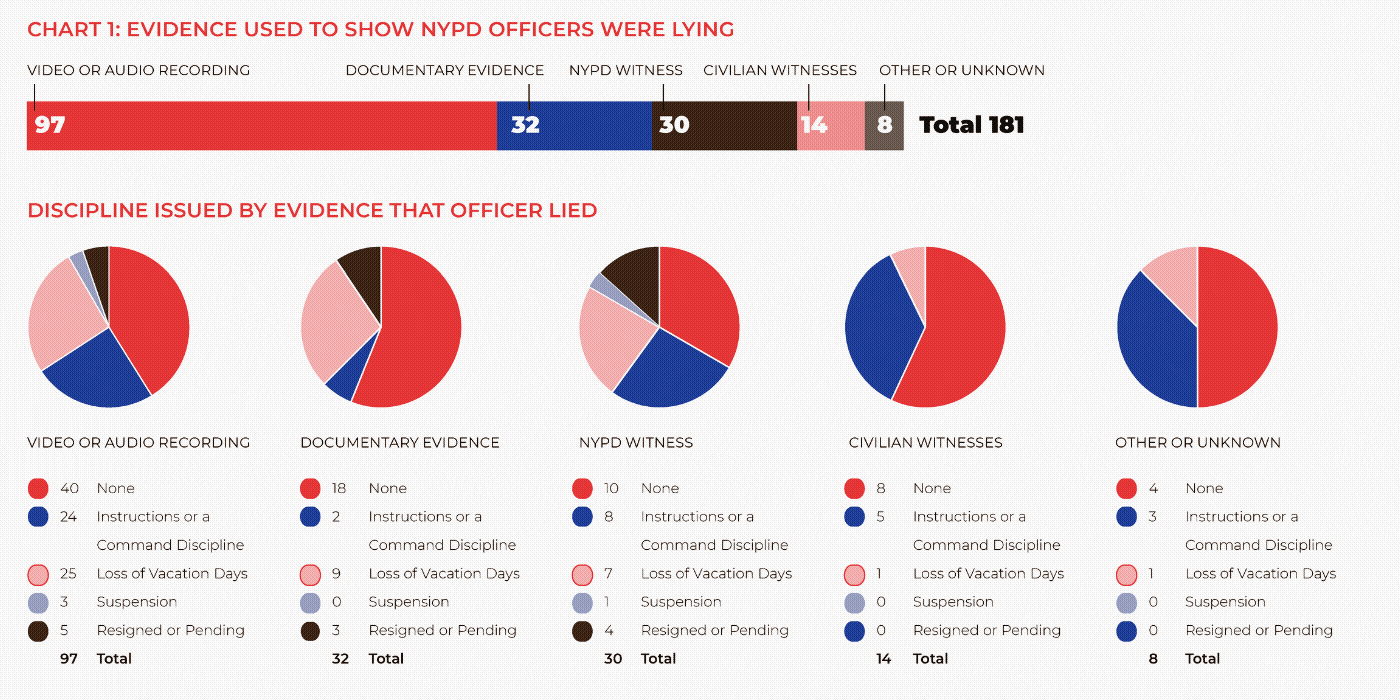
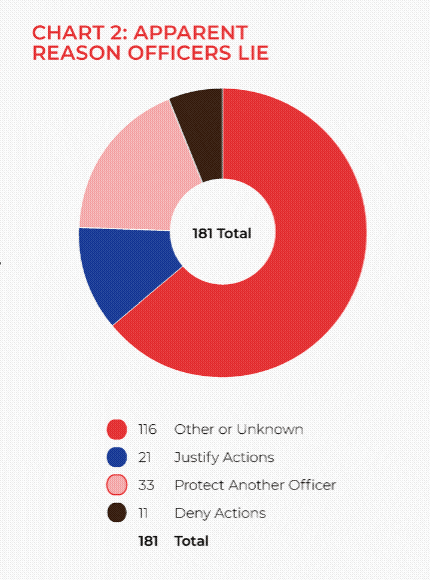 By reviewing case files, LatinoJustice was able to determine the nature of the lies in 170 of the 181 instances. Unsurprisingly, most of the time—in 116 cases—the officer simply denied what he or she had been accused of doing or denied even being at the scene. Thirty-three officers admitted what they had done but lied to create a justification for doing so. And twenty-one of the 181 officers lied simply to protect another officer, often without being accused of any misconduct themselves.
By reviewing case files, LatinoJustice was able to determine the nature of the lies in 170 of the 181 instances. Unsurprisingly, most of the time—in 116 cases—the officer simply denied what he or she had been accused of doing or denied even being at the scene. Thirty-three officers admitted what they had done but lied to create a justification for doing so. And twenty-one of the 181 officers lied simply to protect another officer, often without being accused of any misconduct themselves.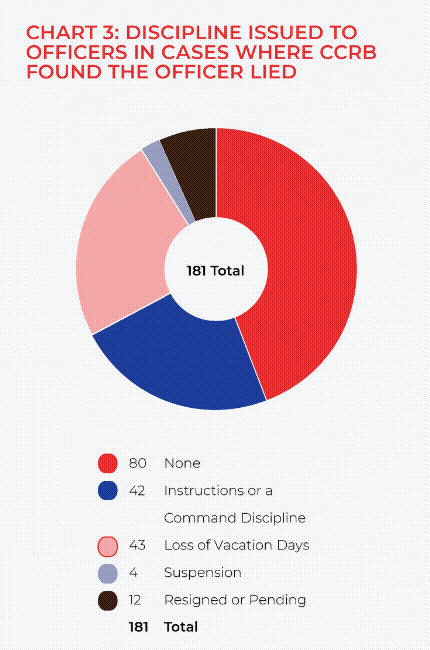 When the CCRB forwards a case to the NYPD with a recommendation that there is evidence that an officer made a false official statement, the NYPD “re-investigates” the alleged false statement allegation. The NYPD does not report publicly on its conclusions nor does it report them on the database that purports to show the outcome of all CCRB cases.
When the CCRB forwards a case to the NYPD with a recommendation that there is evidence that an officer made a false official statement, the NYPD “re-investigates” the alleged false statement allegation. The NYPD does not report publicly on its conclusions nor does it report them on the database that purports to show the outcome of all CCRB cases.